Kafka as a Platform: the Ecosystem from the Ground Up Robin Moffatt | #GOTOpia | @rmoff
Slide 1

Slide 2

$ whoami • Robin Moffatt (@rmoff) • Senior Developer Advocate at Confluent (Apache Kafka, not Wikis !) • Working in data & analytics since 2001 • Oracle ACE Director (Alumnus) http://rmoff.dev/talks · http://rmoff.dev/blog · http://rmoff.dev/youtube @rmoff | #GOTOpia | @confluentinc
Slide 3

EVENTS @rmoff | #GOTOpia | @confluentinc
Slide 4

EVENTS @rmoff | #GOTOpia | @confluentinc
Slide 5

• • EVENTS d e n e p p a h g n i h t e Som d e n e p p a h t a Wh
Slide 6

Human generated events A Sale A Stock movement @rmoff | #GOTOpia | @confluentinc
Slide 7

Machine generated events IoT Networking Applications @rmoff | #GOTOpia | @confluentinc
Slide 8

EVENTS are EVERYWHERE @rmoff | #GOTOpia | @confluentinc
Slide 9

EVENTS y r e v ^ are POWERFUL @rmoff | #GOTOpia | @confluentinc
Slide 10

Slide 11

Slide 12

K V
Slide 13

LOG @rmoff | #GOTOpia | @confluentinc
Slide 14

K V
Slide 15

K V
Slide 16

K V
Slide 17

K V
Slide 18

K V
Slide 19

K V
Slide 20

K V
Slide 21

Immutable Event Log Old New Events are added at the end of the log @rmoff | #GOTOpia | @confluentinc
Slide 22

TOPICS @rmoff | #GOTOpia | @confluentinc
Slide 23

Topics Clicks Orders Customers Topics are similar in concept to tables in a database @rmoff | #GOTOpia | @confluentinc
Slide 24

PARTITIONS @rmoff | #GOTOpia | @confluentinc
Slide 25

Partitions Clicks p0 P1 P2 Messages are guaranteed to be strictly ordered within a partition @rmoff | #GOTOpia | @confluentinc
Slide 26

PUB / SUB @rmoff | #GOTOpia | @confluentinc
Slide 27

PUB / SUB @rmoff | #GOTOpia | @confluentinc
Slide 28

Producing data Old New Messages are added at the end of the log @rmoff | #GOTOpia | @confluentinc
Slide 29

partition 0 … partition 1 producer … partition 2 … Partitioned Topic
Slide 30

try (KafkaProducer<String, Payment> producer = new KafkaProducer<String, Payment>(props)) { for (long i = 0; i < 10; i++) { final String orderId = “id” + Long.toString(i); final Payment payment = new Payment(orderId, 1000.00d); final ProducerRecord<String, Payment> record = new ProducerRecord<String, Payment>(“transactions”, payment.getId().toString(), payment); producer.send(record); } } catch (final InterruptedException e) { e.printStackTrace(); }
Slide 31

package main import ( “gopkg.in/confluentinc/confluent-kafka-go.v1/kafka” ) func main() { topic := “test_topic” p, _ := kafka.NewProducer(&kafka.ConfigMap{ “bootstrap.servers”: “localhost:9092”}) defer p.Close() p.Produce(&kafka.Message{ TopicPartition: kafka.TopicPartition{Topic: &topic, Partition: 0}, Value: []byte(“Hello world”)}, nil) }
Slide 32

Producing to Kafka - No Key Time Partition 1 Partition 2 Partition 3 Messages will be produced in a round robin fashion Partition 4 @rmoff | #GOTOpia | @confluentinc
Slide 33

Producing to Kafka - With Key Time Partition 1 A Partition 2 B hash(key) % numPartitions = N Partition 3 C Partition 4 D @rmoff | #GOTOpia | @confluentinc
Slide 34

Producers partition 0 … partition 1 producer … partition 2 … Partitioned Topic • A client application • Puts messages into topics • Handles partitioning, network protocol • Java, Go, .NET, C/C++, Python • Also every other language Plus REST proxy if not
Slide 35

PUB / SUB @rmoff | #GOTOpia | @confluentinc
Slide 36

Consuming data - access is only sequential Read to offset & scan Old New @rmoff | #GOTOpia | @confluentinc
Slide 37

Consumers have a position of their own Old New Sally is here @rmoff | Scan #GOTOpia | @confluentinc
Slide 38

Consumers have a position of their own Old New Fred is here Sally is here Scan @rmoff | Scan #GOTOpia | @confluentinc
Slide 39

Consumers have a position of their own Rick is here Scan Old New Fred is here Sally is here Scan @rmoff | Scan #GOTOpia | @confluentinc
Slide 40

try (final KafkaConsumer<String, Payment> consumer = new KafkaConsumer<>(props)) { consumer.subscribe(Collections.singletonList(TOPIC)); while (true) { ConsumerRecords<String, Payment> records = consumer.poll(100); for (ConsumerRecord<String, Payment> record : records) { String key = record.key(); Payment value = record.value(); System.out.printf(“key = %s, value = %s%n”, key, value); } } }
Slide 41

c, _ := kafka.NewConsumer(&cm) defer c.Close() c.Subscribe(topic, nil) for { select { case ev := <-c.Events(): switch ev.(type) { case *kafka.Message: km := ev.(*kafka.Message) fmt.Printf(“✅ Message ‘%v’ received from topic ‘%v’\n”, string(km.Value), string(*km.TopicPartition.Topic)) } } }
Slide 42

Consuming From Kafka - Single Consumer Partition 1 Partition 2 C Partition 3 Partition 4 @rmoff | #GOTOpia | @confluentinc
Slide 43

Consuming From Kafka - Multiple Consumers Partition 1 C1 Partition 2 Partition 3 C2 Partition 4 @rmoff | #GOTOpia | @confluentinc
Slide 44

Consuming From Kafka - Multiple Consumers C1 Partition 1 Partition 2 Partition 3 C2 Partition 4 @rmoff | #GOTOpia | @confluentinc
Slide 45

Consuming From Kafka - Grouped Consumers CC1 1 CC1 1 Partition 1 Partition 2 Partition 3 C2 Partition 4 @rmoff | #GOTOpia | @confluentinc
Slide 46

CONSUMERS CONSUMER GROUP COORDINATOR CONSUMER GROUP
Slide 47

Consuming From Kafka - Grouped Consumers Partition 1 Partition 2 Partition 3 C1 C2 C3 C4 Partition 4 @rmoff | #GOTOpia | @confluentinc
Slide 48

Consuming From Kafka - Grouped Consumers Partition 1 Partition 2 Partition 3 C1 C2 C3 3 #GOTOpia | Partition 4 @rmoff | @confluentinc
Slide 49

Consuming From Kafka - Grouped Consumers Partition 1 C1 Partition 2 Partition 3 C2 C3 Partition 4 @rmoff | #GOTOpia | @confluentinc
Slide 50

Consumers partition 0 … partition 1 … consumer A consumer A consumer A partition 2 … Partitioned Topic consumer B • A client application • Reads messages from topics • Horizontally, elastically scalable (if stateless) • Java, Go, .NET, C/C++, Python, everything else Plus REST proxy if not
Slide 51

BROKERS and REPLICATION @rmoff | #GOTOpia | @confluentinc
Slide 52

Leader Partition Leadership and Replication Follower Partition 1 Partition 2 Partition 3 Partition 4 Broker 1 Broker 2 Broker 3 @rmoff | #GOTOpia | @confluentinc
Slide 53

Leader Partition Leadership and Replication Follower Partition 1 Partition 1 Partition 1 Partition 2 Partition 2 Partition 2 Partition 3 Partition 3 Partition 3 Partition 4 Partition 4 Partition 4 Broker 1 Broker 2 Broker 3 @rmoff | #GOTOpia | @confluentinc
Slide 54

Leader Partition Leadership and Replication Follower Partition 1 Partition 1 Partition 1 Partition 2 Partition 2 Partition 2 Partition 3 Partition 3 Partition 3 Partition 4 Partition 4 Partition 4 Broker 1 Broker 2 Broker 3 @rmoff | #GOTOpia | @confluentinc
Slide 55

Photo by Raoul Droog on Unsplas DEMO @rmoff | #GOTOpia | @confluentinc
Slide 56

So far, this is Pretty good @rmoff | #GOTOpia | @confluentinc
Slide 57

So far, this is Pretty good but I’ve not finished yet… @rmoff | #GOTOpia | @confluentinc
Slide 58

Streaming Pipelines Amazon S3 RDBMS HDFS @rmoff | #GOTOpia | @confluentinc
Slide 59

Evolve processing from old systems to new Existing New App <x> App RDBMS @rmoff | #GOTOpia | @confluentinc
Slide 60

Slide 61

Streaming Integration with Kafka Connect syslog Sources Kafka Connect @rmoff | Kafka Brokers #GOTOpia | @confluentinc
Slide 62

Streaming Integration with Kafka Connect Amazon Sinks Google Kafka Connect @rmoff | Kafka Brokers #GOTOpia | @confluentinc
Slide 63

Streaming Integration with Kafka Connect Amazon syslog Google Kafka Connect @rmoff | Kafka Brokers #GOTOpia | @confluentinc
Slide 64

Look Ma, No Code! { “connector.class”: “io.confluent.connect.jdbc.JdbcSourceConnector”, “connection.url”: “jdbc:mysql://asgard:3306/demo”, “table.whitelist”: “sales,orders,customers” } @rmoff | #GOTOpia | @confluentinc
Slide 65

Extensible Connector Transform(s) @rmoff Converter | #GOTOpia | @confluentinc
Slide 66

hub.confluent.io @rmoff | #GOTOpia | @confluentinc
Slide 67

Fault-tolerant? Nope. Kafka Connect Standalone Worker S3 Task #1 JDBC Task #1 JDBC Task #2 Offsets Worker @rmoff | #GOTOpia | @confluentinc
Slide 68

Fault-tolerant? Yeah! Kafka Connect Distributed Worker S3 Task #1 JDBC Task #1 JDBC Task #2 Kafka Connect cluster Worker Offsets Config Status @rmoff | #GOTOpia | @confluentinc
Slide 69

Fault-tolerant? Yeah! Scaling the Distributed Worker S3 Task #1 JDBC Task #1 Kafka Connect cluster JDBC Task #2 Worker Worker Offsets Config Status @rmoff | #GOTOpia | @confluentinc
Slide 70

Schema Registry @rmoff | #GOTOpia | @confluentinc
Slide 71

K V
Slide 72

K V
Slide 73

K V
Slide 74

K V
Slide 75

K V ? s i h t s ’ t a h w … t i a W
Slide 76

How do you serialise your data? JSON Avro Protobuf Schema JSON CSV @rmoff | #GOTOpia | @confluentinc
Slide 77

APIs are contracts between services {user_id: 53, address: “2 Elm st.”} Profile service Quote service {user_id: 53, quote: 580} @rmoff | #GOTOpia | @confluentinc
Slide 78

But not all services {user_id: 53, address: “2 Elm st.”} Profile service Quote service {user_id: 53, quote: 580} @rmoff | #GOTOpia | @confluentinc
Slide 79

And naturally… {user_id: 53, address: “2 Elm st.”} Profile service Quote service Profile database @rmoff Stream processing | #GOTOpia | @confluentinc
Slide 80

Schemas are about how teams work together {user_id: 53, timestamp: 1497842472} new Date(timestamp) Profile service Quote service Profile database create table ( user_id number, timestamp number) @rmoff Stream processing | #GOTOpia | @confluentinc
Slide 81
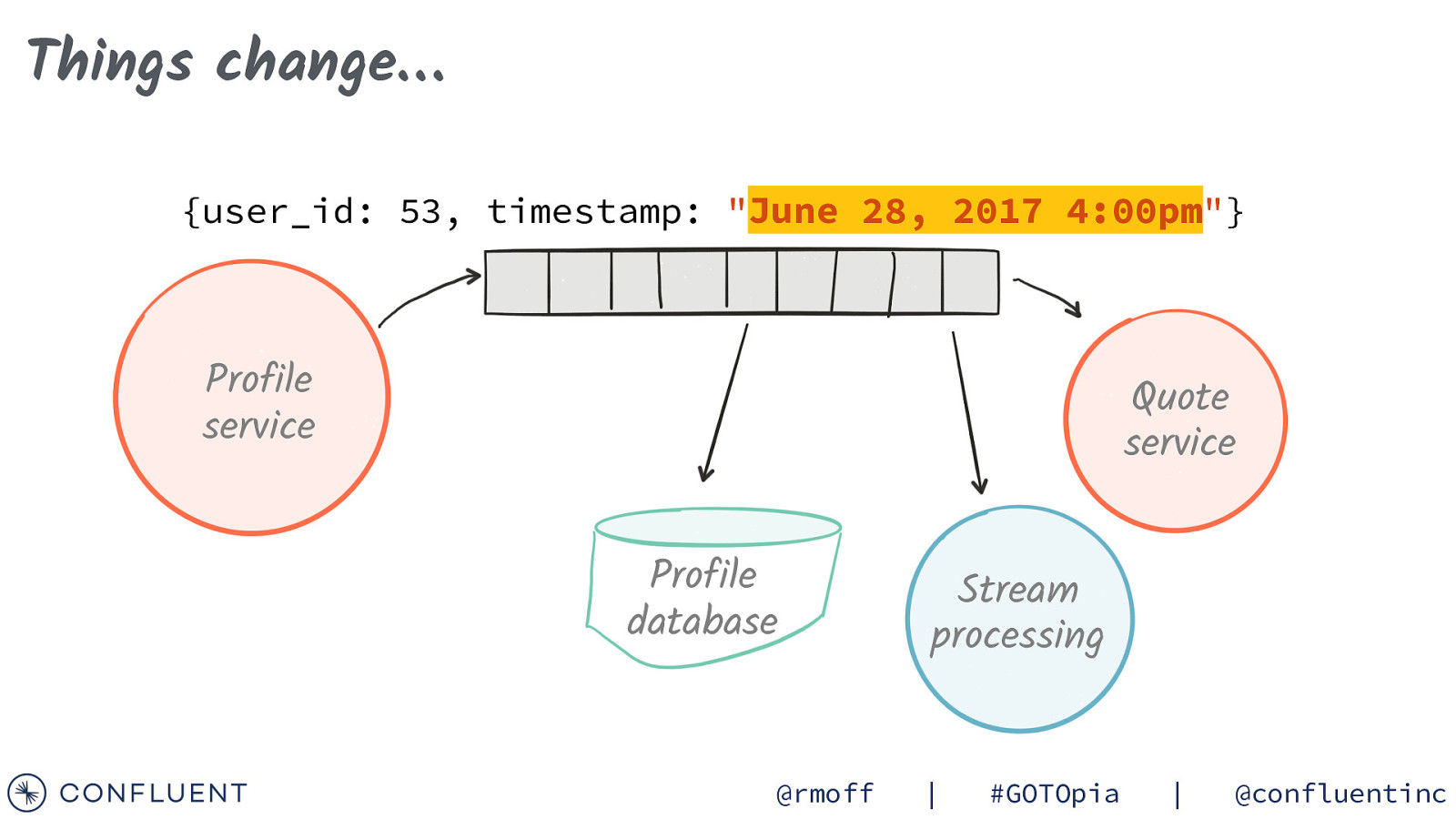
Things change… {user_id: 53, timestamp: “June 28, 2017 4:00pm”} Profile service Quote service Profile database @rmoff Stream processing | #GOTOpia | @confluentinc
Slide 82

Moving fast and breaking things {user_id: 53, timestamp: “June 28, 2017 4:00pm”} Profile service Quote service Profile database @rmoff Stream processing | #GOTOpia | @confluentinc
Slide 83

Lack of schemas – Coupling teams and services 2001 2001 Citrus Heights-Sunrise Blvd Citrus_Hghts 60670001 3400293 34 SAC Sacramento SV Sacramento Valley SAC Sacramento County APCD SMA8 Sacramento Metropolitan Area CA 6920 Sacramento 28 6920 13588 7400 Sunrise Blvd 95610 38 41 56 38.6988889 121 16 15.98999977 -121.271111 10 4284781 650345 52 @rmoff | #GOTOpia | @confluentinc
Slide 84

Serialisation & Schemas JSON Avro Protobuf Schema JSON CSV @rmoff | #GOTOpia | @confluentinc
Slide 85

Serialisation & Schemas JSON Avro Protobuf Schema JSON CSV #
$ https://rmoff.dev/qcon-schemas @rmoff | #GOTOpia | @confluentinc
Slide 86
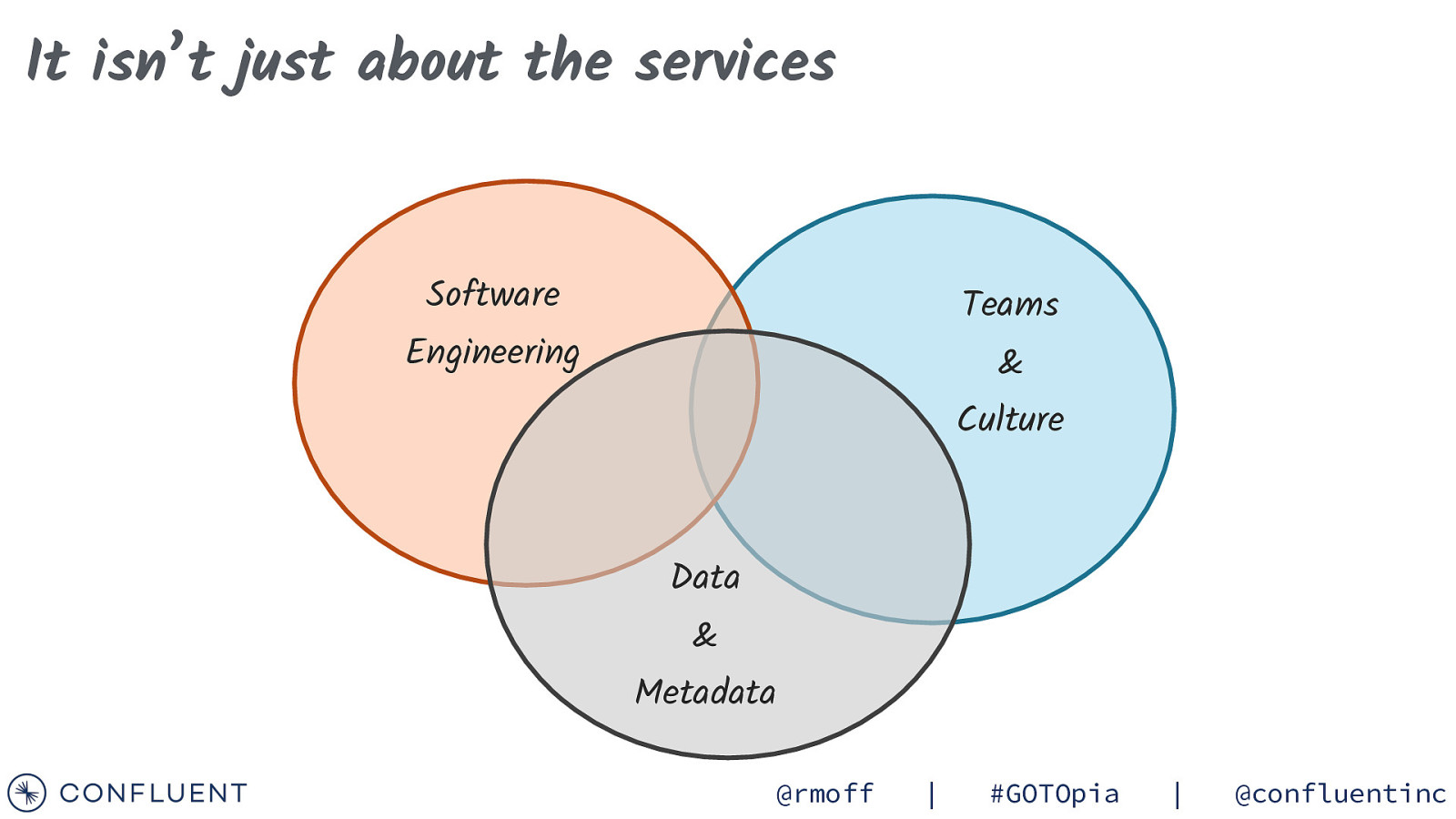
It isn’t just about the services Software Teams Engineering & Culture Data & Metadata @rmoff | #GOTOpia | @confluentinc
Slide 87
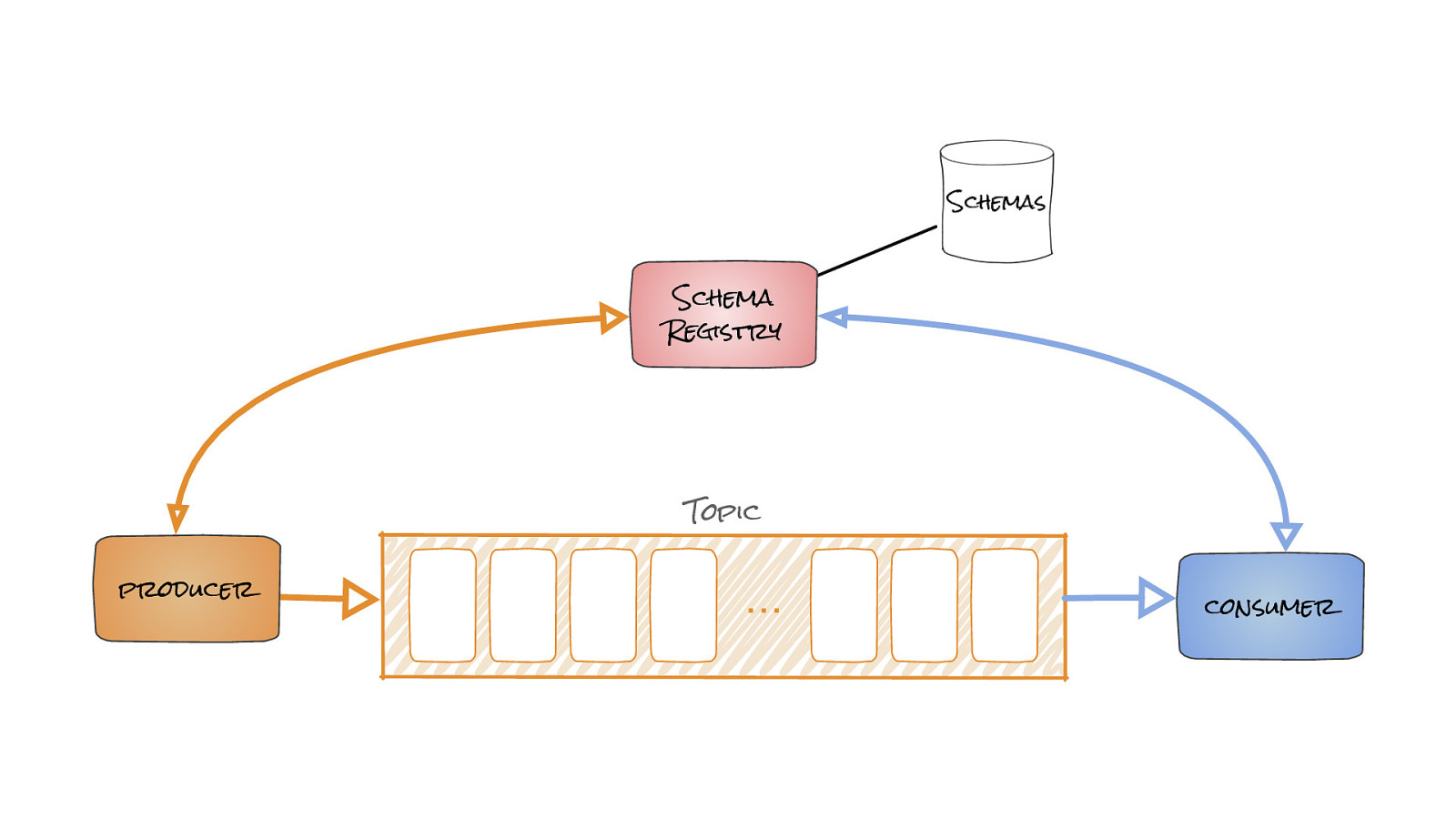
Schemas Schema Registry Topic producer … consumer
Slide 88
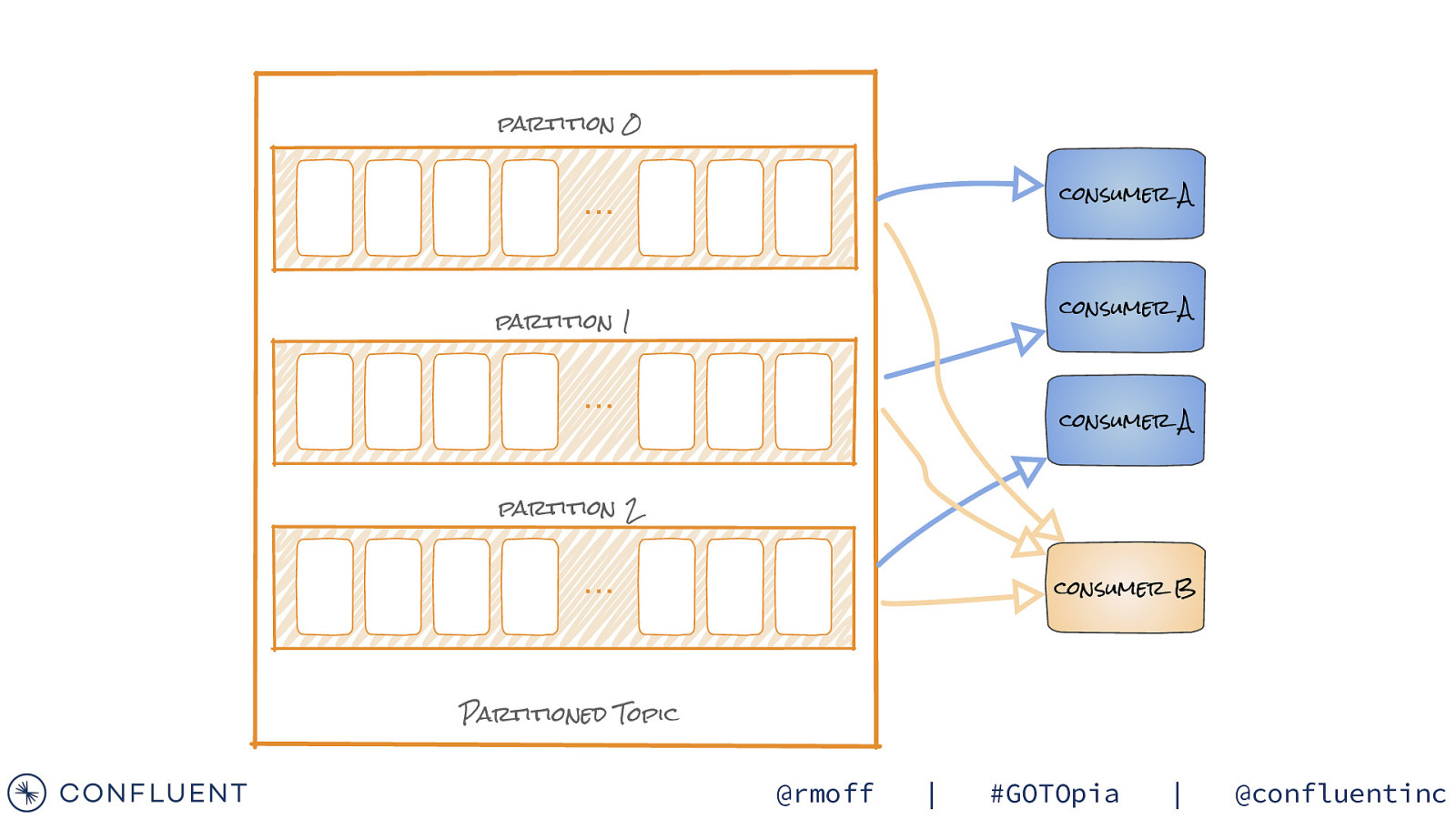
partition 0 consumer A … consumer A partition 1 … consumer A partition 2 … consumer B Partitioned Topic @rmoff | #GOTOpia | @confluentinc
Slide 89
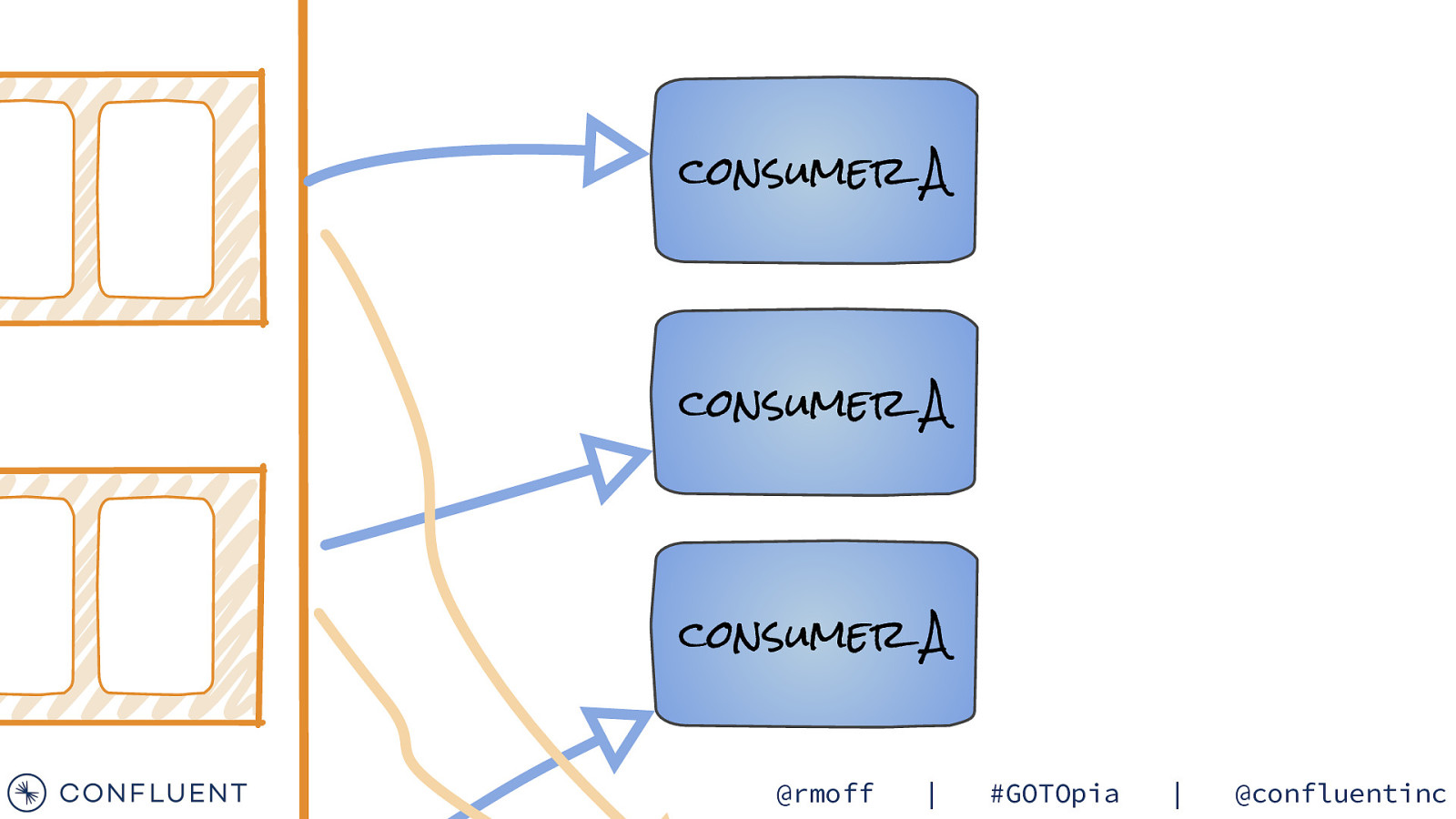
consumer A consumer A consumer A @rmoff | #GOTOpia | @confluentinc
Slide 90
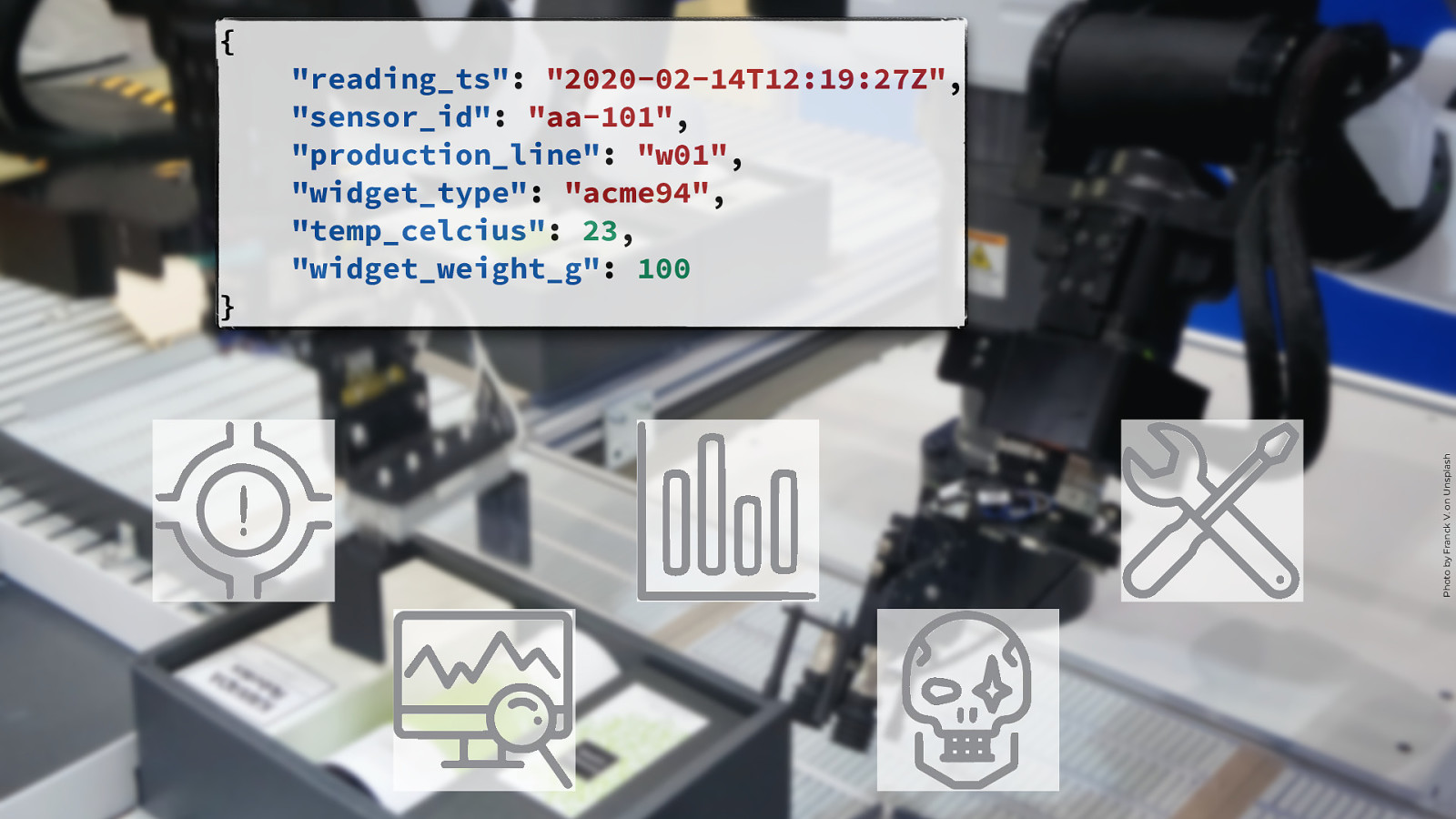
} “reading_ts”: “2020-02-14T12:19:27Z”, “sensor_id”: “aa-101”, “production_line”: “w01”, “widget_type”: “acme94”, “temp_celcius”: 23, “widget_weight_g”: 100 Photo by Franck V. on Unsplash { @rmoff | #GOTOpia | @confluentinc
Slide 91
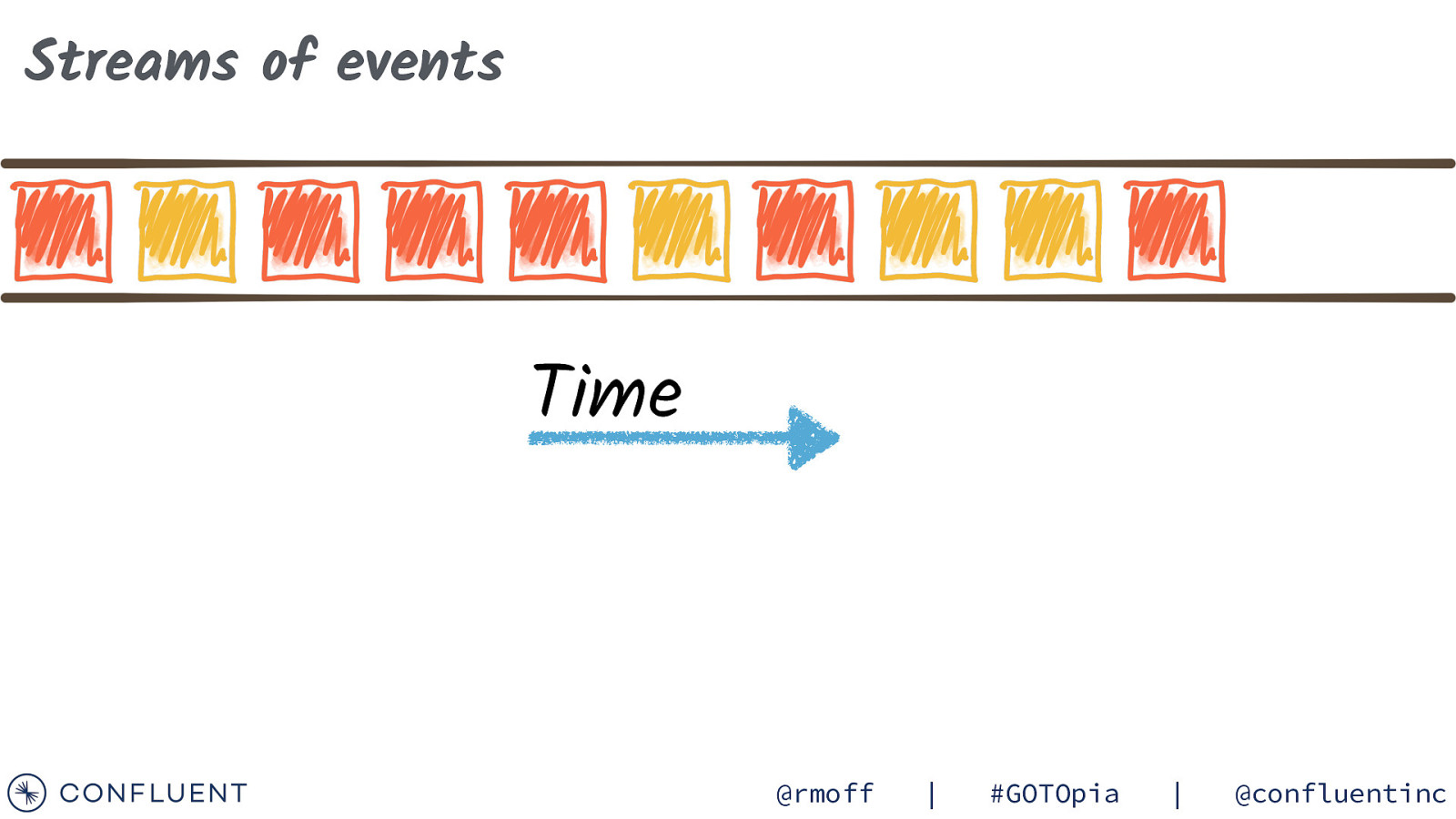
Streams of events Time @rmoff | #GOTOpia | @confluentinc
Slide 92
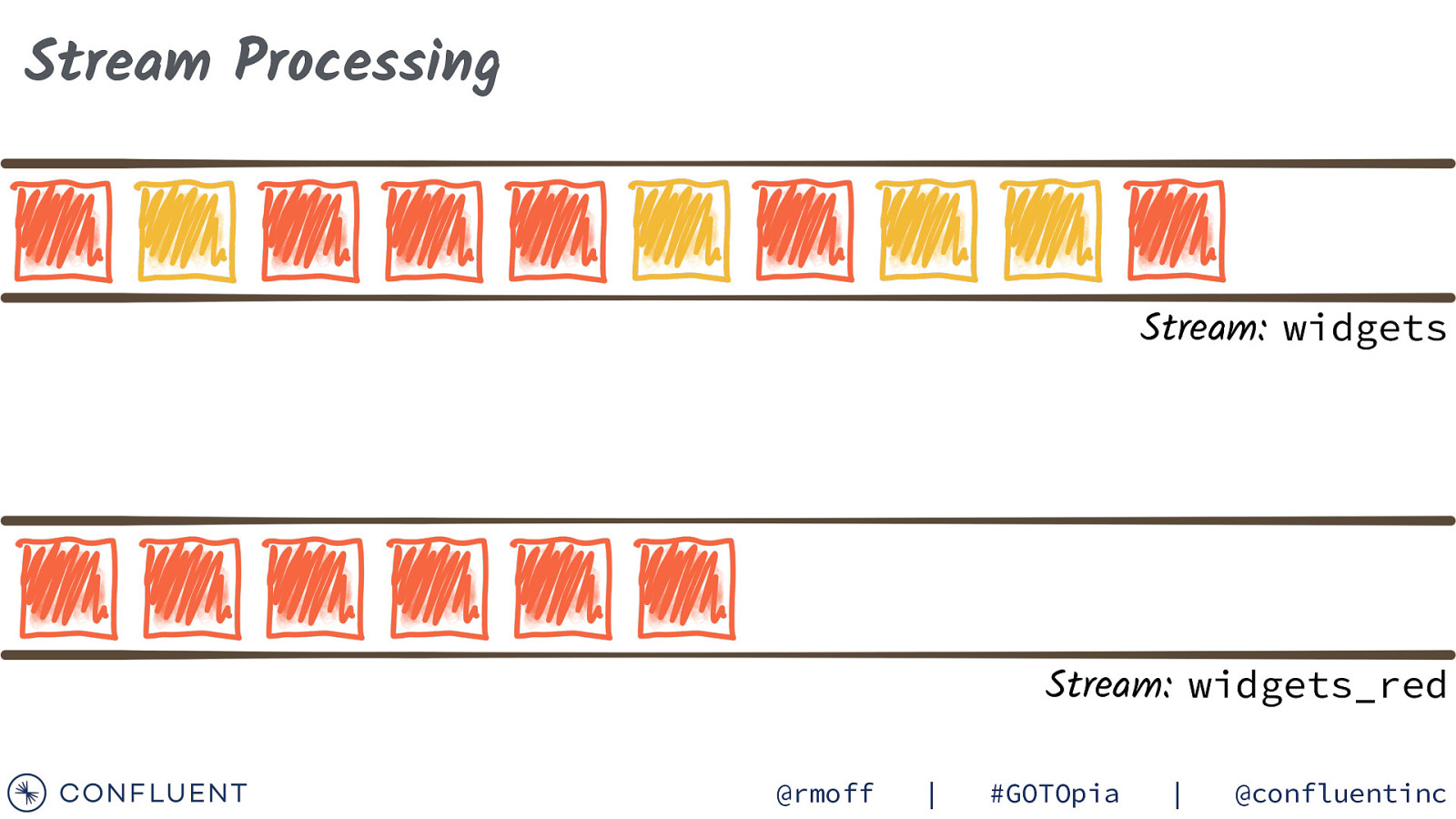
Stream Processing Stream: widgets Stream: widgets_red @rmoff | #GOTOpia | @confluentinc
Slide 93

Stream Processing with Kafka Streams Stream: widgets final StreamsBuilder builder = new StreamsBuilder() .stream(“widgets”, Consumed.with(stringSerde, widgetsSerde)) .filter( (key, widget) -> widget.getColour().equals(“RED”) ) .to(“widgets_red”, Produced.with(stringSerde, widgetsSerde)); Stream: widgets_red @rmoff | #GOTOpia | @confluentinc
Slide 94
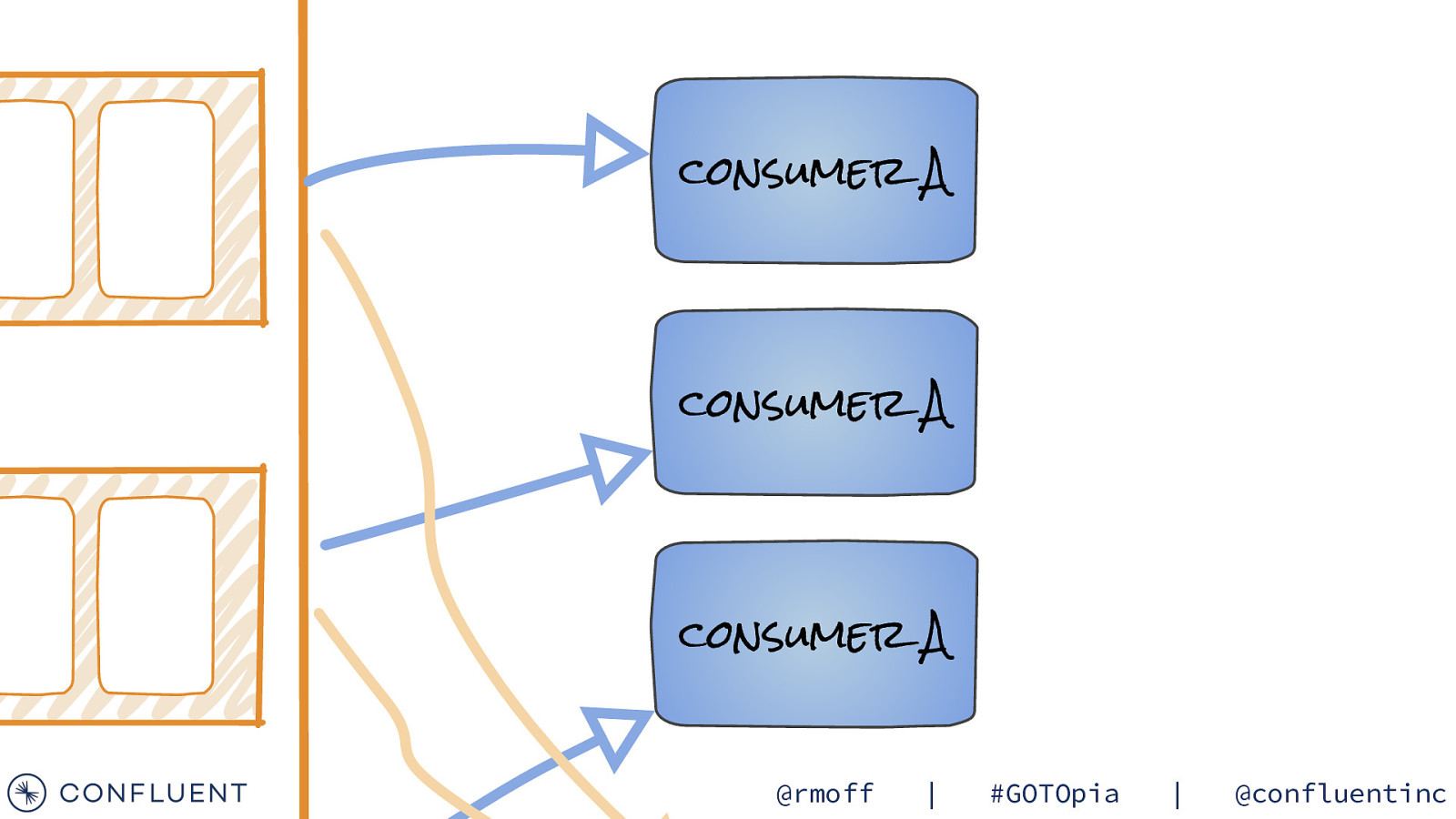
consumer A consumer A consumer A @rmoff | #GOTOpia | @confluentinc
Slide 95
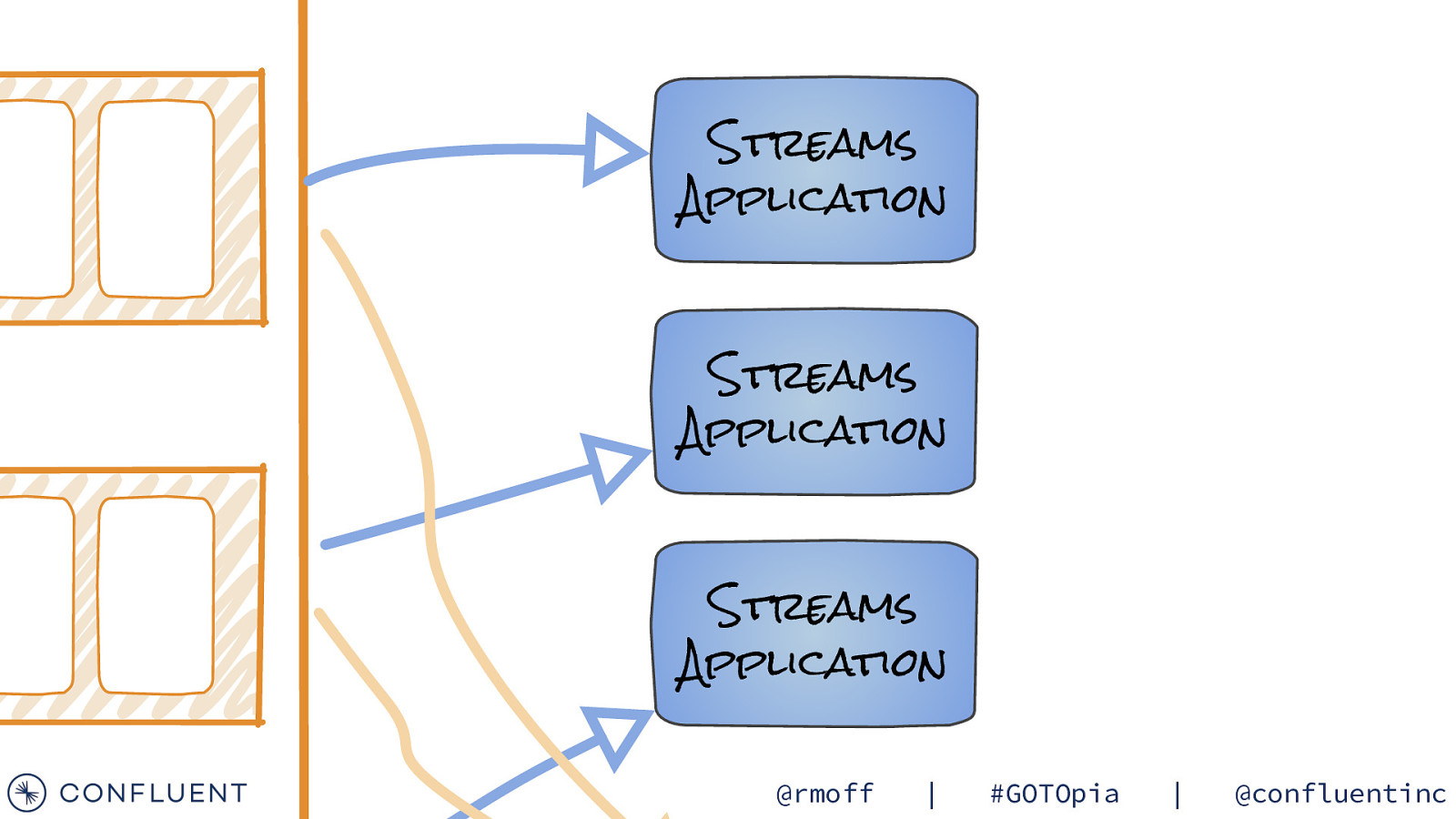
Streams Application Streams Application Streams Application @rmoff | #GOTOpia | @confluentinc
Slide 96
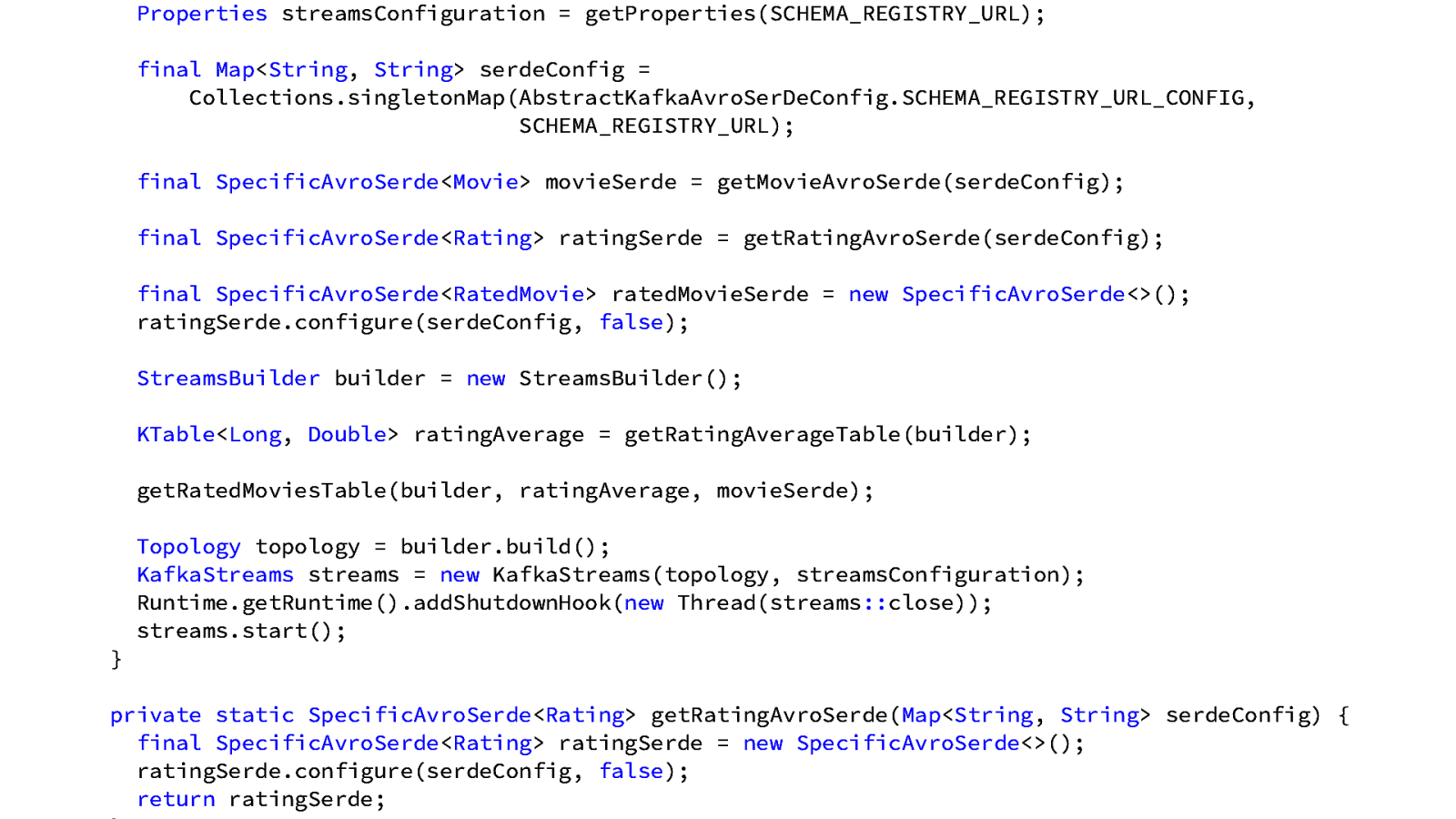
Properties streamsConfiguration = getProperties(SCHEMA_REGISTRY_URL); final Map<String, String> serdeConfig = Collections.singletonMap(AbstractKafkaAvroSerDeConfig.SCHEMA_REGISTRY_URL_CONFIG, SCHEMA_REGISTRY_URL); final SpecificAvroSerde<Movie> movieSerde = getMovieAvroSerde(serdeConfig); final SpecificAvroSerde<Rating> ratingSerde = getRatingAvroSerde(serdeConfig); final SpecificAvroSerde<RatedMovie> ratedMovieSerde = new SpecificAvroSerde<>(); ratingSerde.configure(serdeConfig, false); StreamsBuilder builder = new StreamsBuilder(); KTable<Long, Double> ratingAverage = getRatingAverageTable(builder); getRatedMoviesTable(builder, ratingAverage, movieSerde); Topology topology = builder.build(); KafkaStreams streams = new KafkaStreams(topology, streamsConfiguration); Runtime.getRuntime().addShutdownHook(new Thread(streams::close)); streams.start(); } private static SpecificAvroSerde<Rating> getRatingAvroSerde(Map<String, String> serdeConfig) { final SpecificAvroSerde<Rating> ratingSerde = new SpecificAvroSerde<>(); ratingSerde.configure(serdeConfig, false); return ratingSerde;
Slide 97
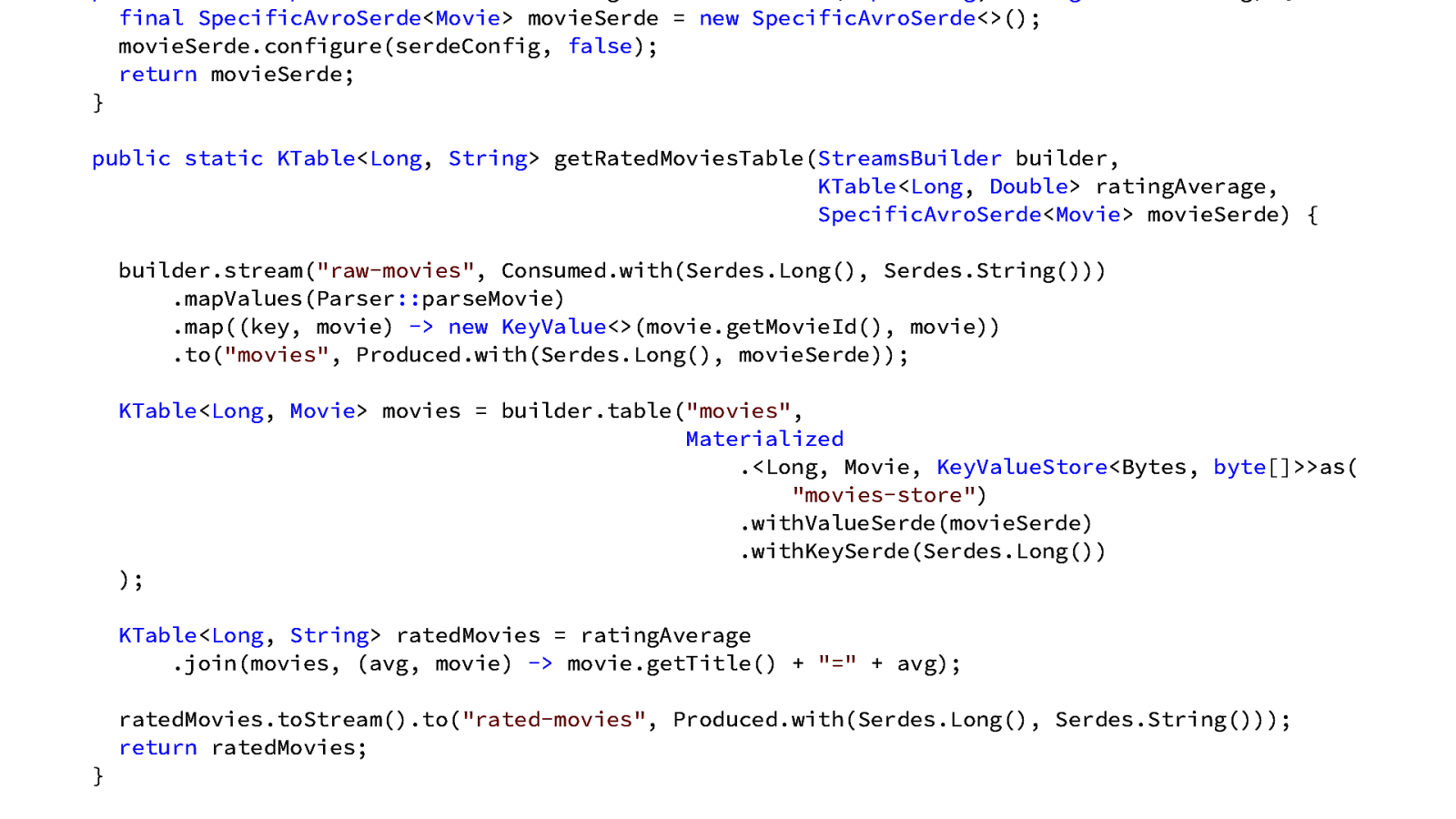
final SpecificAvroSerde<Movie> movieSerde = new SpecificAvroSerde<>(); movieSerde.configure(serdeConfig, false); return movieSerde; } public static KTable<Long, String> getRatedMoviesTable(StreamsBuilder builder, KTable<Long, Double> ratingAverage, SpecificAvroSerde<Movie> movieSerde) { builder.stream(“raw-movies”, Consumed.with(Serdes.Long(), Serdes.String())) .mapValues(Parser::parseMovie) .map((key, movie) -> new KeyValue<>(movie.getMovieId(), movie)) .to(“movies”, Produced.with(Serdes.Long(), movieSerde)); KTable<Long, Movie> movies = builder.table(“movies”, Materialized .<Long, Movie, KeyValueStore<Bytes, byte[]>>as( “movies-store”) .withValueSerde(movieSerde) .withKeySerde(Serdes.Long()) ); KTable<Long, String> ratedMovies = ratingAverage .join(movies, (avg, movie) -> movie.getTitle() + “=” + avg); ratedMovies.toStream().to(“rated-movies”, Produced.with(Serdes.Long(), Serdes.String())); return ratedMovies; }
Slide 98
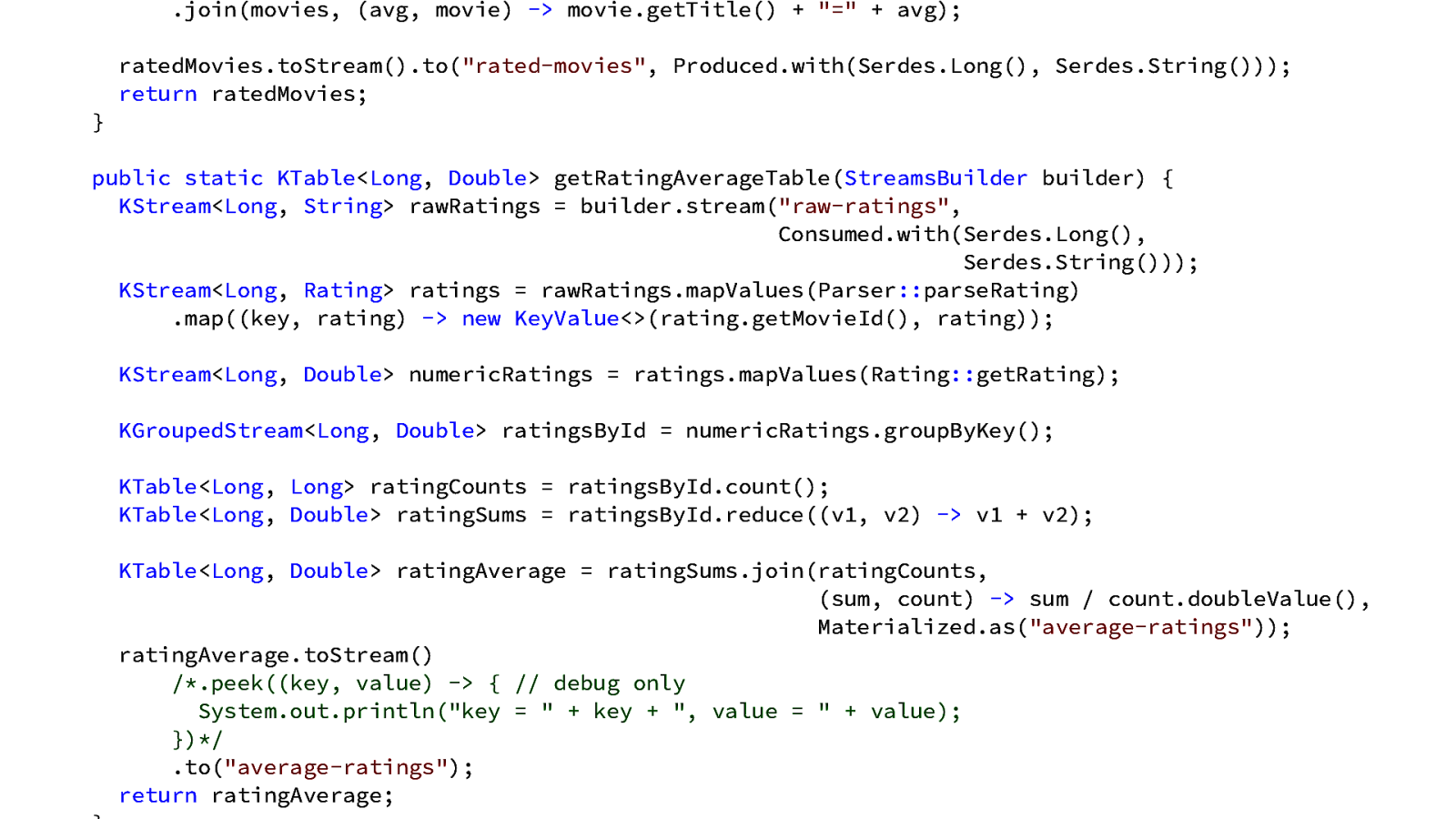
.join(movies, (avg, movie) -> movie.getTitle() + “=” + avg); ratedMovies.toStream().to(“rated-movies”, Produced.with(Serdes.Long(), Serdes.String())); return ratedMovies; } public static KTable<Long, Double> getRatingAverageTable(StreamsBuilder builder) { KStream<Long, String> rawRatings = builder.stream(“raw-ratings”, Consumed.with(Serdes.Long(), Serdes.String())); KStream<Long, Rating> ratings = rawRatings.mapValues(Parser::parseRating) .map((key, rating) -> new KeyValue<>(rating.getMovieId(), rating)); KStream<Long, Double> numericRatings = ratings.mapValues(Rating::getRating); KGroupedStream<Long, Double> ratingsById = numericRatings.groupByKey(); KTable<Long, Long> ratingCounts = ratingsById.count(); KTable<Long, Double> ratingSums = ratingsById.reduce((v1, v2) -> v1 + v2); KTable<Long, Double> ratingAverage = ratingSums.join(ratingCounts, (sum, count) -> sum / count.doubleValue(), Materialized.as(“average-ratings”)); ratingAverage.toStream() /.peek((key, value) -> { // debug only System.out.println(“key = ” + key + “, value = ” + value); })/ .to(“average-ratings”); return ratingAverage;
Slide 99
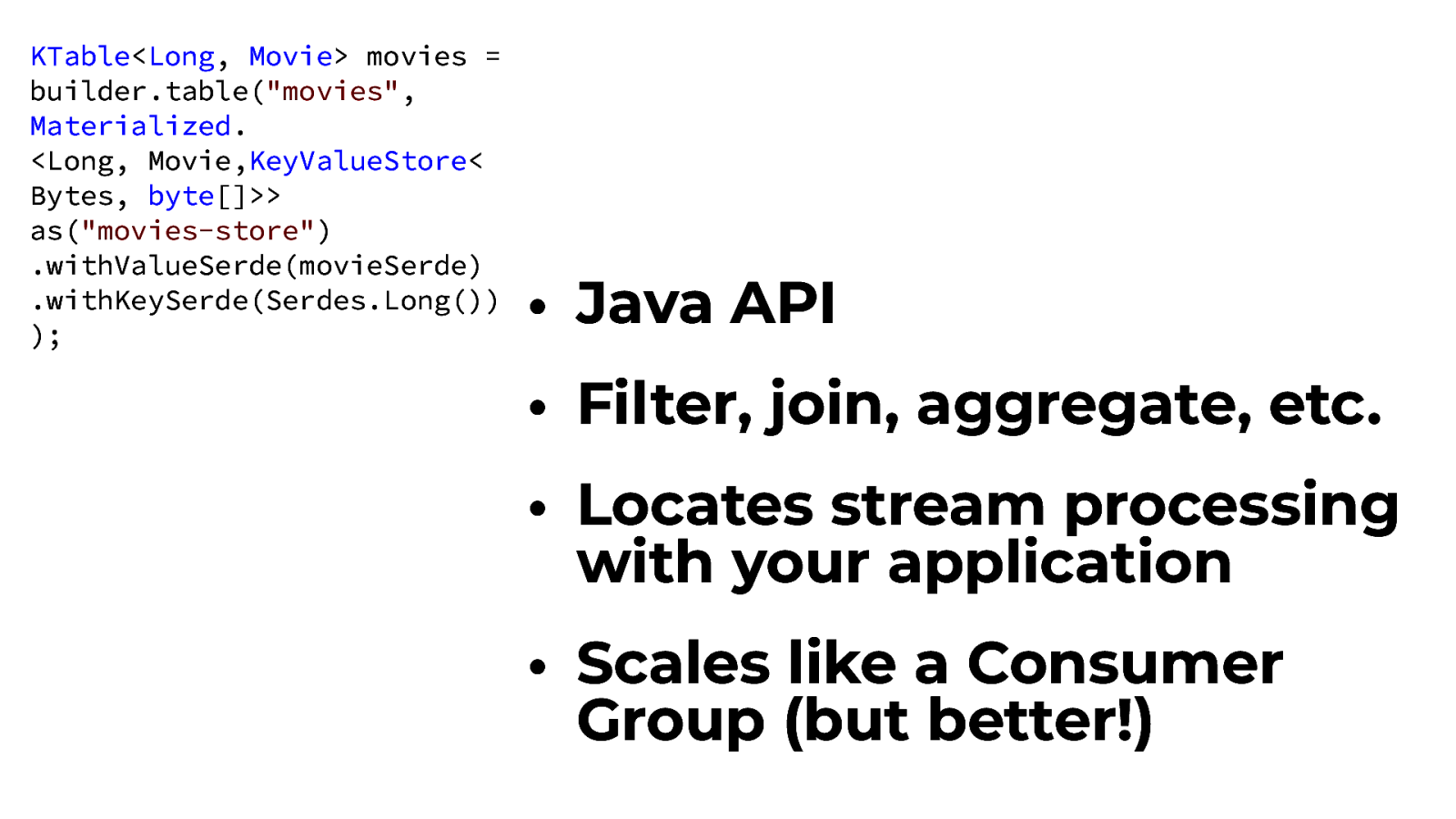
KTable<Long, Movie> movies = builder.table(“movies”, Materialized. <Long, Movie,KeyValueStore< Bytes, byte[]>> as(“movies-store”) .withValueSerde(movieSerde) .withKeySerde(Serdes.Long()) ); • Java API • Filter, join, aggregate, etc. • Locates stream processing with your application • Scales like a Consumer Group (but better!)
Slide 100
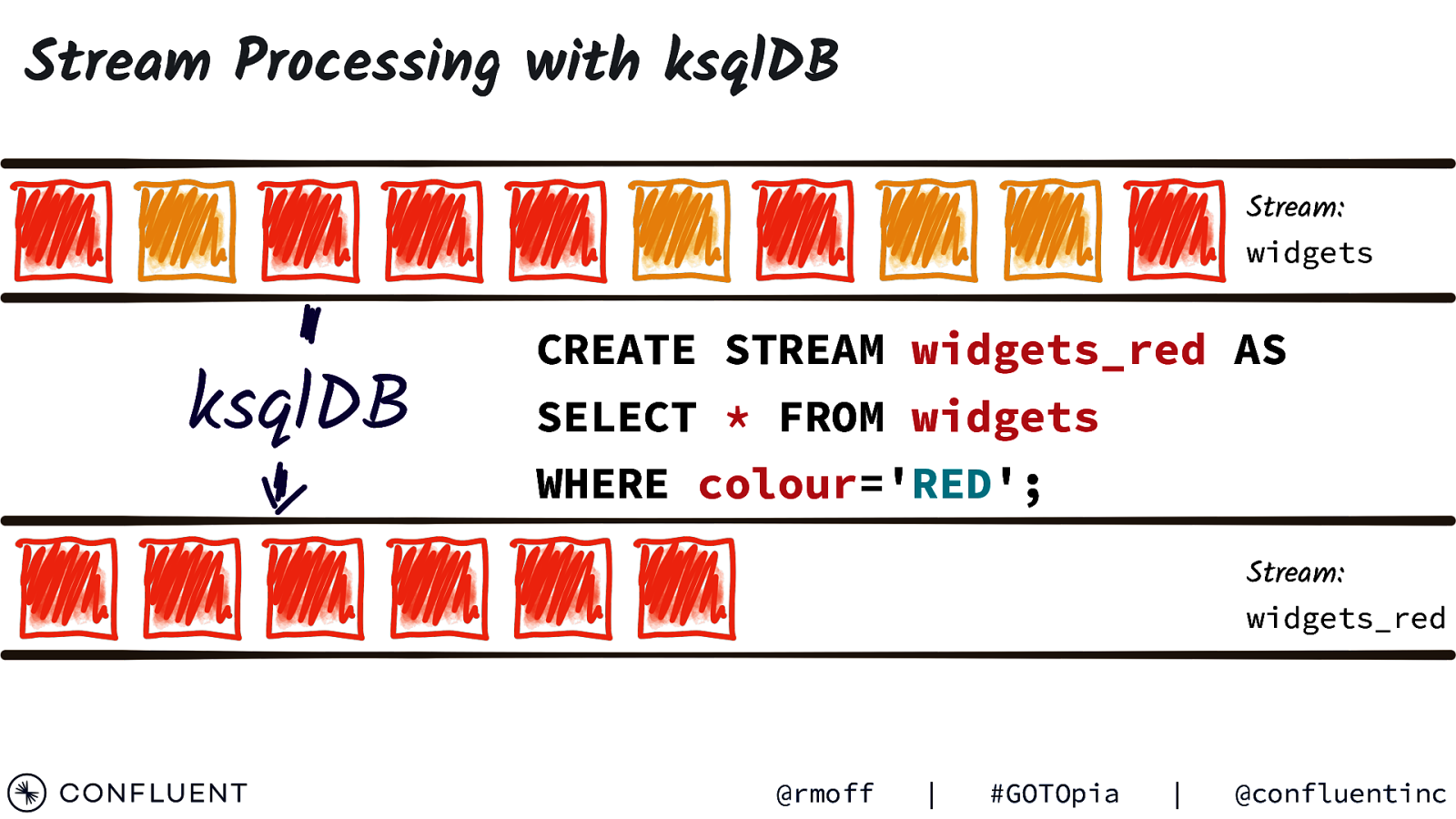
Stream Processing with ksqlDB Stream: widgets ksqlDB CREATE STREAM widgets_red AS SELECT * FROM widgets WHERE colour=’RED’; Stream: widgets_red @rmoff | #GOTOpia | @confluentinc
Slide 101
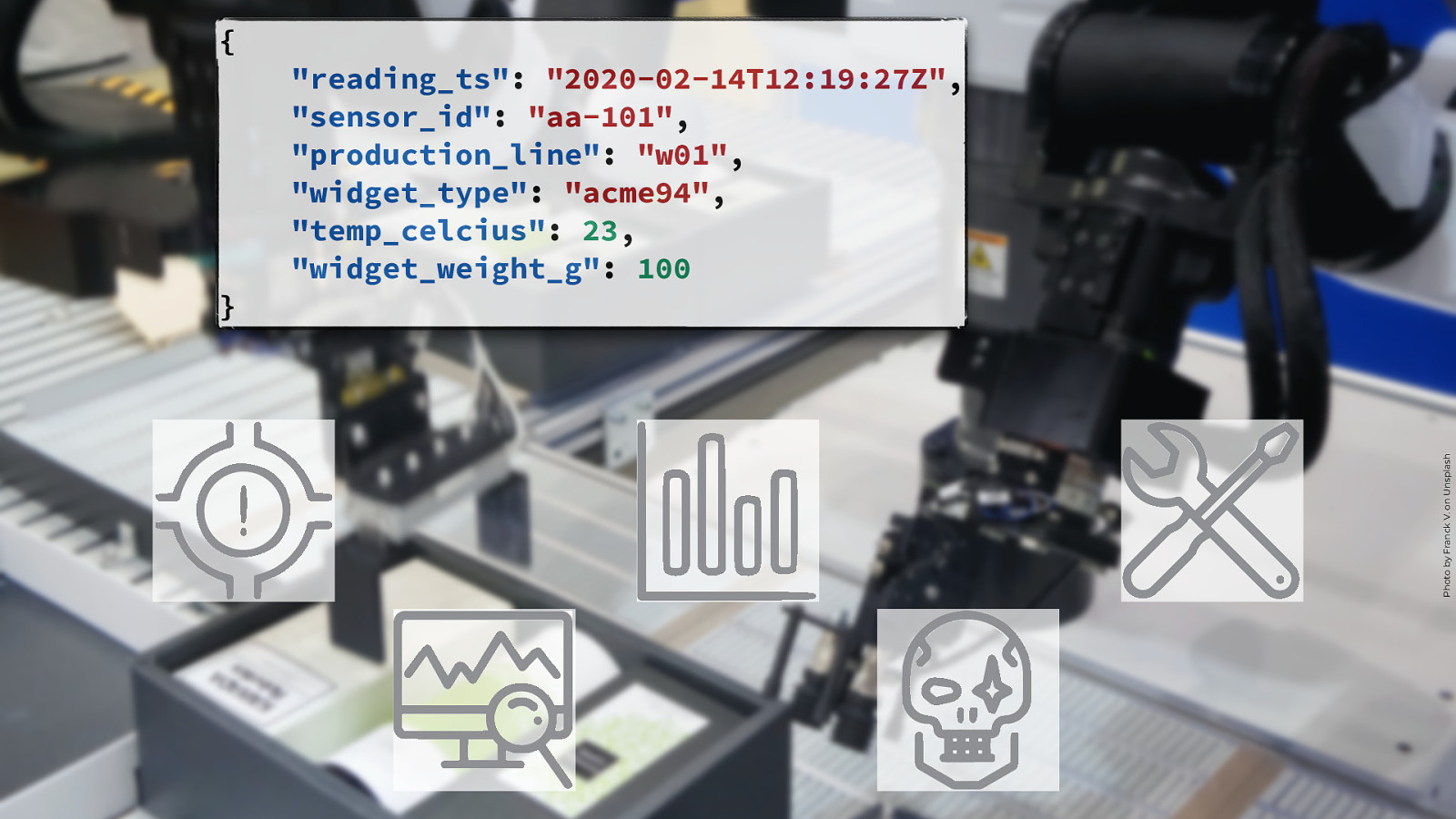
} “reading_ts”: “2020-02-14T12:19:27Z”, “sensor_id”: “aa-101”, “production_line”: “w01”, “widget_type”: “acme94”, “temp_celcius”: 23, “widget_weight_g”: 100 Photo by Franck V. on Unsplash { @rmoff | #GOTOpia | @confluentinc
Slide 102
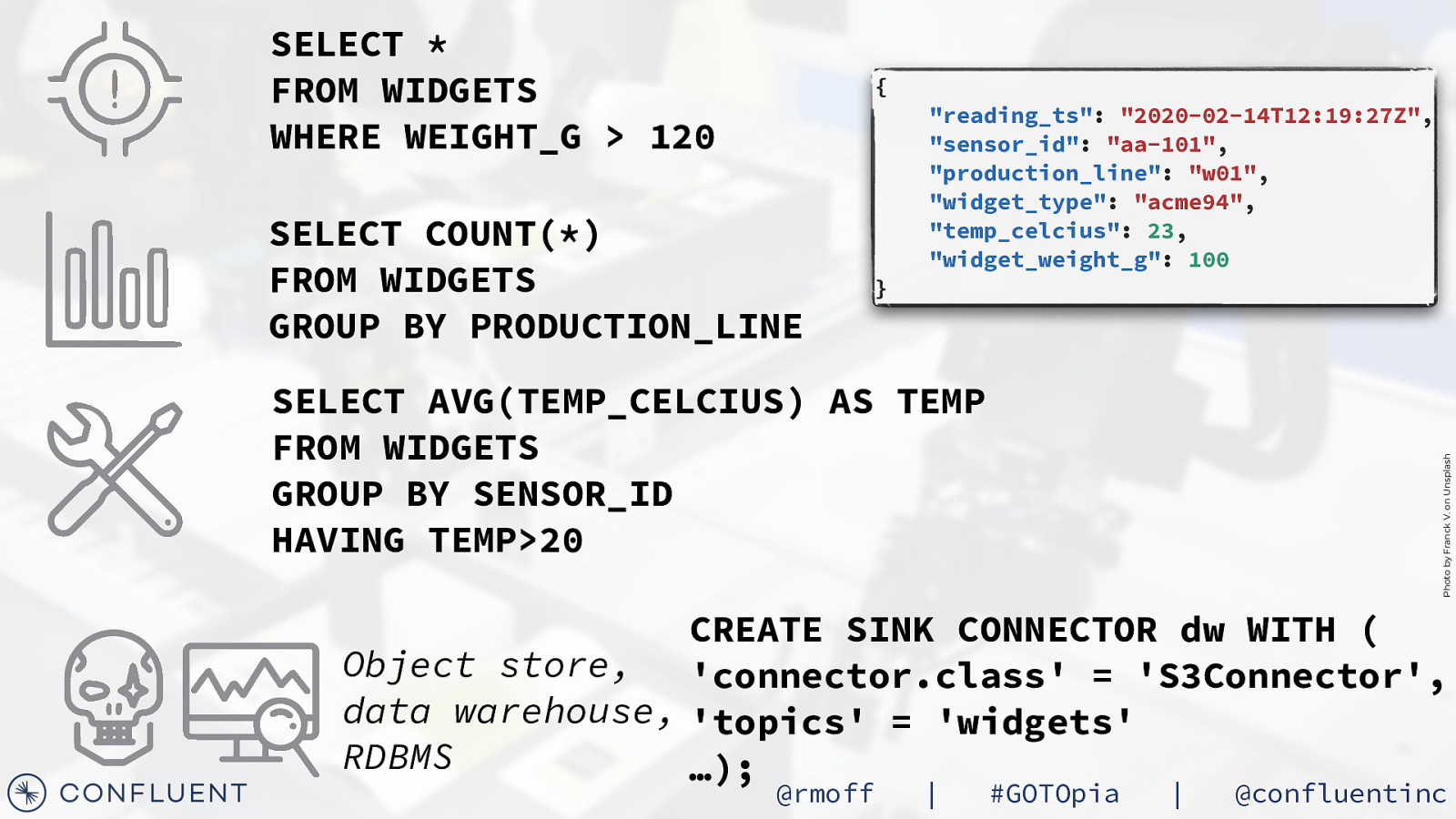
SELECT * FROM WIDGETS WHERE WEIGHT_G > 120 { SELECT COUNT(*) FROM WIDGETS GROUP BY PRODUCTION_LINE } “reading_ts”: “2020-02-14T12:19:27Z”, “sensor_id”: “aa-101”, “production_line”: “w01”, “widget_type”: “acme94”, “temp_celcius”: 23, “widget_weight_g”: 100 Photo by Franck V. on Unsplash SELECT AVG(TEMP_CELCIUS) AS TEMP FROM WIDGETS GROUP BY SENSOR_ID HAVING TEMP>20 CREATE SINK CONNECTOR dw WITH ( Object store, ‘connector.class’ = ‘S3Connector’, data warehouse, ‘topics’ = ‘widgets’ RDBMS …); @rmoff | #GOTOpia | @confluentinc
Slide 103
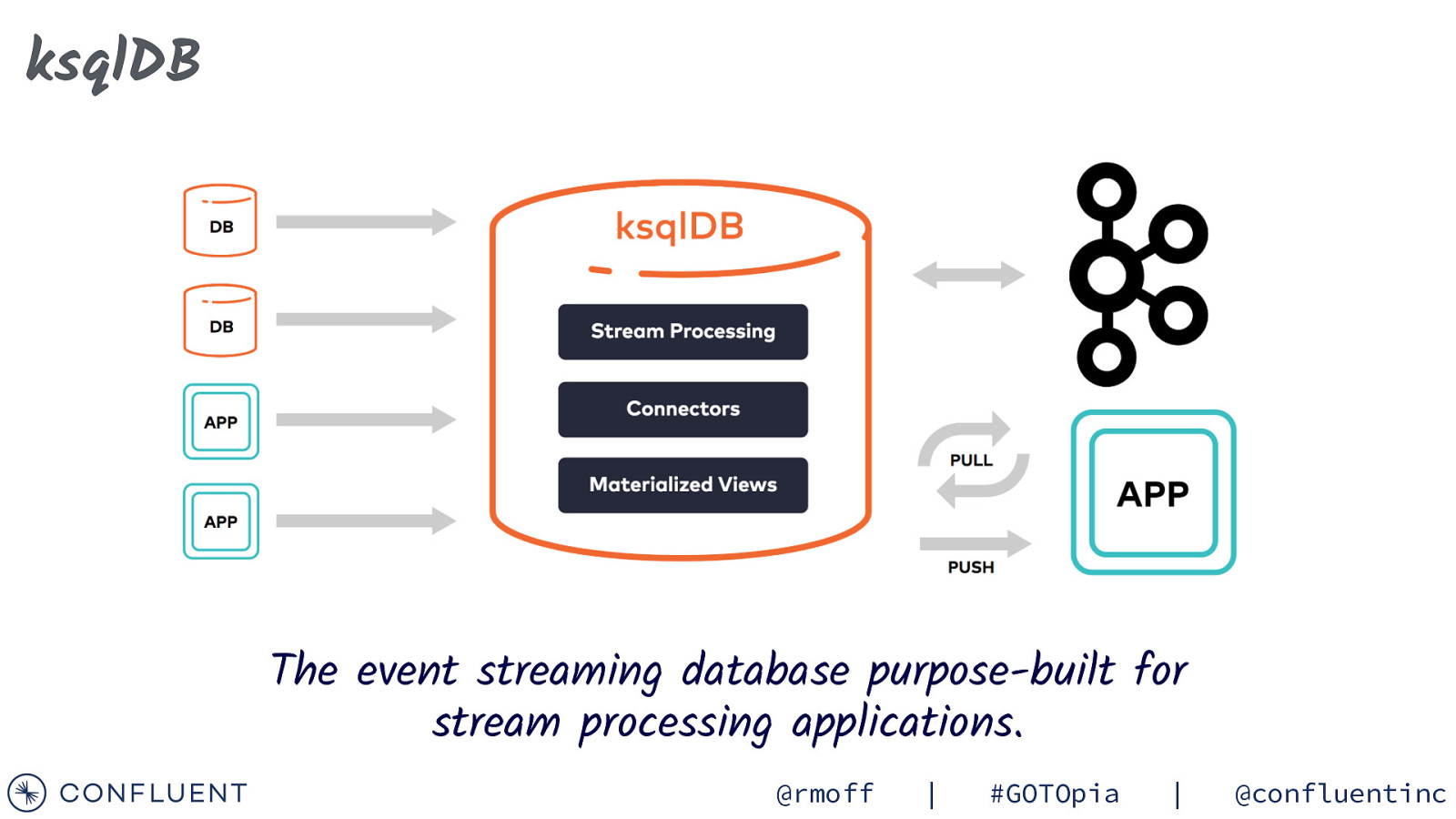
ksqlDB The event streaming database purpose-built for stream processing applications. @rmoff | #GOTOpia | @confluentinc
Slide 104
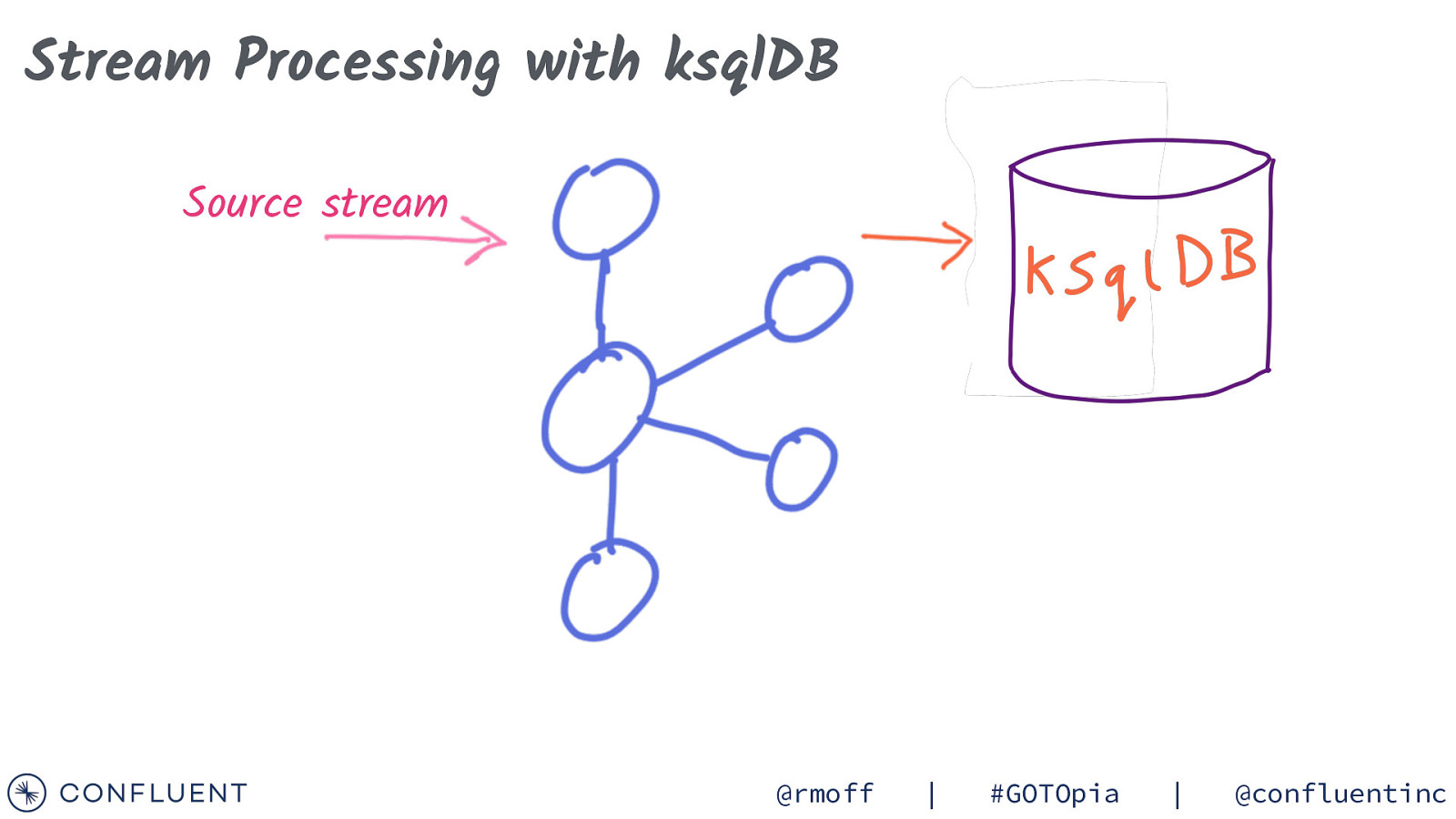
Stream Processing with ksqlDB Source stream @rmoff | #GOTOpia | @confluentinc
Slide 105
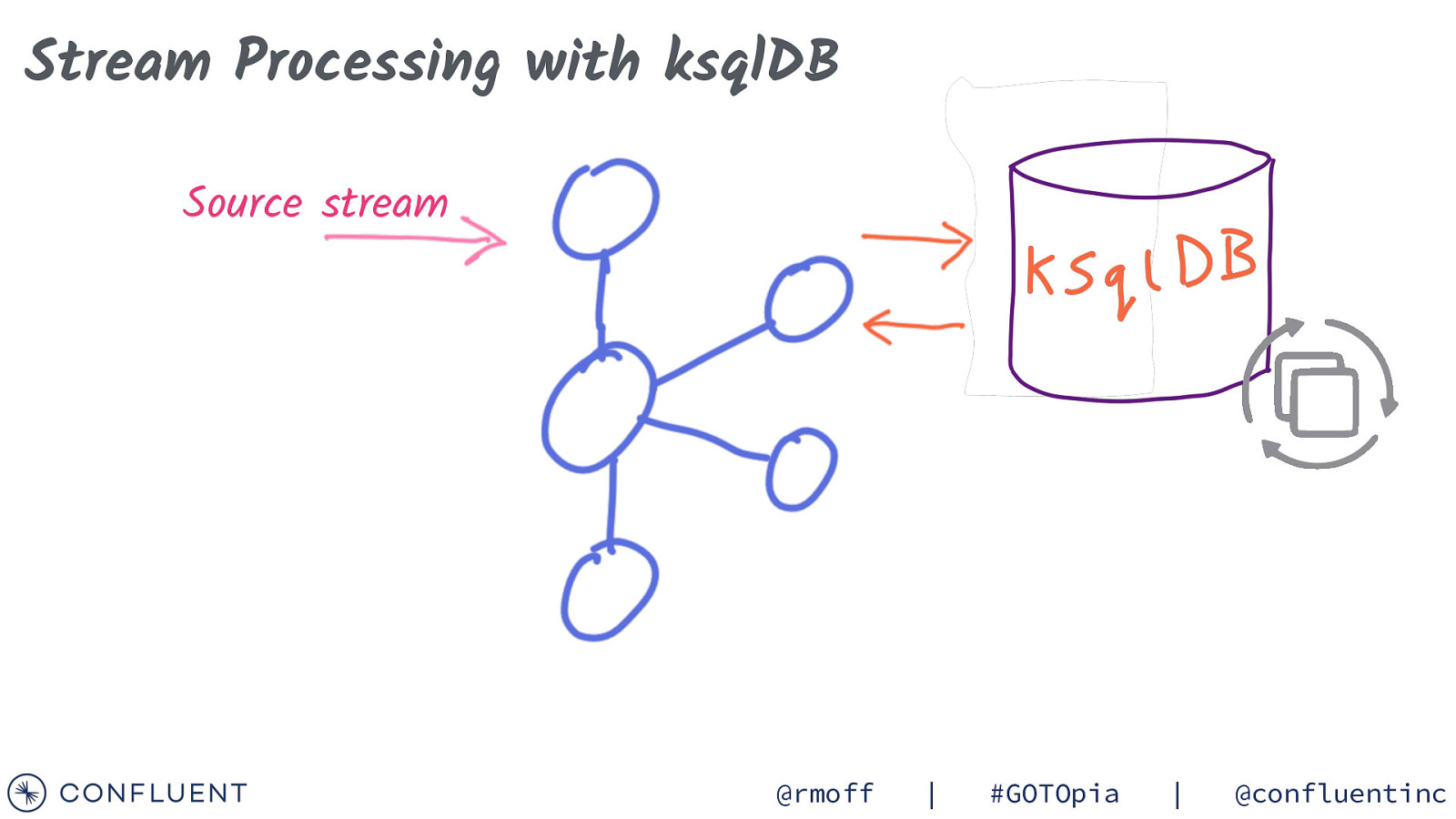
Stream Processing with ksqlDB Source stream @rmoff | #GOTOpia | @confluentinc
Slide 106
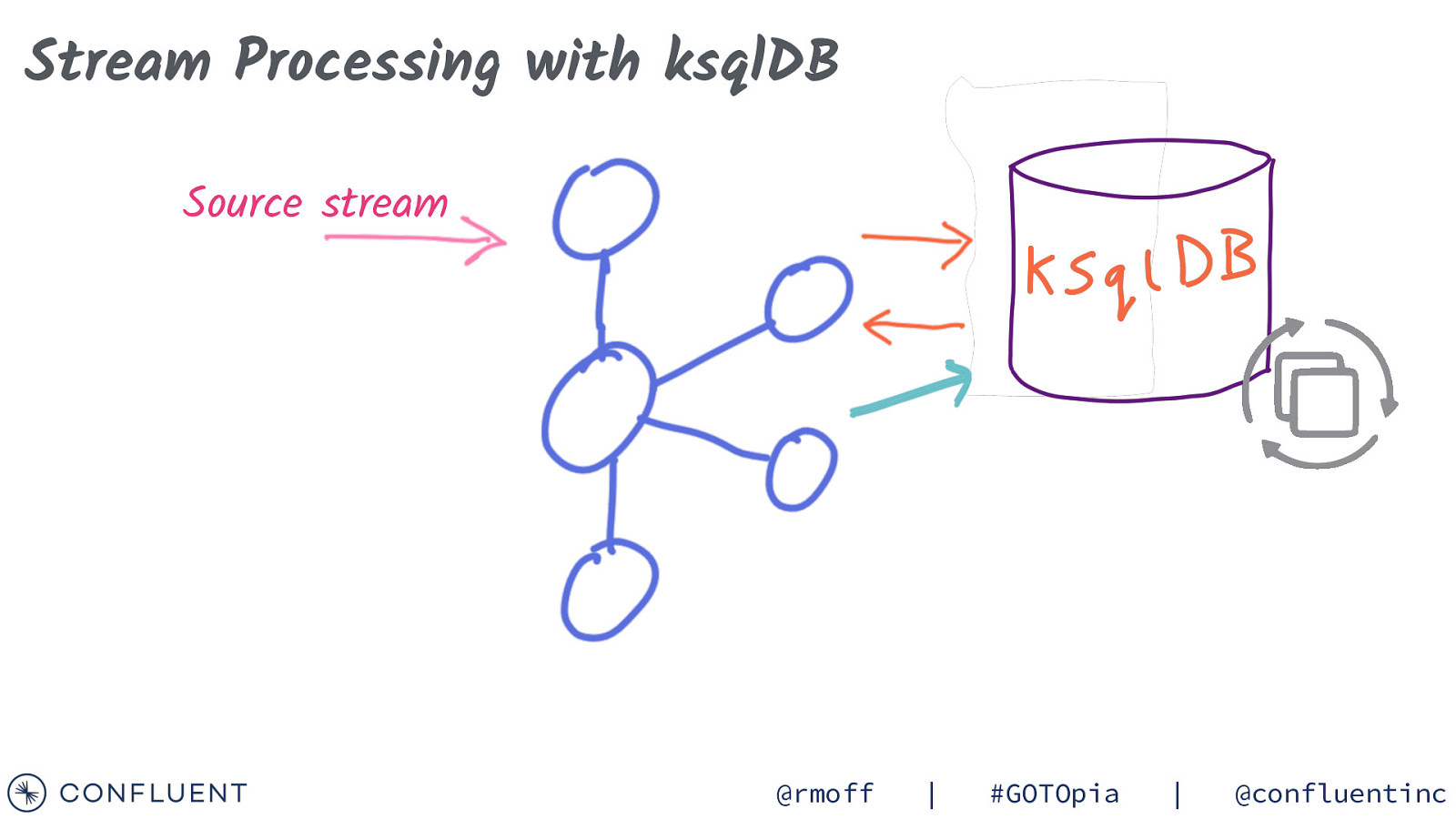
Stream Processing with ksqlDB Source stream @rmoff | #GOTOpia | @confluentinc
Slide 107

Stream Processing with ksqlDB Source stream Analytics @rmoff | #GOTOpia | @confluentinc
Slide 108
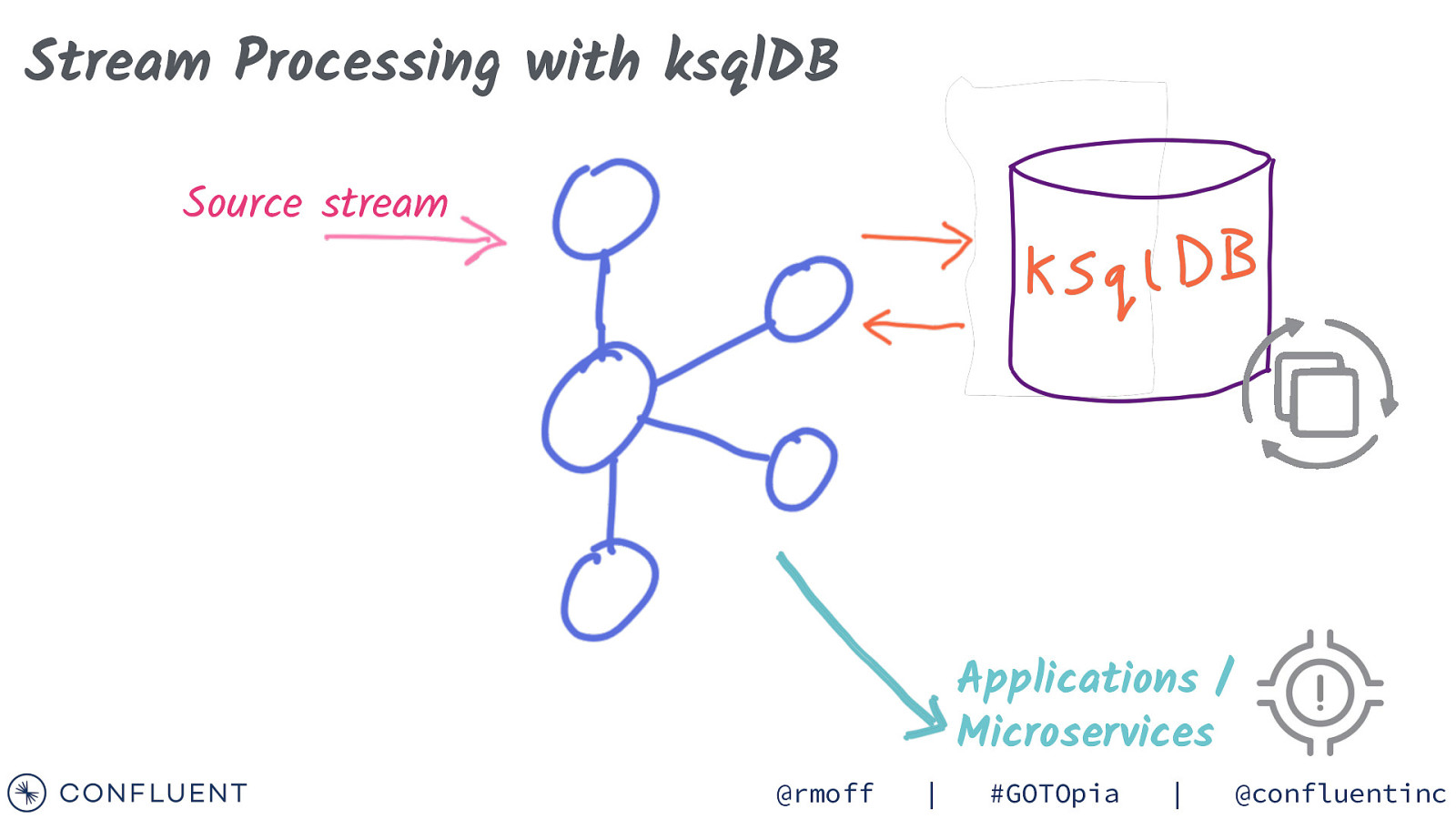
Stream Processing with ksqlDB Source stream Applications / Microservices @rmoff | #GOTOpia | @confluentinc
Slide 109
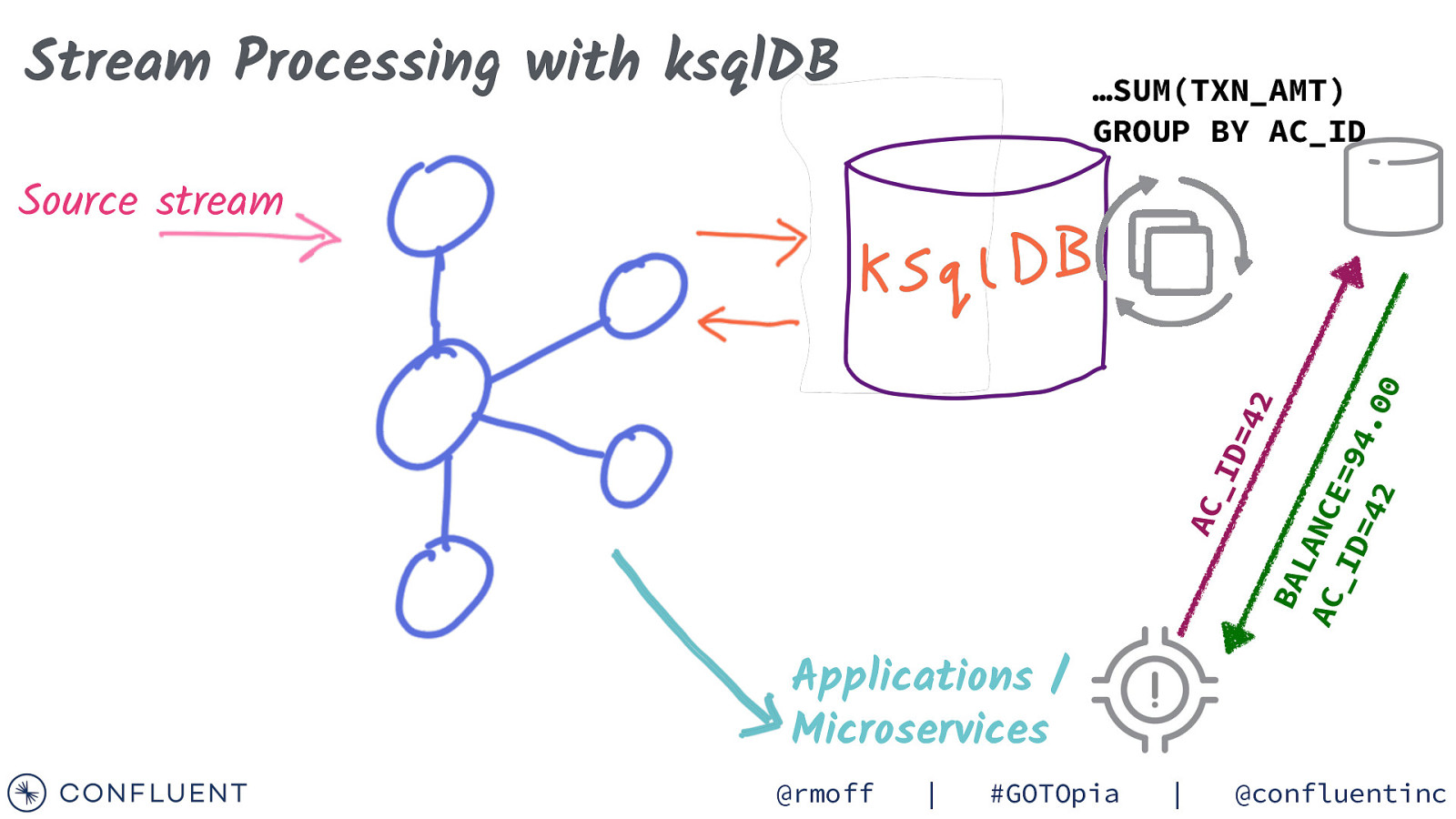
Stream Processing with ksqlDB …SUM(TXN_AMT) GROUP BY AC_ID AC _I D= 42 BA LA NC AC E= _I 94 D= .0 42 0 Source stream Applications / Microservices @rmoff | #GOTOpia | @confluentinc
Slide 110
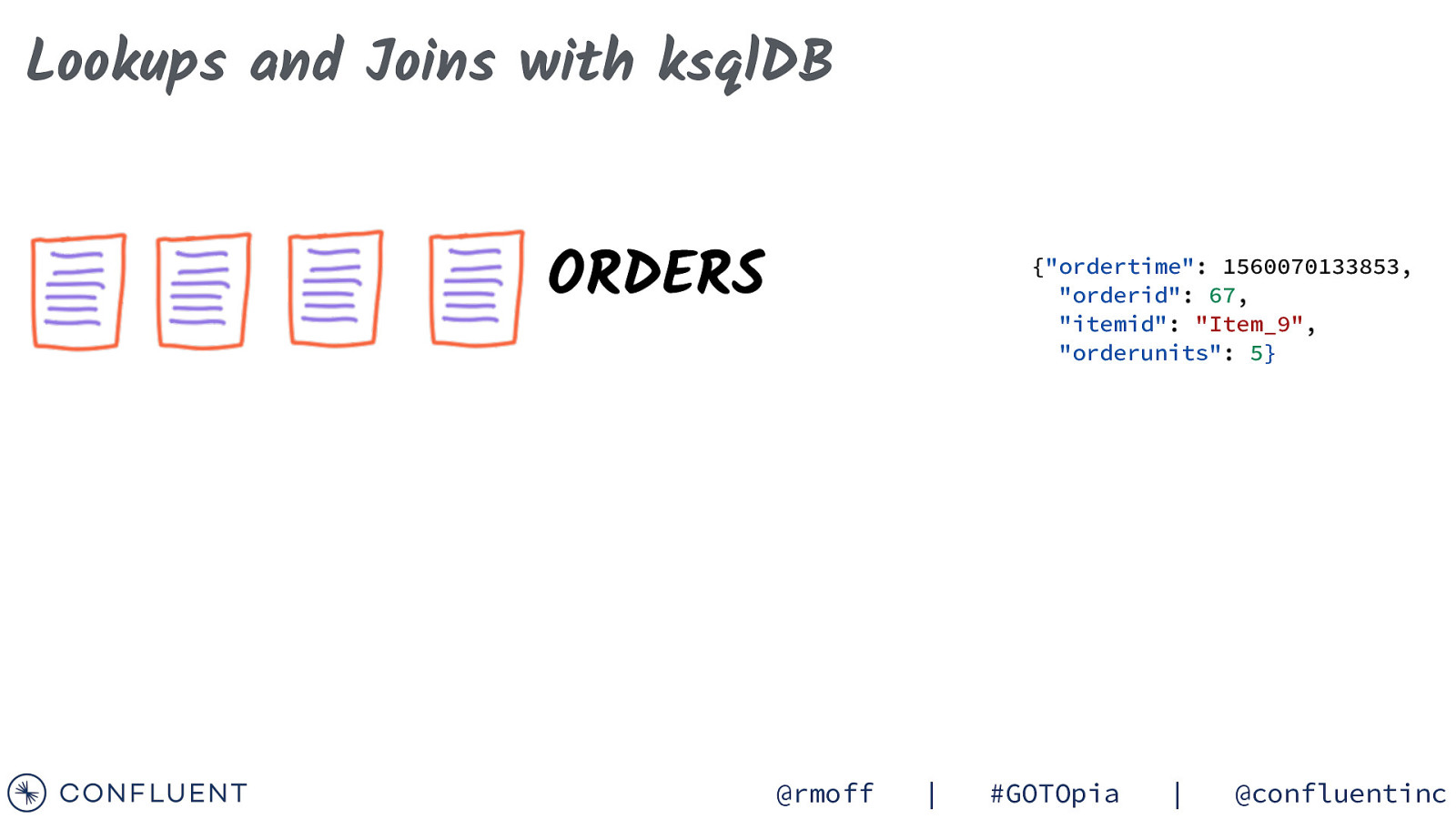
Lookups and Joins with ksqlDB ORDERS {“ordertime”: 1560070133853, “orderid”: 67, “itemid”: “Item_9”, “orderunits”: 5} @rmoff | #GOTOpia | @confluentinc
Slide 111
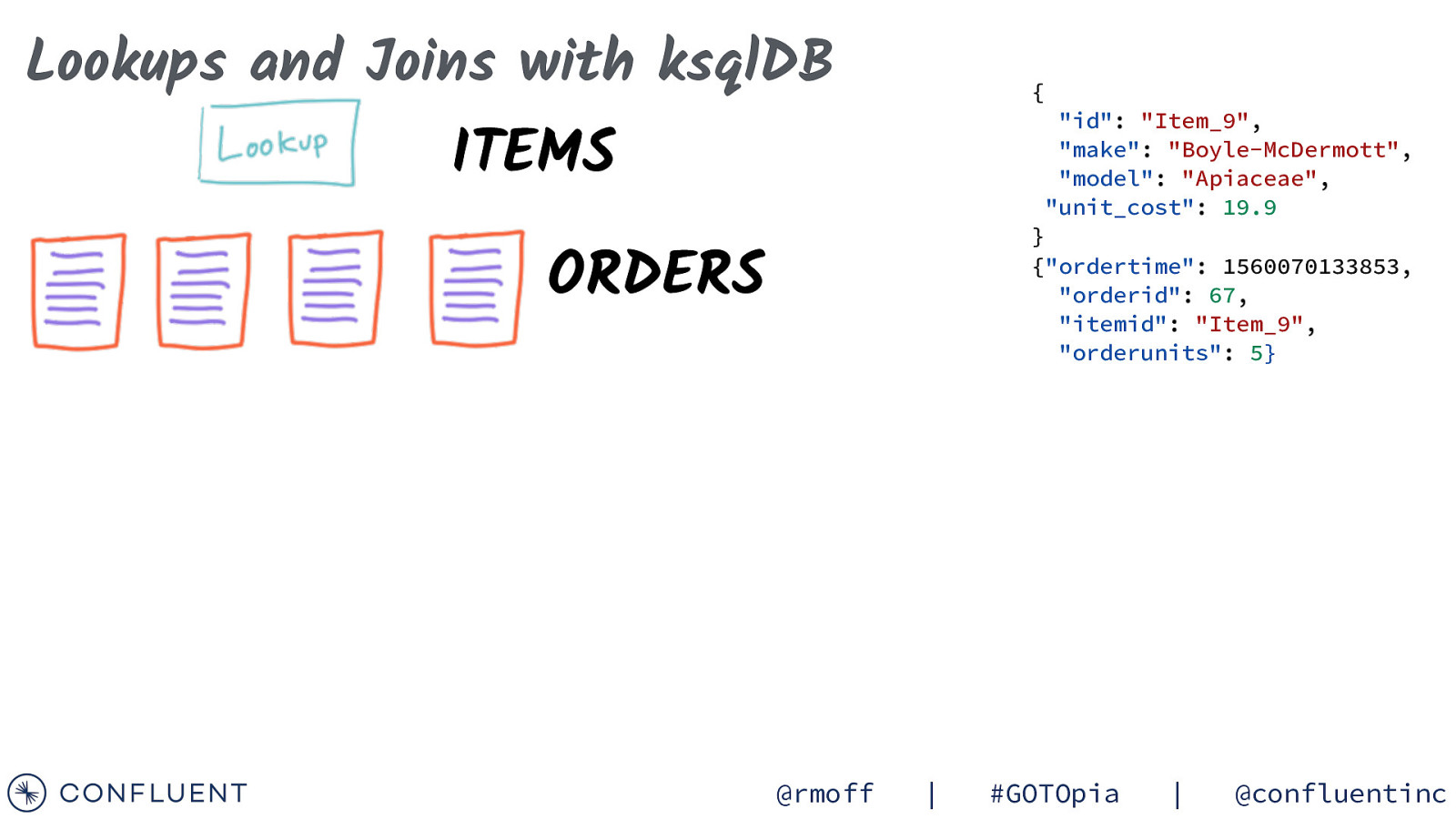
Lookups and Joins with ksqlDB { “id”: “Item_9”, “make”: “Boyle-McDermott”, “model”: “Apiaceae”, “unit_cost”: 19.9 ITEMS } {“ordertime”: 1560070133853, “orderid”: 67, “itemid”: “Item_9”, “orderunits”: 5} ORDERS @rmoff | #GOTOpia | @confluentinc
Slide 112
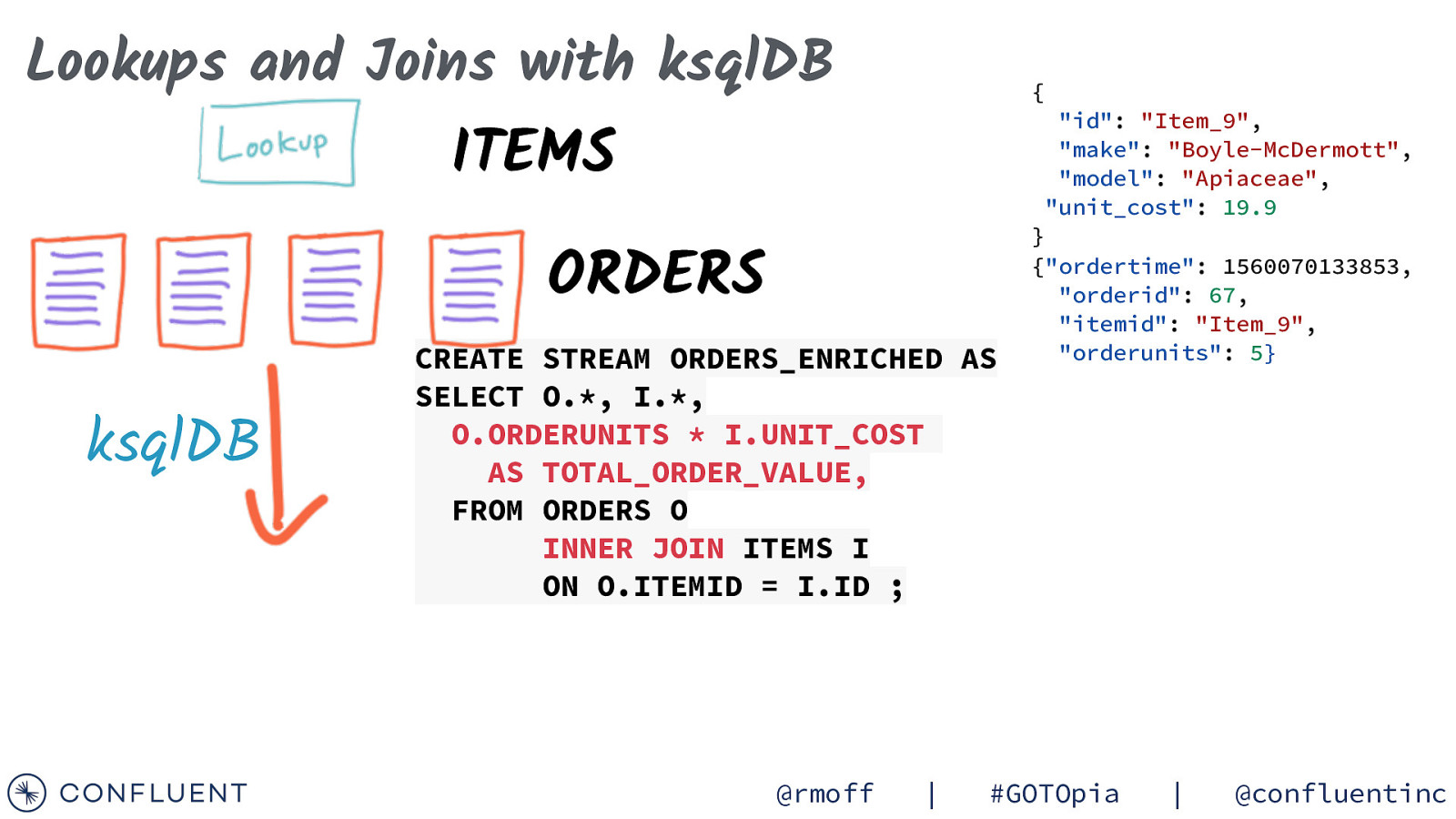
Lookups and Joins with ksqlDB { “id”: “Item_9”, “make”: “Boyle-McDermott”, “model”: “Apiaceae”, “unit_cost”: 19.9 ITEMS ORDERS ksqlDB CREATE STREAM ORDERS_ENRICHED AS SELECT O., I., O.ORDERUNITS * I.UNIT_COST AS TOTAL_ORDER_VALUE, FROM ORDERS O INNER JOIN ITEMS I ON O.ITEMID = I.ID ; @rmoff | } {“ordertime”: 1560070133853, “orderid”: 67, “itemid”: “Item_9”, “orderunits”: 5} #GOTOpia | @confluentinc
Slide 113
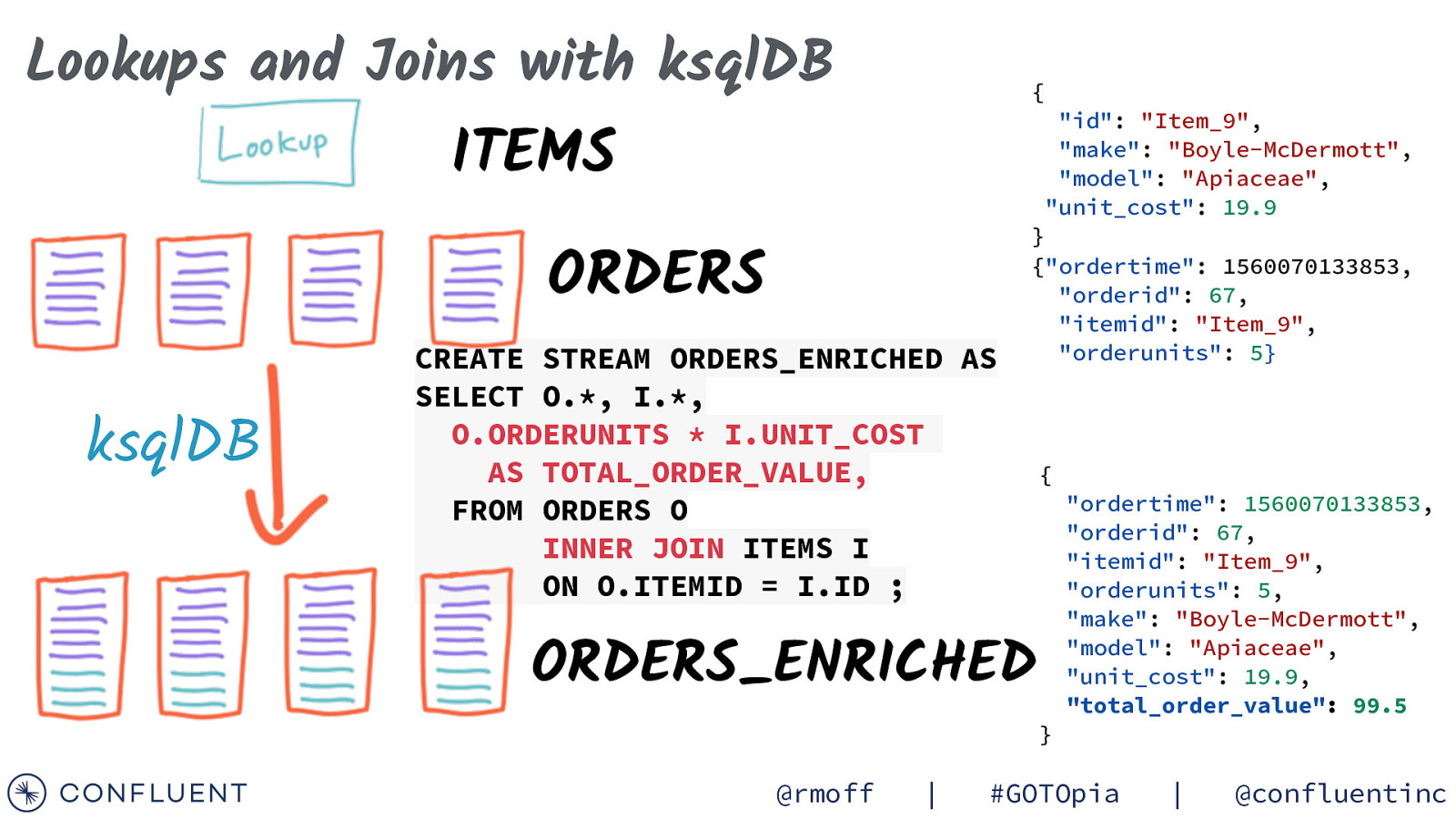
Lookups and Joins with ksqlDB { “id”: “Item_9”, “make”: “Boyle-McDermott”, “model”: “Apiaceae”, “unit_cost”: 19.9 ITEMS ORDERS ksqlDB CREATE STREAM ORDERS_ENRICHED AS SELECT O., I., O.ORDERUNITS * I.UNIT_COST AS TOTAL_ORDER_VALUE, FROM ORDERS O INNER JOIN ITEMS I ON O.ITEMID = I.ID ; } {“ordertime”: 1560070133853, “orderid”: 67, “itemid”: “Item_9”, “orderunits”: 5} { “ordertime”: 1560070133853, “orderid”: 67, “itemid”: “Item_9”, “orderunits”: 5, “make”: “Boyle-McDermott”, “model”: “Apiaceae”, “unit_cost”: 19.9, “total_order_value”: 99.5 ORDERS_ENRICHED } @rmoff | #GOTOpia | @confluentinc
Slide 114
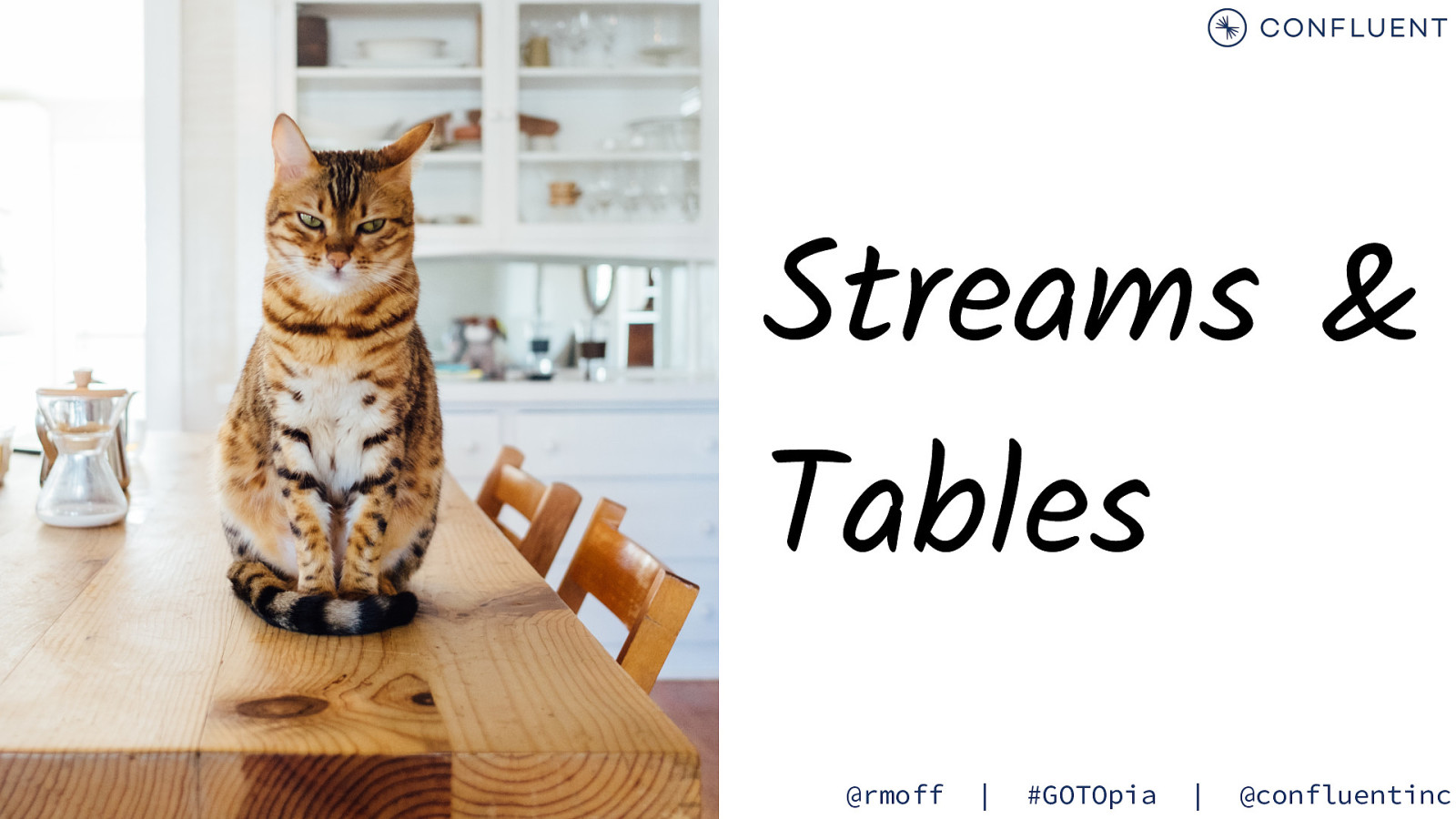
Streams & Tables @rmoff | #GOTOpia | @confluentinc
Slide 115
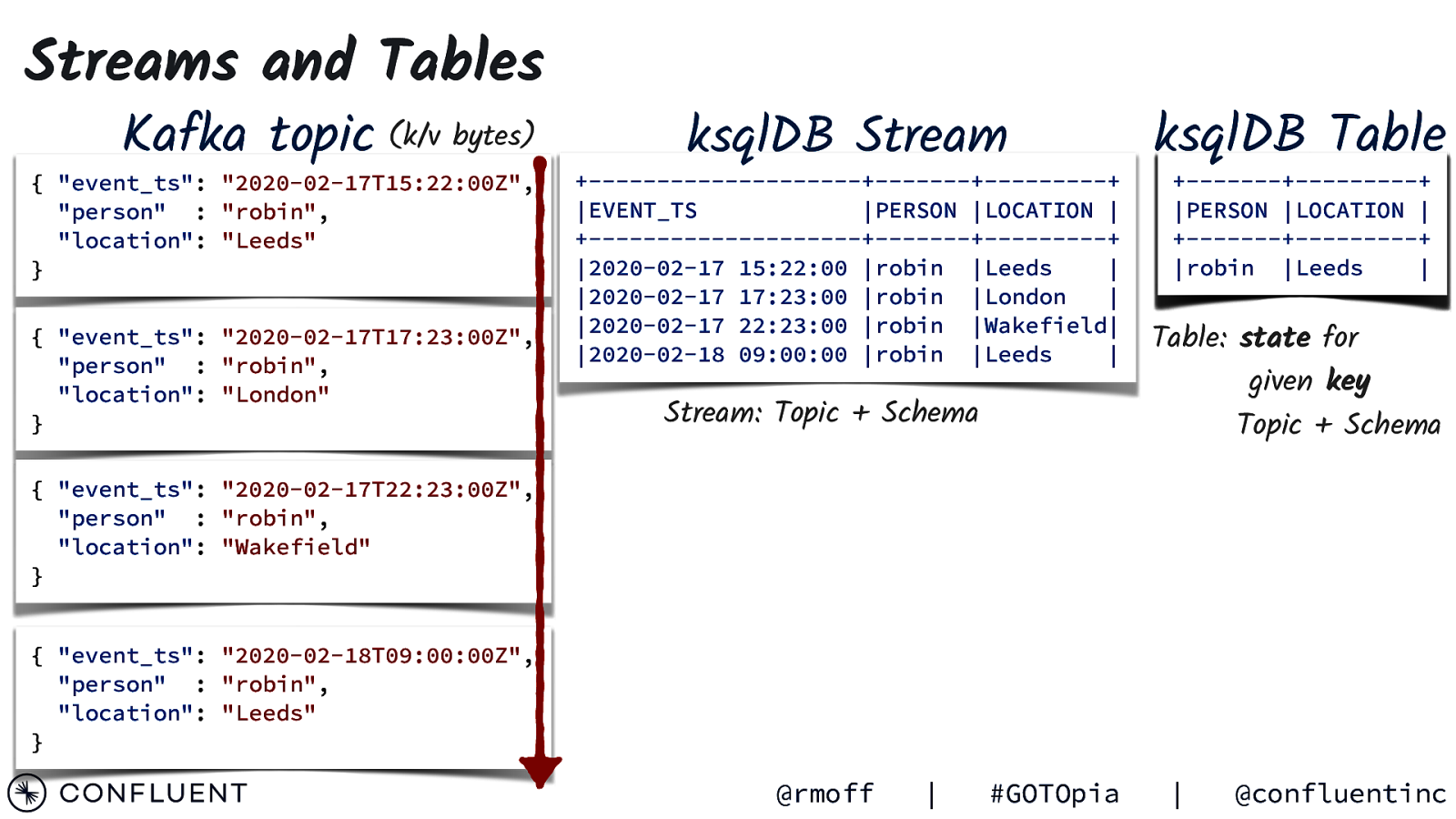
Streams and Tables Kafka topic (k/v bytes) { “event_ts”: “2020-02-17T15:22:00Z”, “person” : “robin”, “location”: “Leeds” } { “event_ts”: “2020-02-17T17:23:00Z”, “person” : “robin”, “location”: “London” } ksqlDB Stream +——————————+———-+————-+ |EVENT_TS |PERSON |LOCATION | +——————————+———-+————-+ |2020-02-17 15:22:00 |robin |Leeds | |2020-02-17 17:23:00 |robin |London | |2020-02-17 22:23:00 |robin |Wakefield| |2020-02-18 09:00:00 |robin |Leeds | Stream: Topic + Schema ksqlDB Table +———-+————-+ |PERSON |LOCATION | +———-+————-+ |robin |Leeds |London |Wakefield| | Table: state for given key Topic + Schema { “event_ts”: “2020-02-17T22:23:00Z”, “person” : “robin”, “location”: “Wakefield” } { “event_ts”: “2020-02-18T09:00:00Z”, “person” : “robin”, “location”: “Leeds” } @rmoff | #GOTOpia | @confluentinc
Slide 116
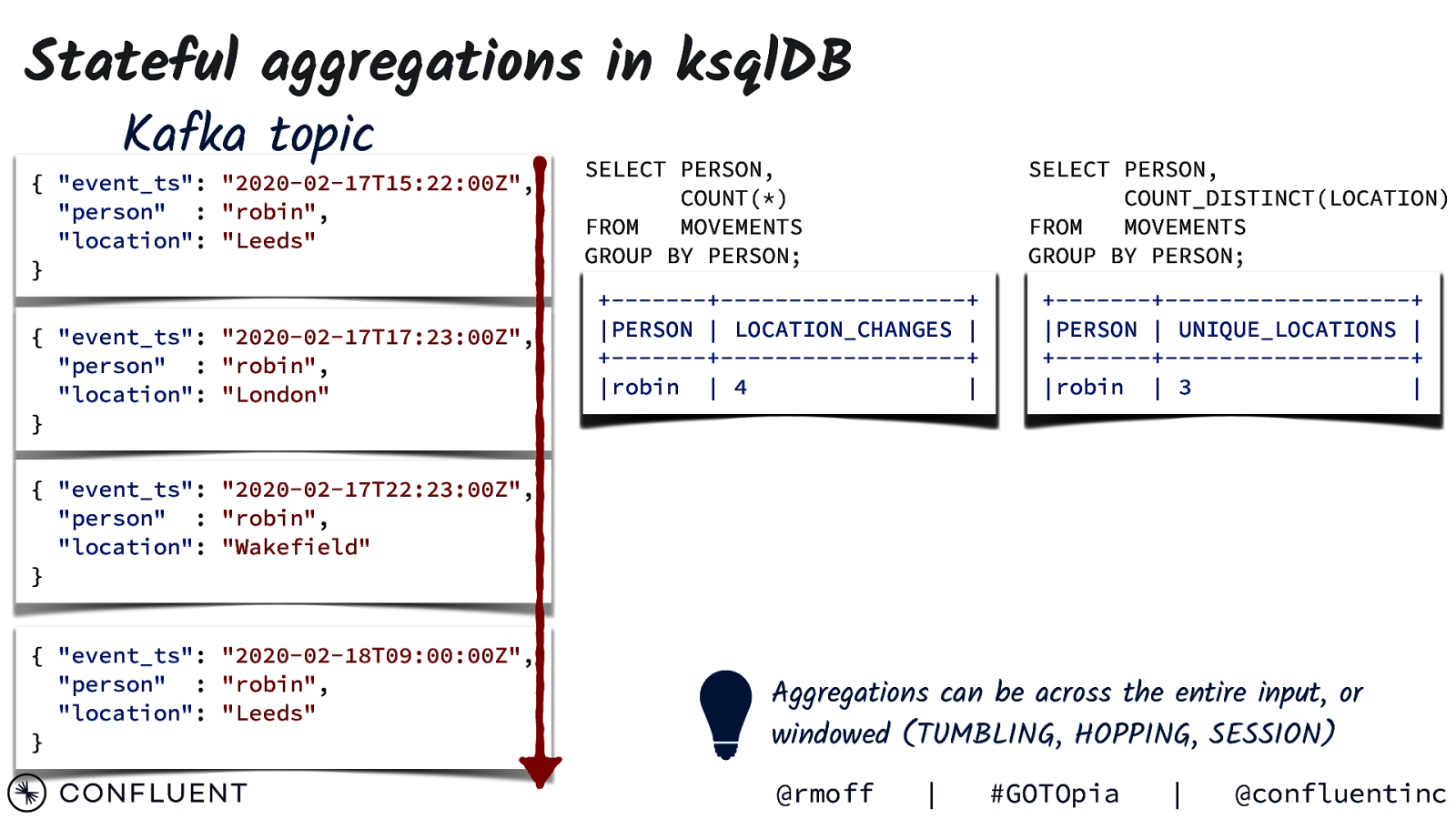
Stateful aggregations in ksqlDB Kafka topic { “event_ts”: “2020-02-17T15:22:00Z”, “person” : “robin”, “location”: “Leeds” } { “event_ts”: “2020-02-17T17:23:00Z”, “person” : “robin”, “location”: “London” } SELECT PERSON, COUNT(*) FROM MOVEMENTS GROUP BY PERSON; SELECT PERSON, COUNT_DISTINCT(LOCATION) FROM MOVEMENTS GROUP BY PERSON; +———-+—————————+ |PERSON | LOCATION_CHANGES | +———-+—————————+ |robin | 4 1 2 3 | +———-+—————————+ |PERSON | UNIQUE_LOCATIONS | +———-+—————————+ |robin | 3 1 2 | { “event_ts”: “2020-02-17T22:23:00Z”, “person” : “robin”, “location”: “Wakefield” } { “event_ts”: “2020-02-18T09:00:00Z”, “person” : “robin”, “location”: “Leeds” } Aggregations can be across the entire input, or windowed (TUMBLING, HOPPING, SESSION) @rmoff | #GOTOpia | @confluentinc
Slide 117
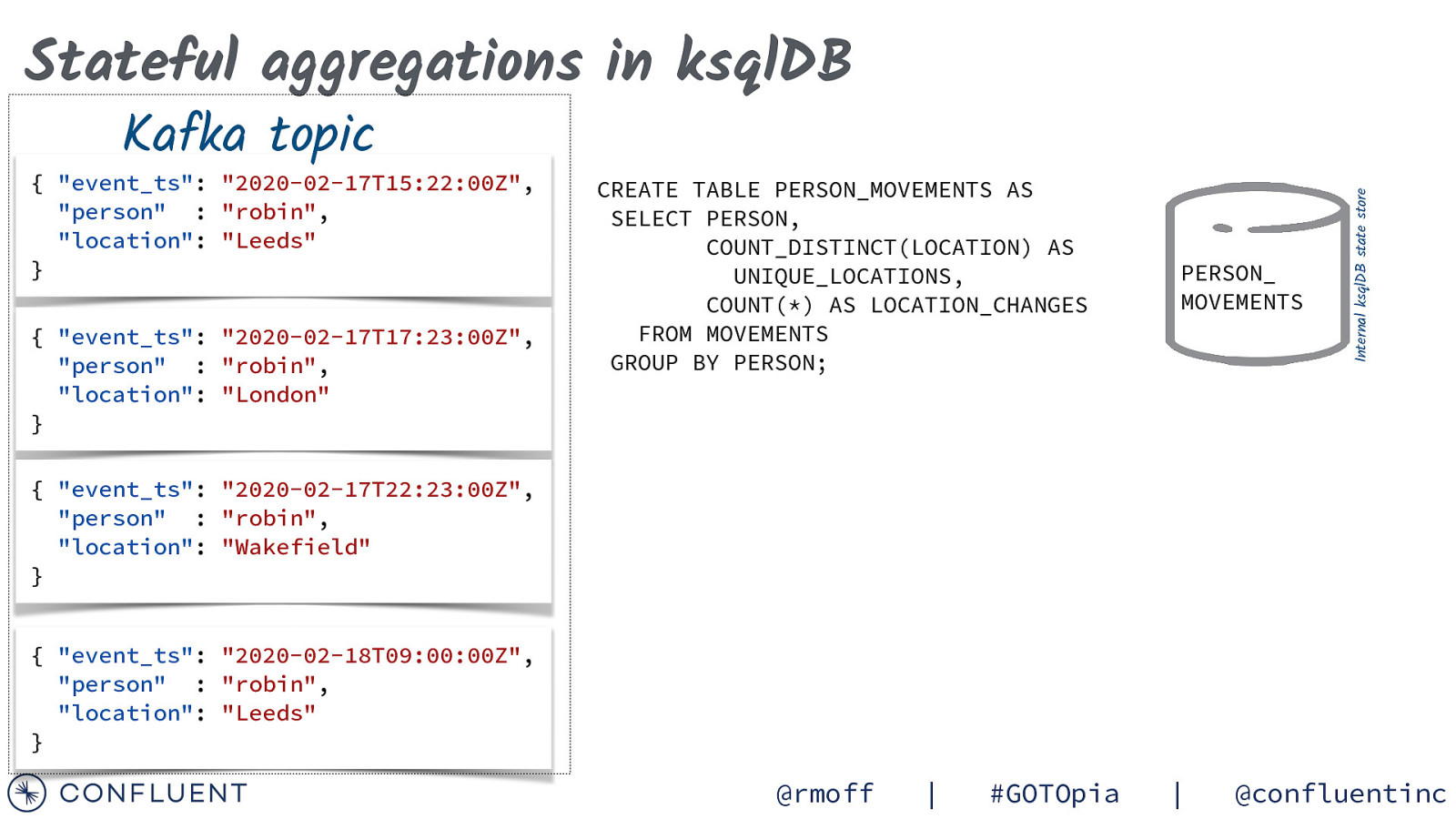
Kafka topic { “event_ts”: “2020-02-17T15:22:00Z”, “person” : “robin”, “location”: “Leeds” } { “event_ts”: “2020-02-17T17:23:00Z”, “person” : “robin”, “location”: “London” } CREATE TABLE PERSON_MOVEMENTS AS SELECT PERSON, COUNT_DISTINCT(LOCATION) AS UNIQUE_LOCATIONS, COUNT(*) AS LOCATION_CHANGES FROM MOVEMENTS GROUP BY PERSON; PERSON_ MOVEMENTS Internal ksqlDB state store Stateful aggregations in ksqlDB { “event_ts”: “2020-02-17T22:23:00Z”, “person” : “robin”, “location”: “Wakefield” } { “event_ts”: “2020-02-18T09:00:00Z”, “person” : “robin”, “location”: “Leeds” } @rmoff | #GOTOpia | @confluentinc
Slide 118
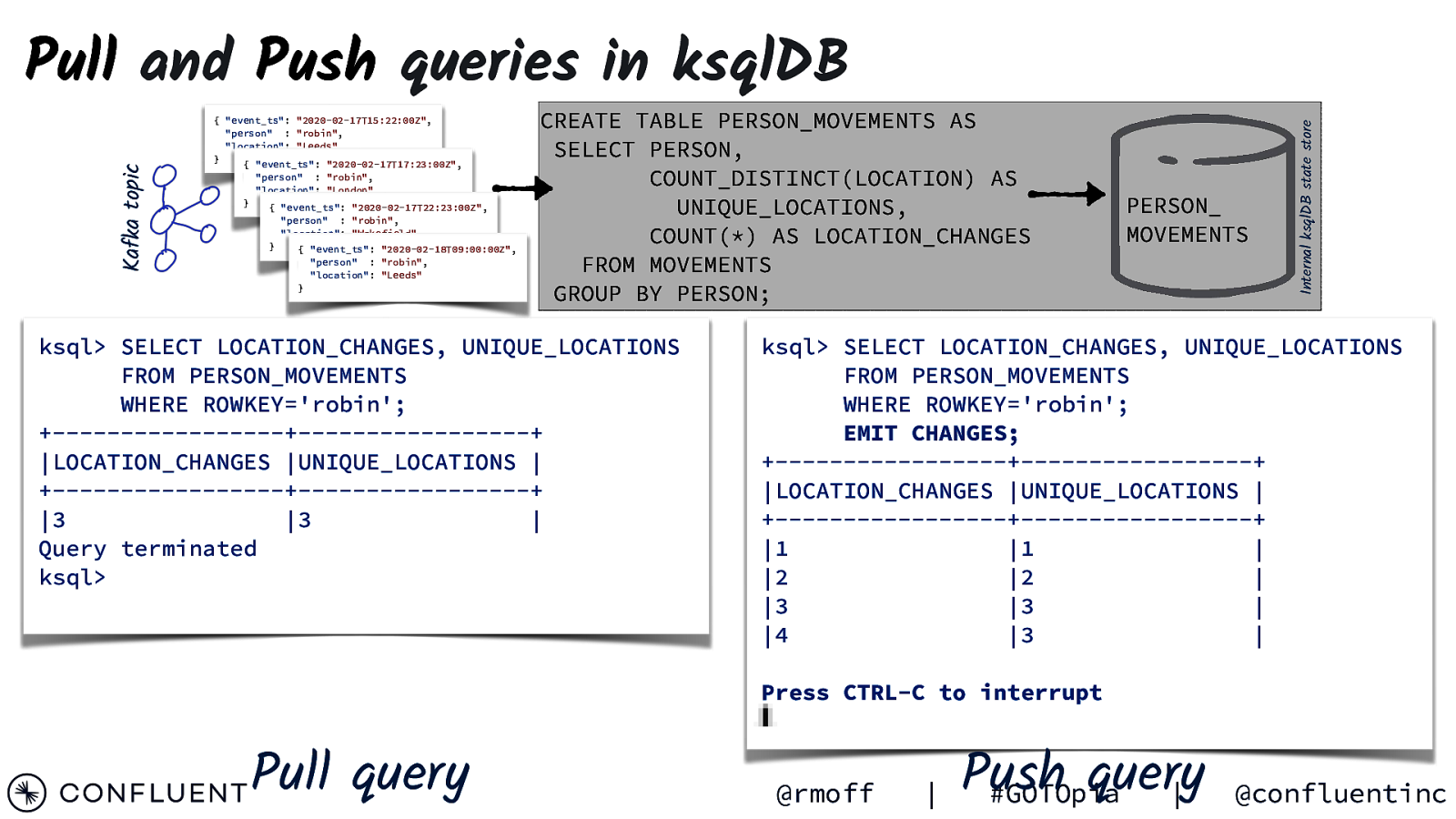
{ “event_ts”: “2020-02-17T15:22:00Z”, “person” : “robin”, “location”: “Leeds” } { “event_ts”: “2020-02-17T17:23:00Z”, “person” : “robin”, “location”: “London” } { “event_ts”: “2020-02-17T22:23:00Z”, “person” : “robin”, “location”: “Wakefield” } { “event_ts”: “2020-02-18T09:00:00Z”, “person” : “robin”, “location”: “Leeds” } CREATE TABLE PERSON_MOVEMENTS AS SELECT PERSON, COUNT_DISTINCT(LOCATION) AS UNIQUE_LOCATIONS, COUNT(*) AS LOCATION_CHANGES FROM MOVEMENTS GROUP BY PERSON; ksql> SELECT LOCATION_CHANGES, UNIQUE_LOCATIONS FROM PERSON_MOVEMENTS WHERE ROWKEY=’robin’; +————————-+————————-+ |LOCATION_CHANGES |UNIQUE_LOCATIONS | +————————-+————————-+ |3 |3 | Query terminated ksql> PERSON_ MOVEMENTS Internal ksqlDB state store Kafka topic Pull and Push queries in ksqlDB ksql> SELECT LOCATION_CHANGES, UNIQUE_LOCATIONS FROM PERSON_MOVEMENTS WHERE ROWKEY=’robin’; EMIT CHANGES; +————————-+————————-+ |LOCATION_CHANGES |UNIQUE_LOCATIONS | +————————-+————————-+ |1 |1 | |2 |2 | |3 |3 | |4 |3 | Press CTRL-C to interrupt Pull query @rmoff | Push query #GOTOpia | @confluentinc
Slide 119
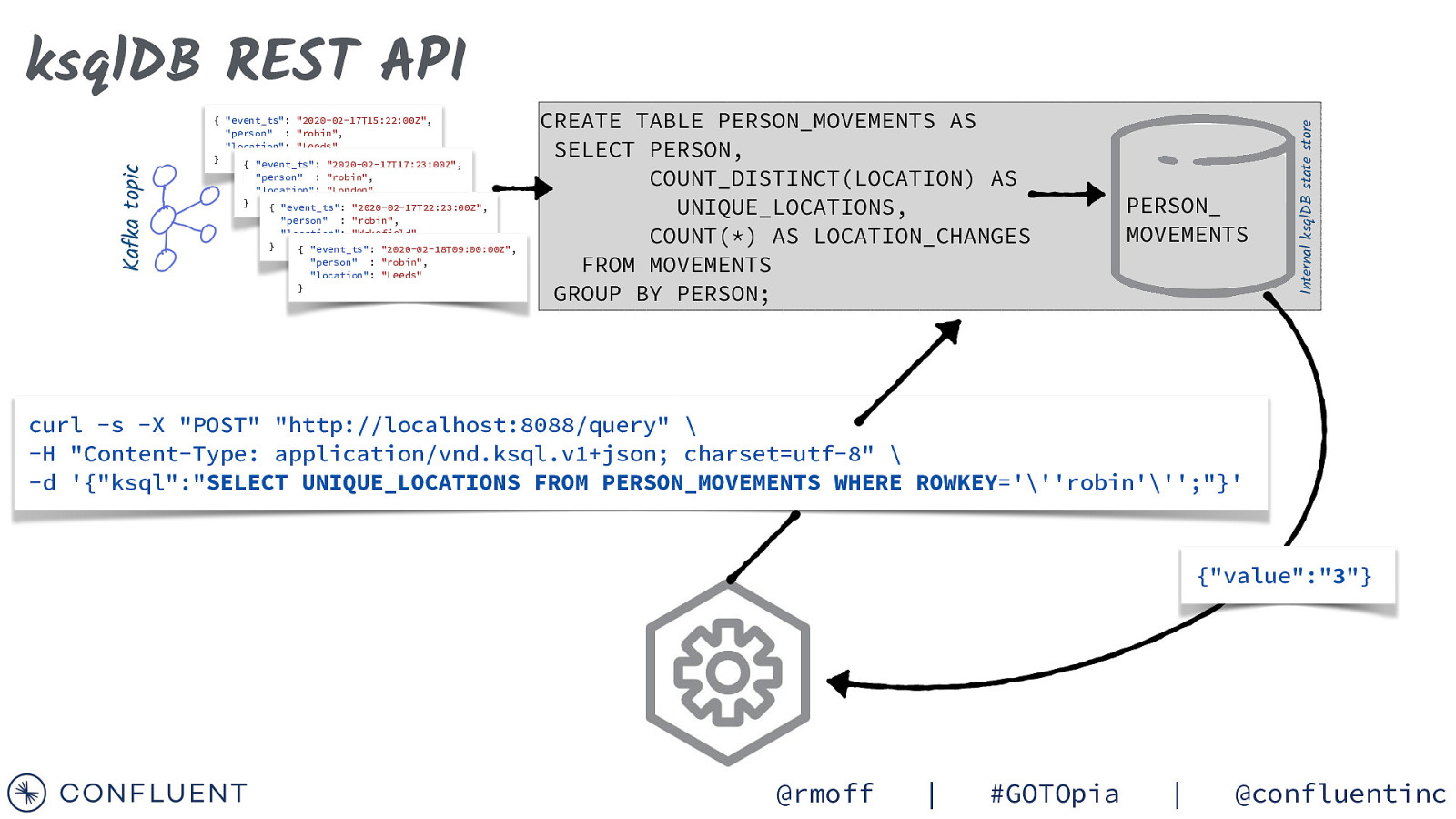
{ “event_ts”: “2020-02-17T15:22:00Z”, “person” : “robin”, “location”: “Leeds” } { “event_ts”: “2020-02-17T17:23:00Z”, “person” : “robin”, “location”: “London” } { “event_ts”: “2020-02-17T22:23:00Z”, “person” : “robin”, “location”: “Wakefield” } { “event_ts”: “2020-02-18T09:00:00Z”, “person” : “robin”, “location”: “Leeds” } CREATE TABLE PERSON_MOVEMENTS AS SELECT PERSON, COUNT_DISTINCT(LOCATION) AS UNIQUE_LOCATIONS, COUNT(*) AS LOCATION_CHANGES FROM MOVEMENTS GROUP BY PERSON; PERSON_ MOVEMENTS Internal ksqlDB state store Kafka topic ksqlDB REST API curl -s -X “POST” “http://localhost:8088/query” \ -H “Content-Type: application/vnd.ksql.v1+json; charset=utf-8” \ -d ‘{“ksql”:”SELECT UNIQUE_LOCATIONS FROM PERSON_MOVEMENTS WHERE ROWKEY=”’robin”’;”}’ {“value”:”3”} @rmoff | #GOTOpia | @confluentinc
Slide 120
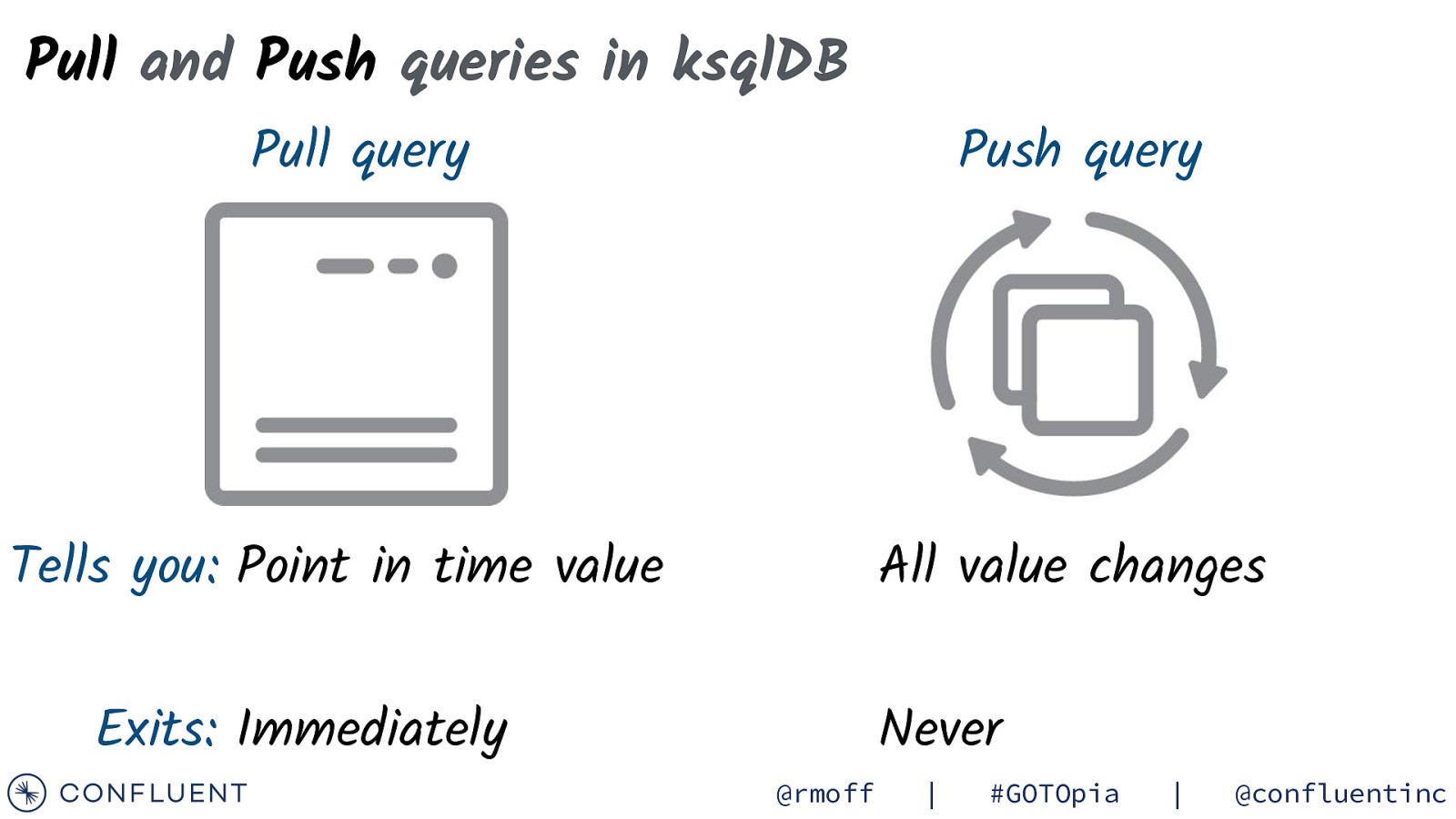
Pull and Push queries in ksqlDB Pull query Tells you: Point in time value Push query All value changes Exits: Immediately Never @rmoff | #GOTOpia | @confluentinc
Slide 121
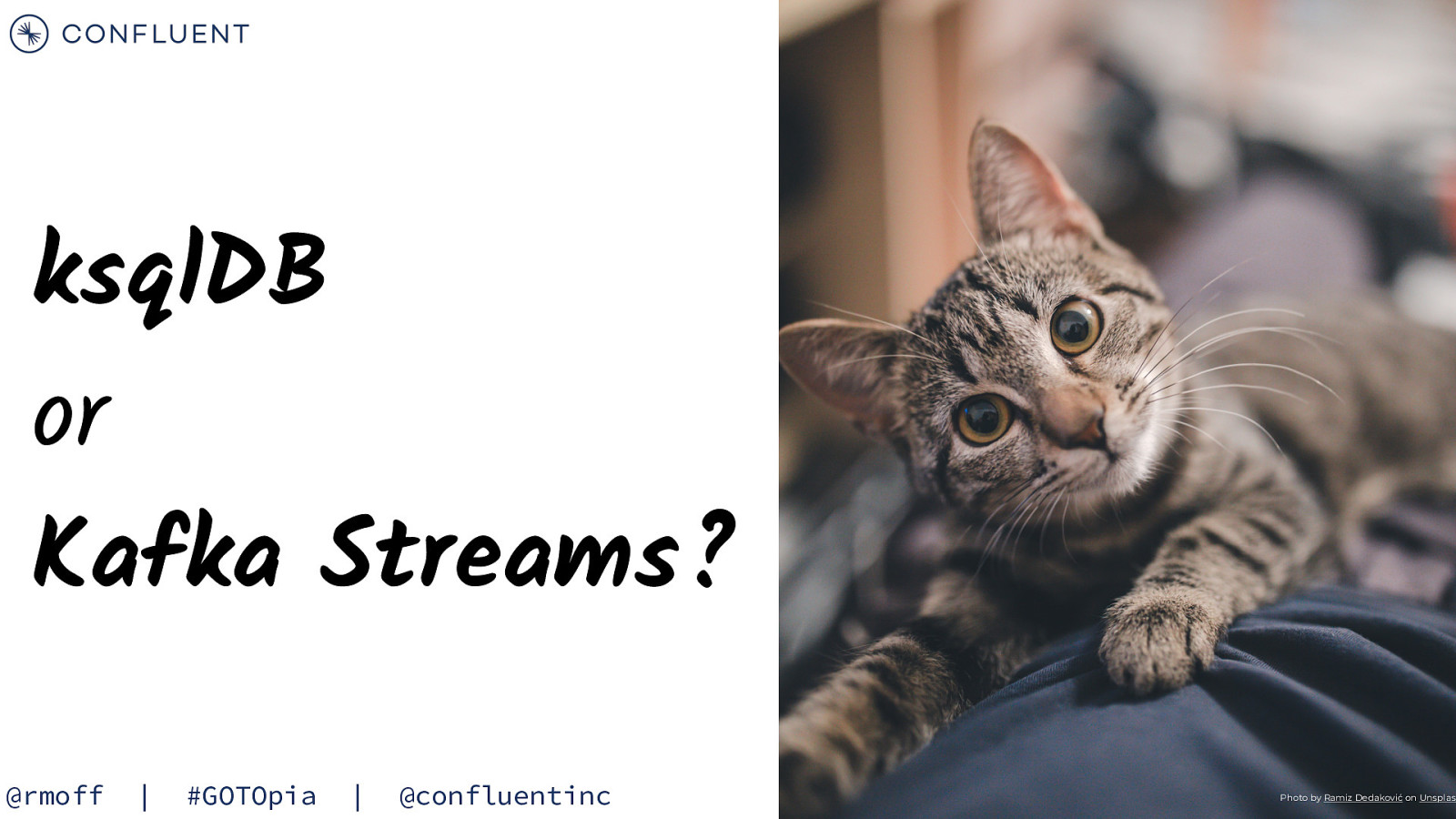
ksqlDB or Kafka Streams? @rmoff | #GOTOpia | @confluentinc Photo by Ramiz Dedaković on Unsplash
Slide 122
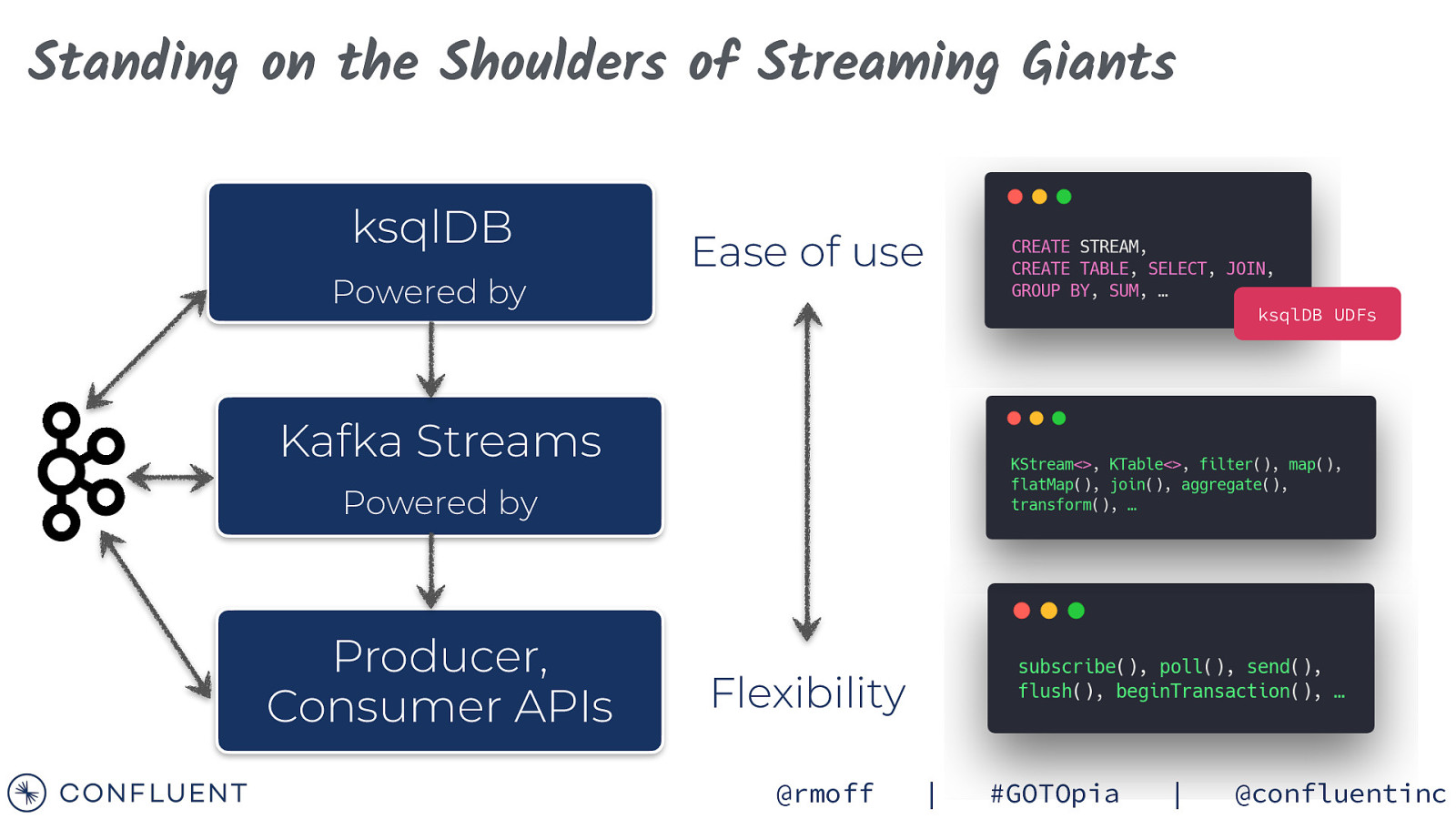
Standing on the Shoulders of Streaming Giants ksqlDB Powered by Ease of use ksqlDB UDFs Kafka Streams Powered by Producer, Consumer APIs Flexibility @rmoff | #GOTOpia | @confluentinc
Slide 123
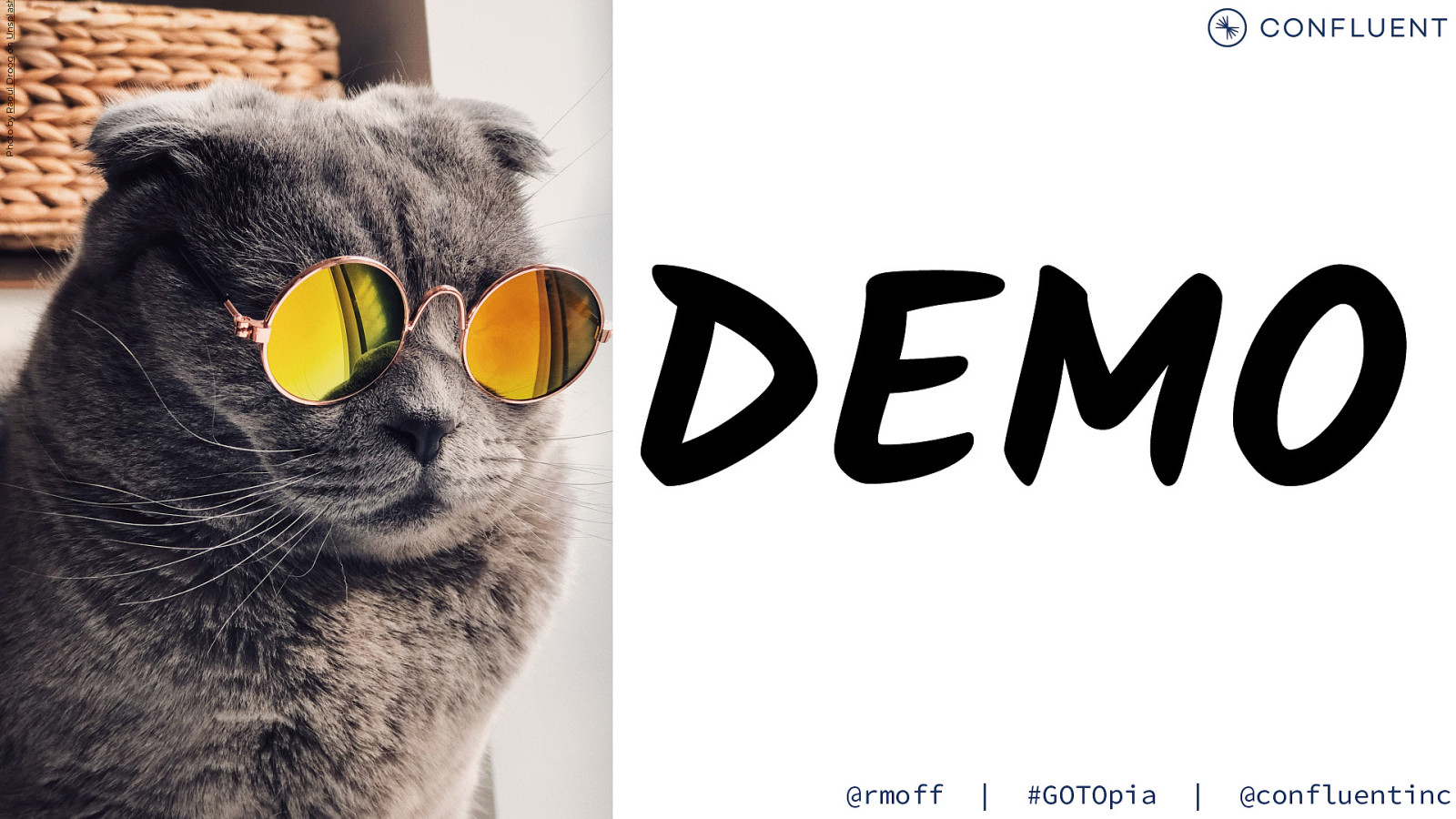
Photo by Raoul Droog on Unsplas DEMO @rmoff | #GOTOpia | @confluentinc
Slide 124

Summary @rmoff | #GOTOpia | @confluentinc
Slide 125
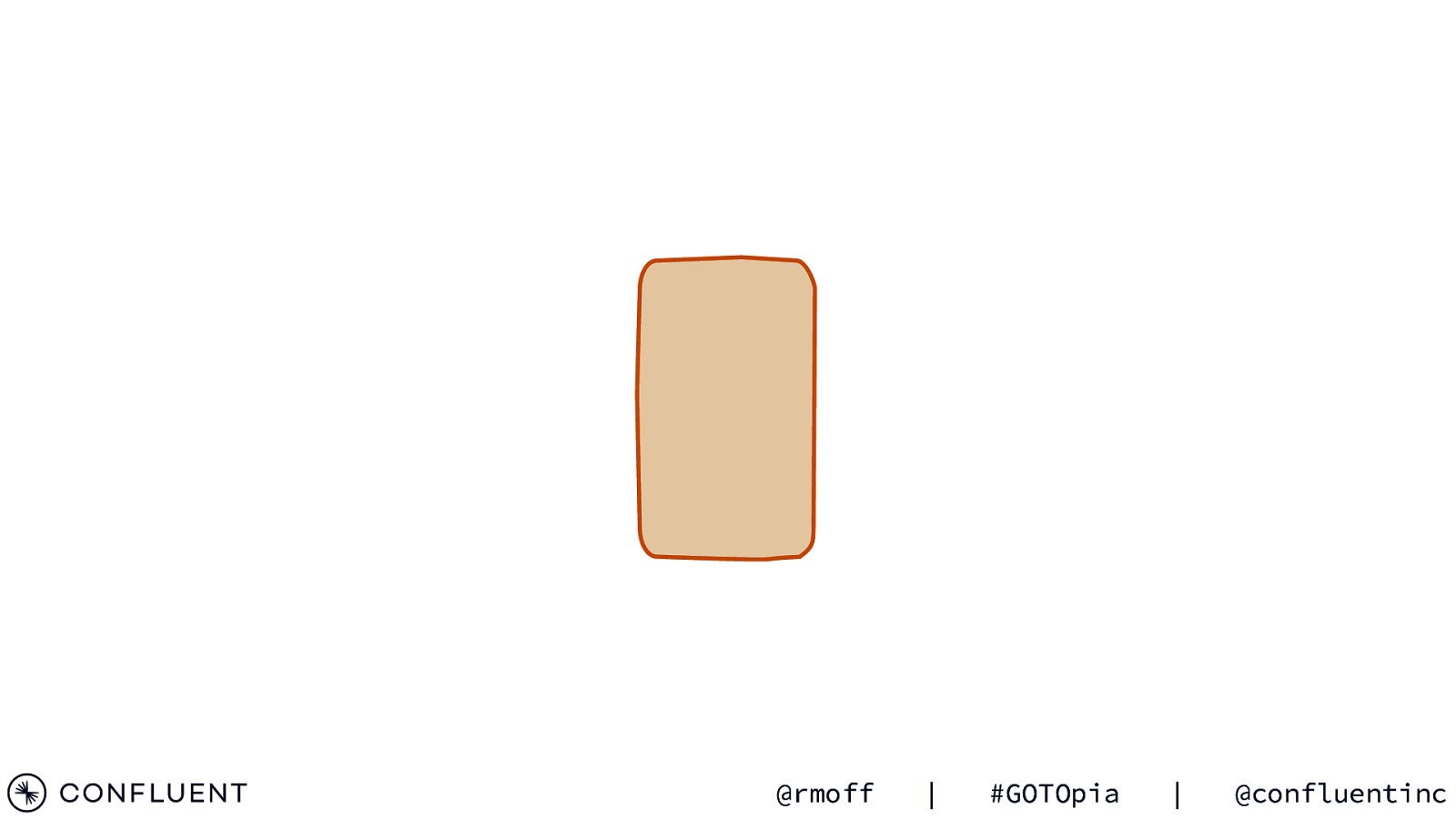
@rmoff | #GOTOpia | @confluentinc
Slide 126
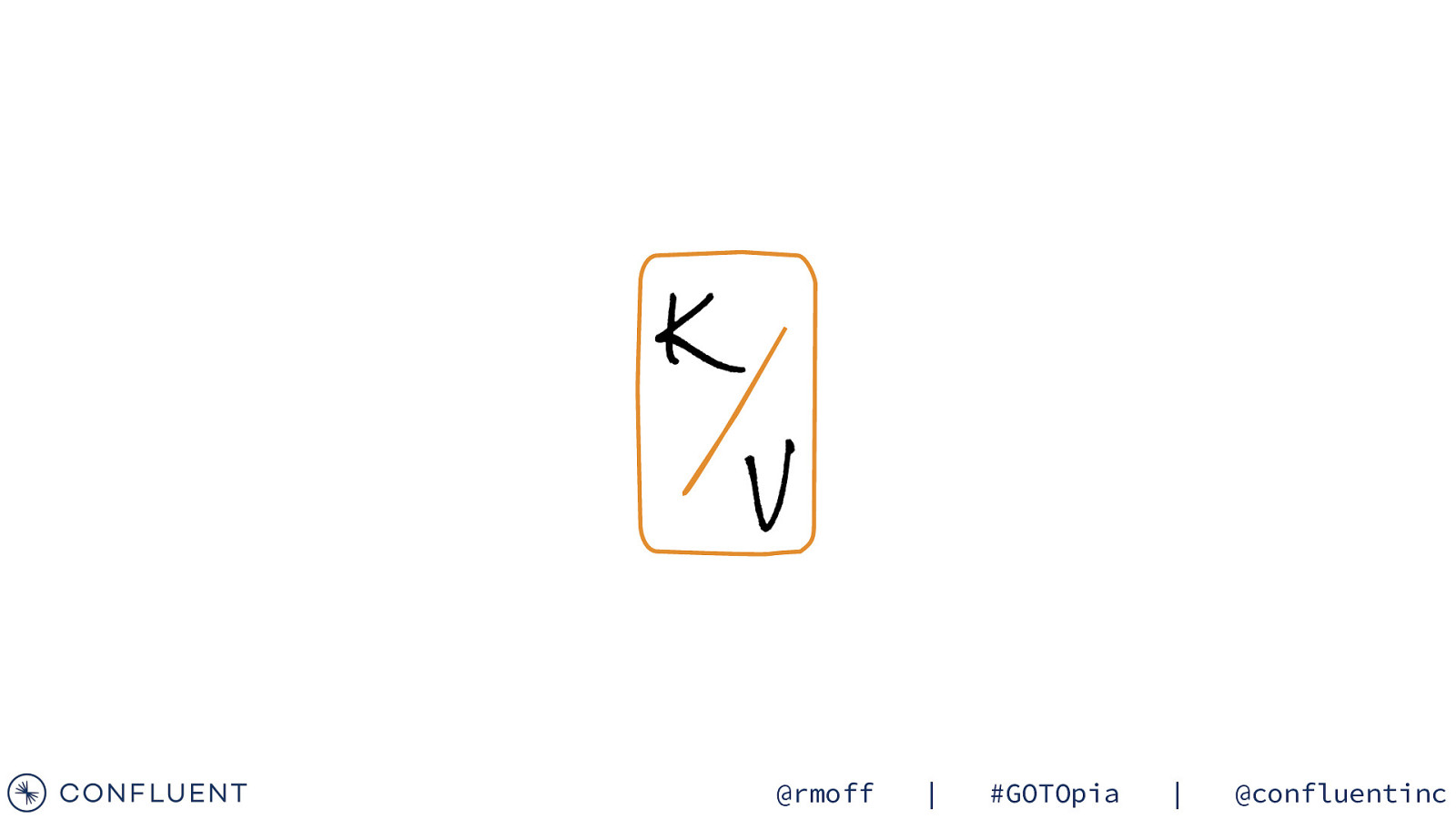
K V @rmoff | #GOTOpia | @confluentinc
Slide 127
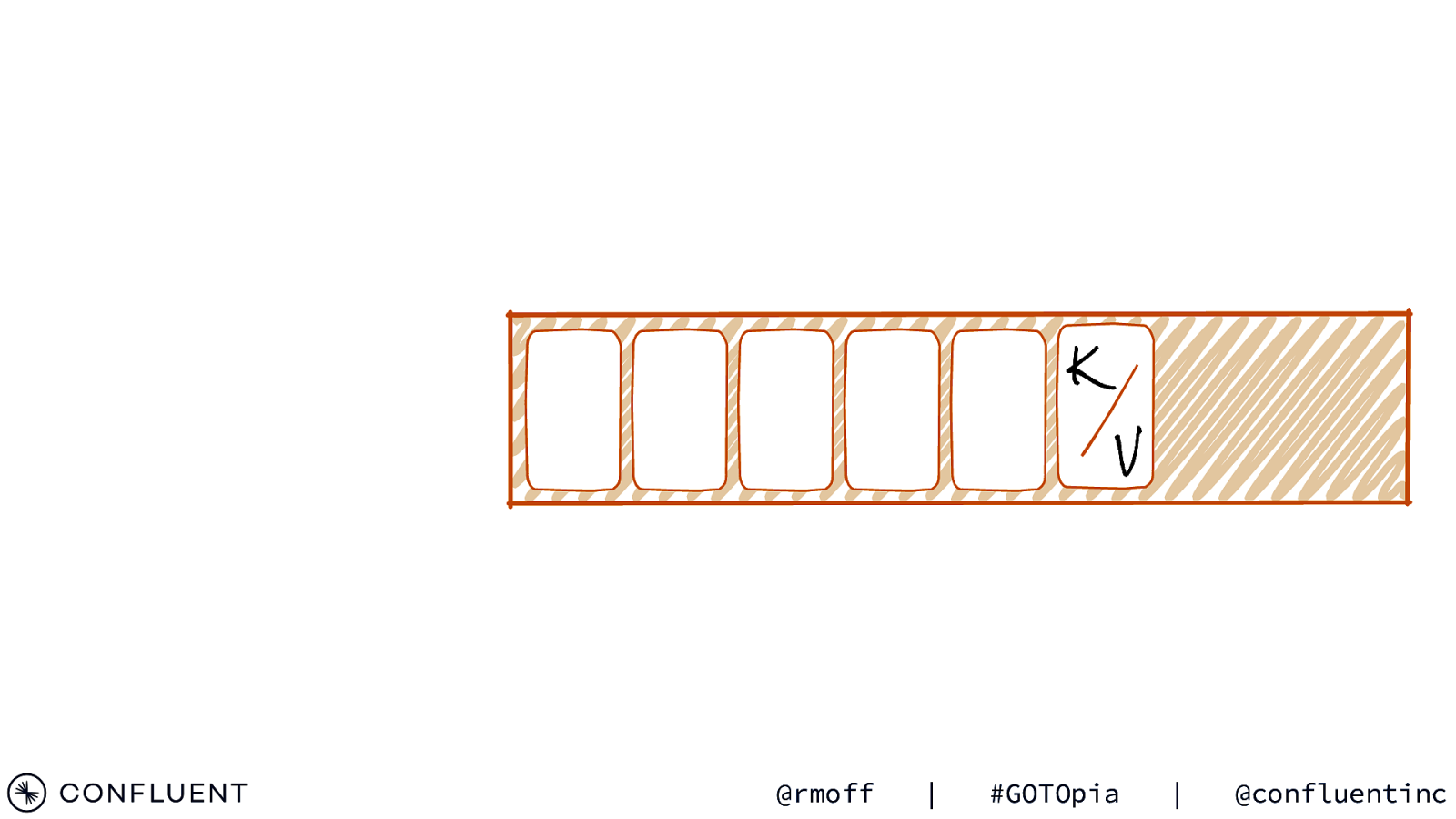
K V @rmoff | #GOTOpia | @confluentinc
Slide 128
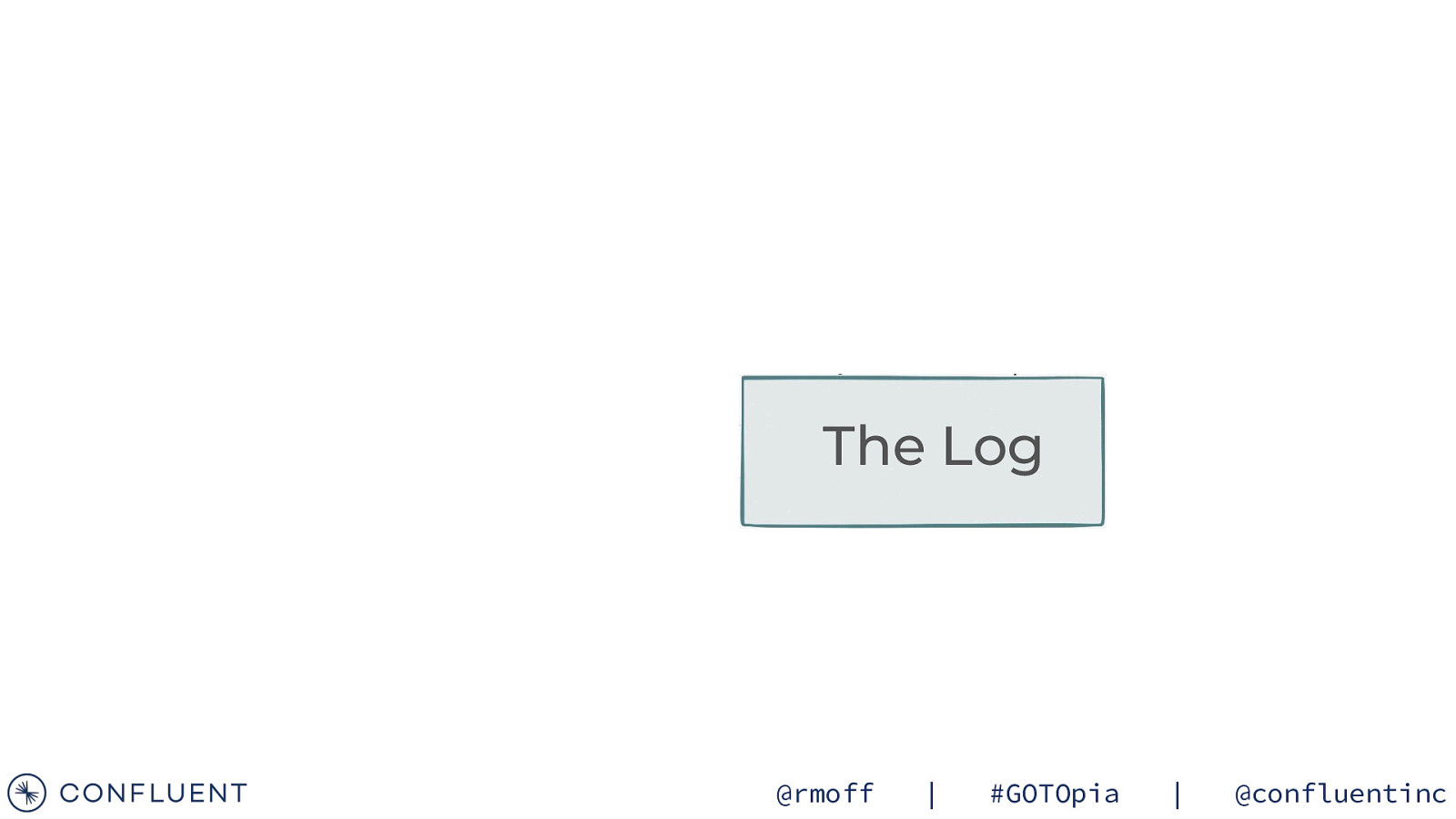
The Log @rmoff | #GOTOpia | @confluentinc
Slide 129
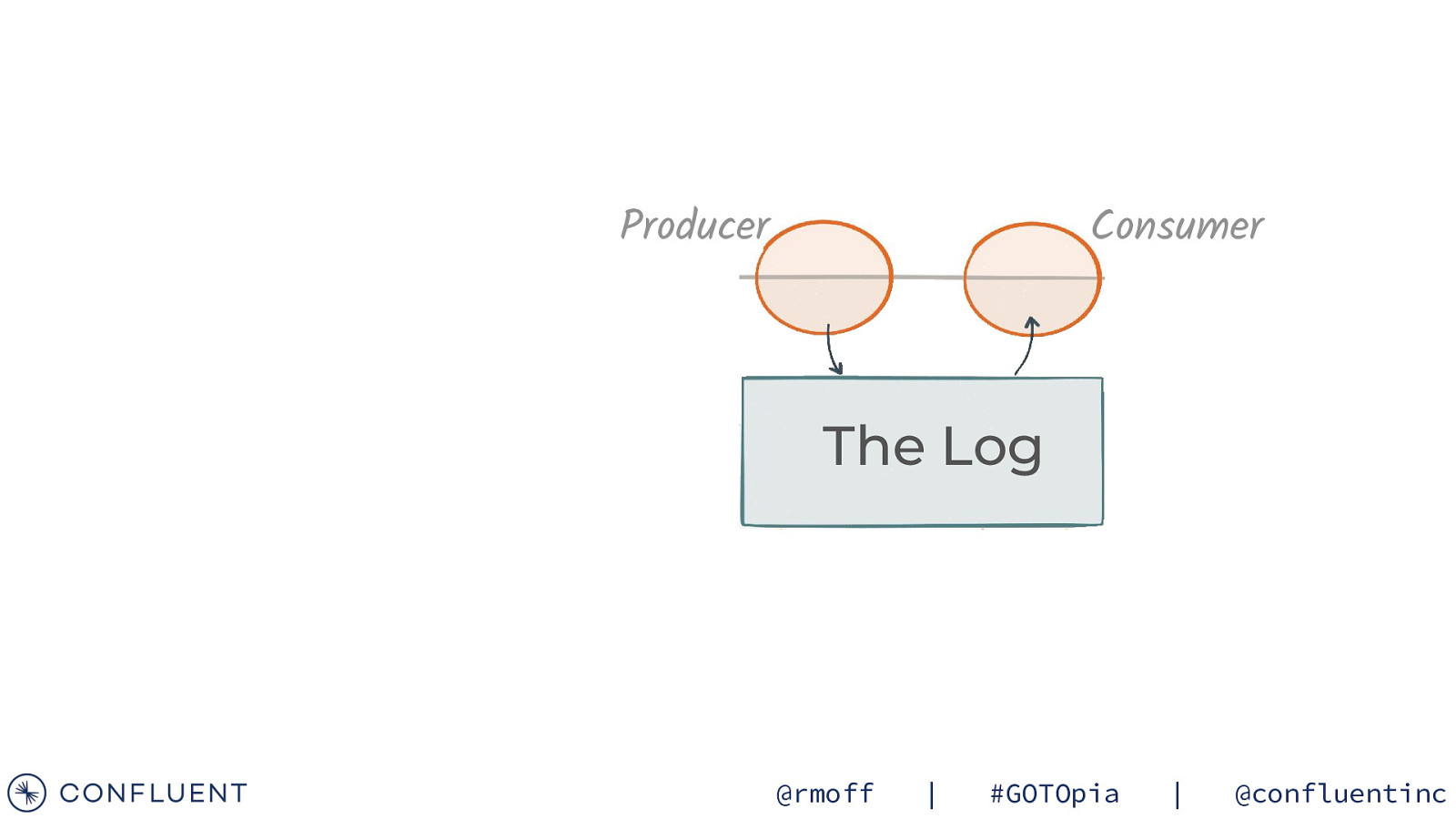
Producer Consumer The Log @rmoff | #GOTOpia | @confluentinc
Slide 130
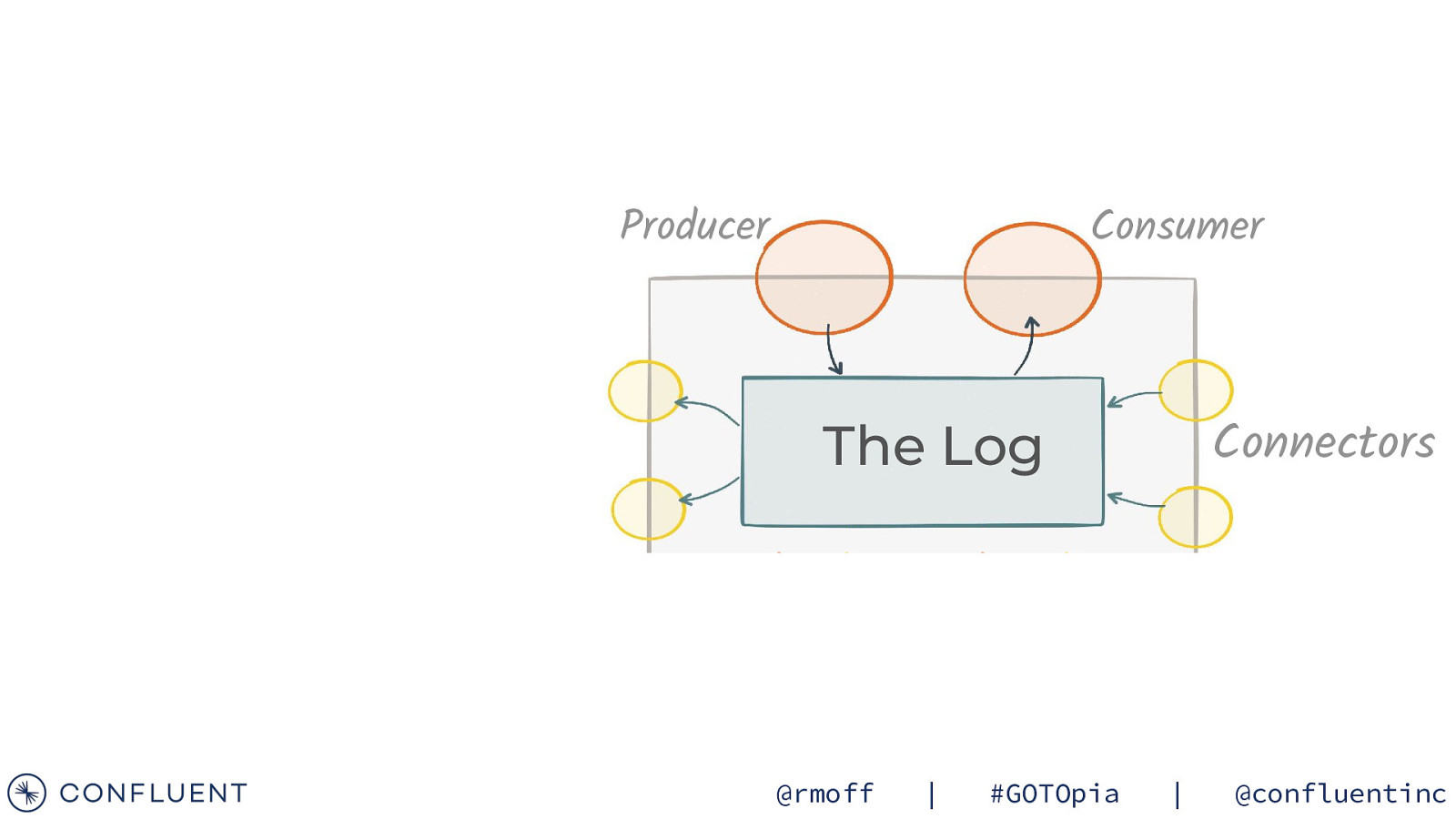
Producer Consumer Connectors The Log @rmoff | #GOTOpia | @confluentinc
Slide 131
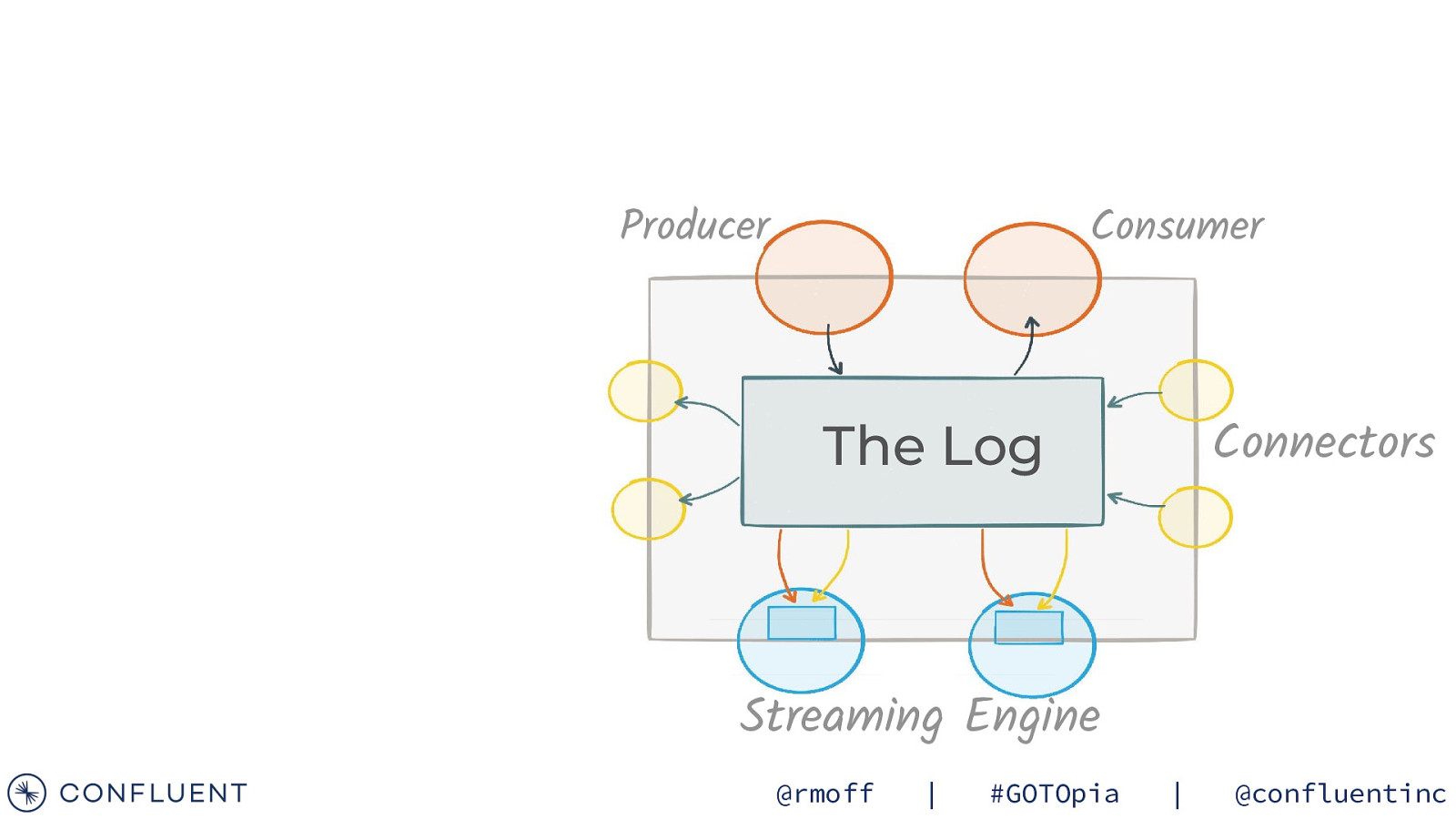
Producer Consumer Connectors The Log Streaming Engine @rmoff | #GOTOpia | @confluentinc
Slide 132
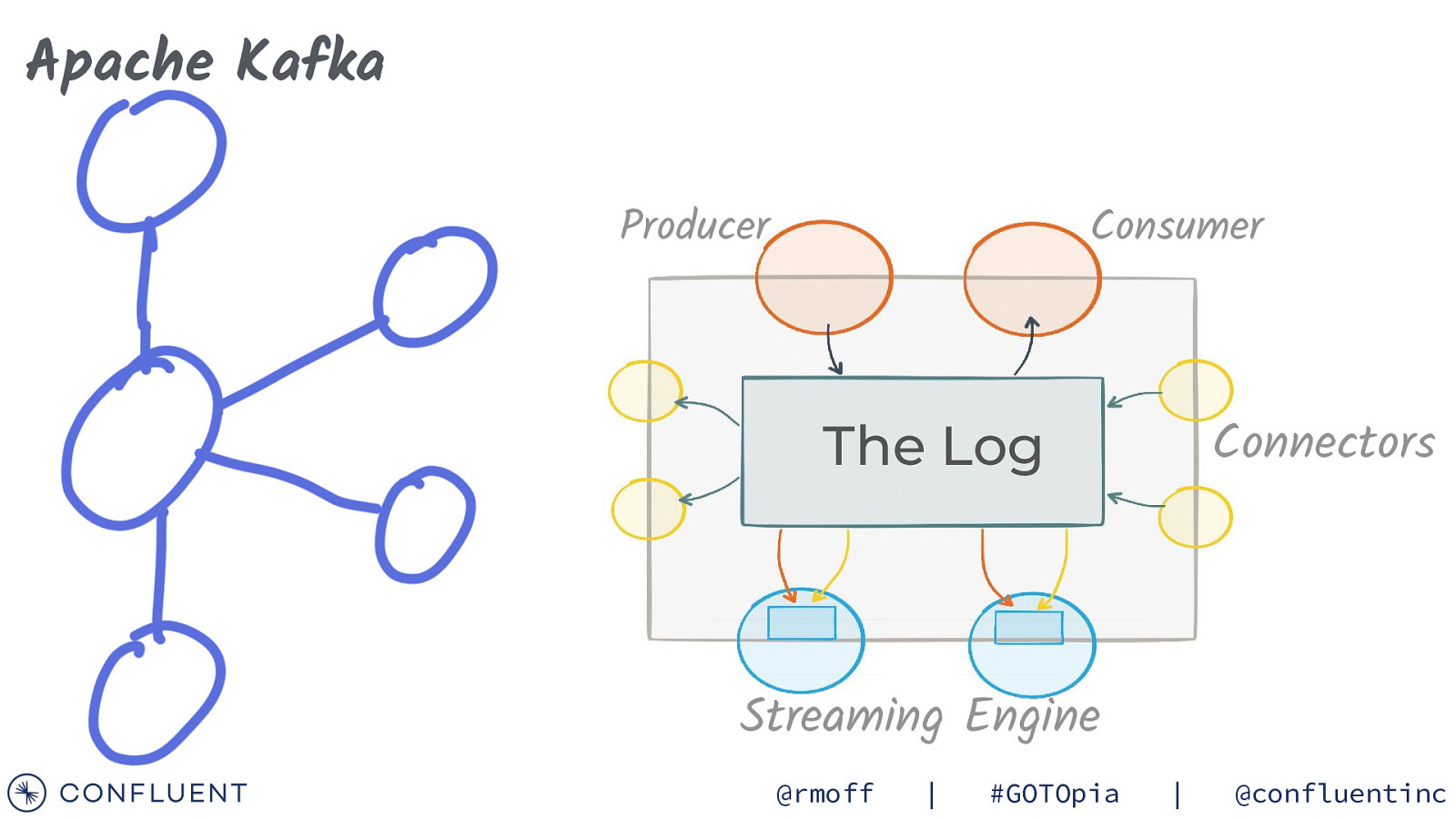
Apache Kafka Producer Consumer Connectors The Log Streaming Engine @rmoff | #GOTOpia | @confluentinc
Slide 133
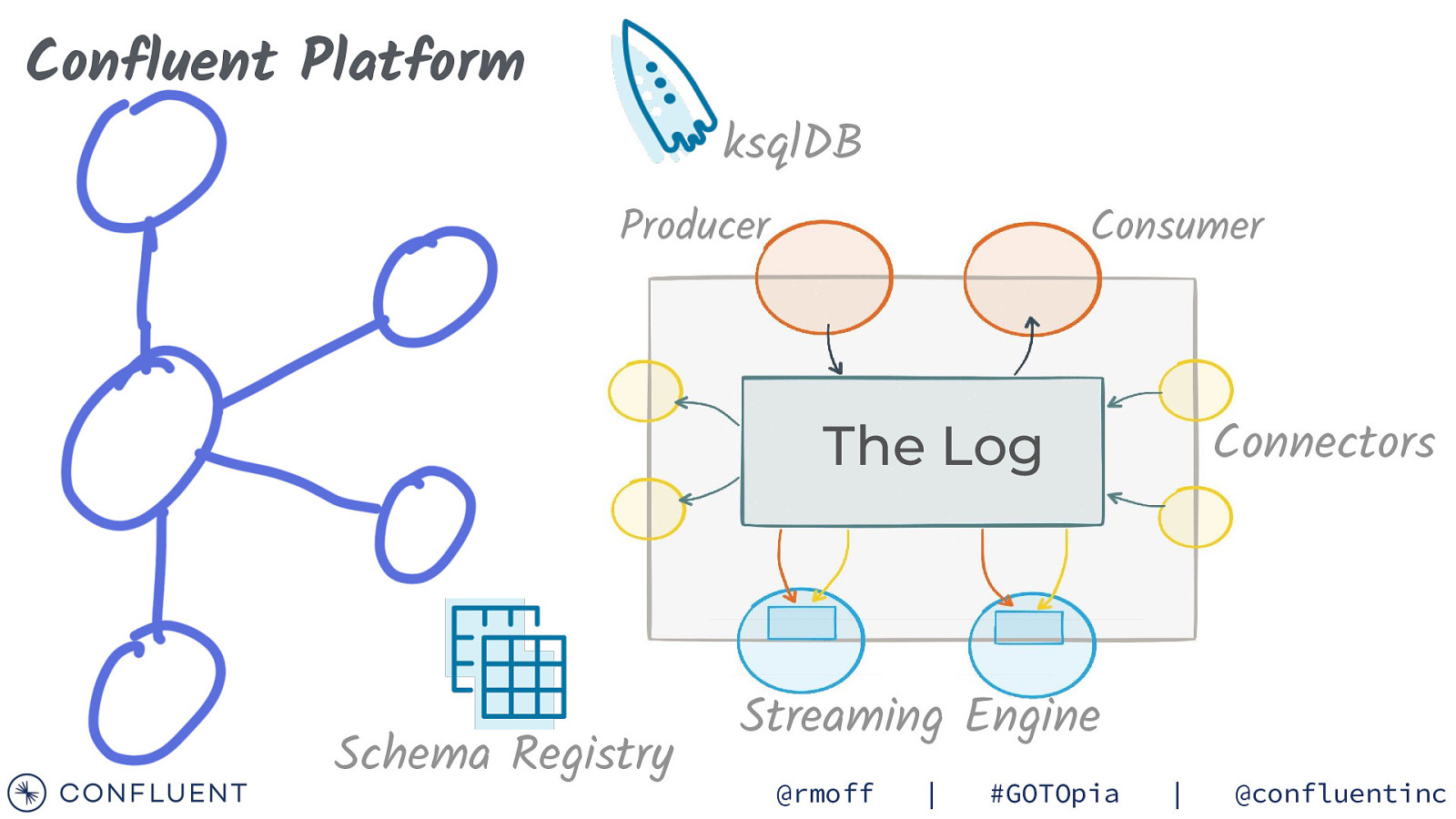
Confluent Platform ksqlDB Producer Consumer Connectors The Log Schema Registry Streaming Engine @rmoff | #GOTOpia | @confluentinc
Slide 134
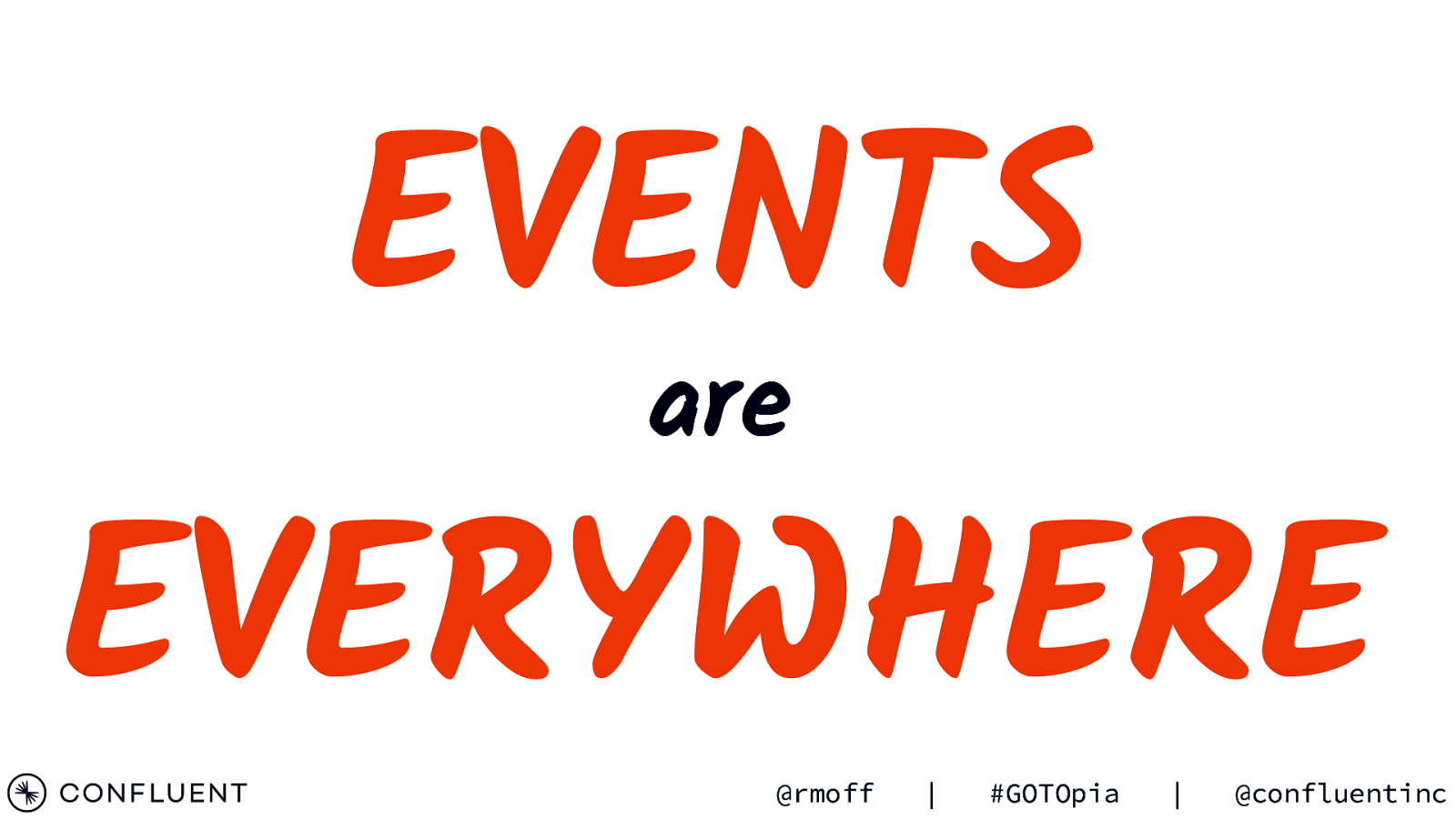
EVENTS are EVERYWHERE @rmoff | #GOTOpia | @confluentinc
Slide 135

EVENTS y r e v ^ are POWERFUL @rmoff | #GOTOpia | @confluentinc
Slide 136

Standby for resource links… @rmoff | #GOTOpia | @confluentinc
Slide 137
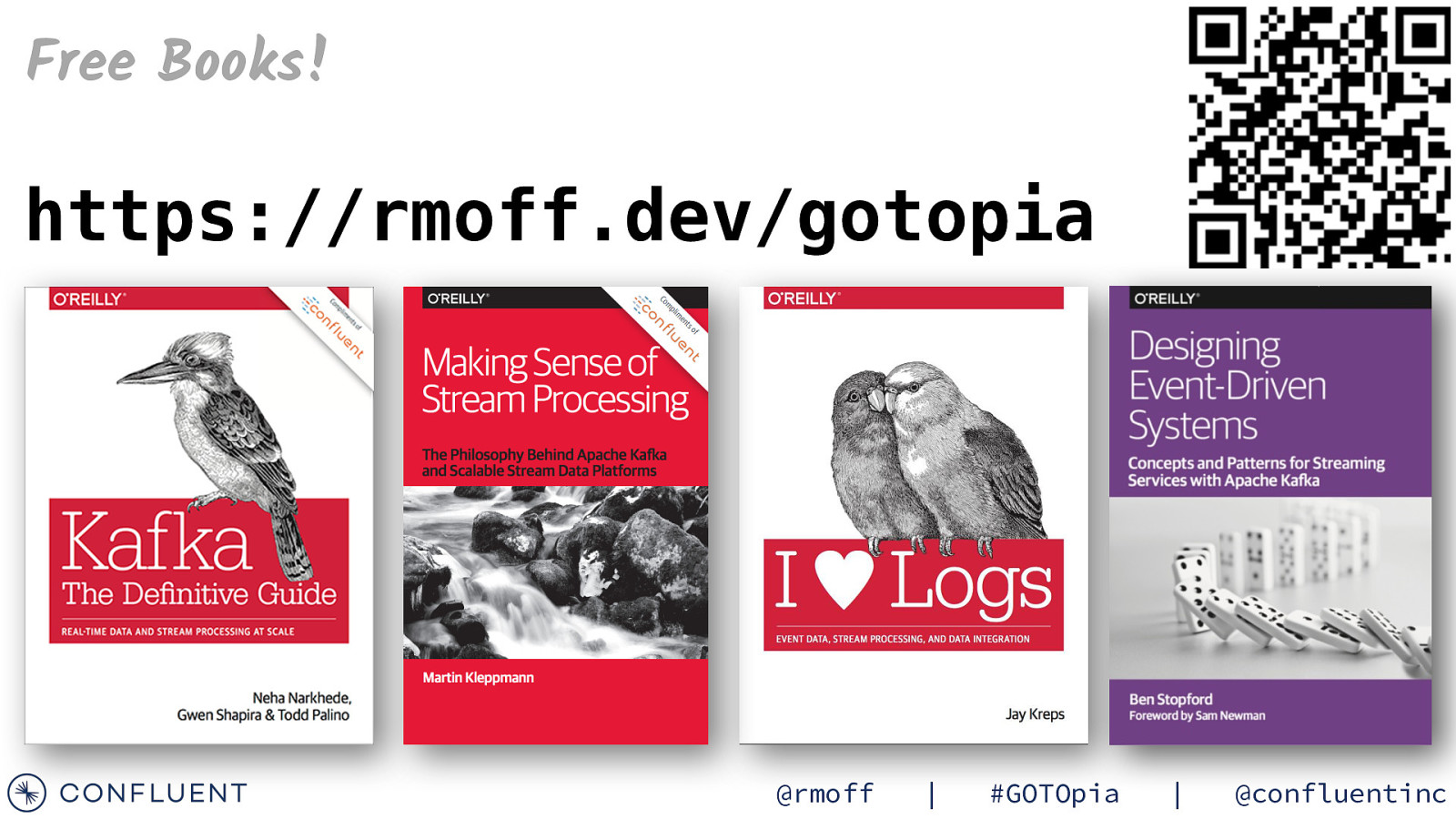
Free Books! https://rmoff.dev/gotopia @rmoff | #GOTOpia | @confluentinc
Slide 138
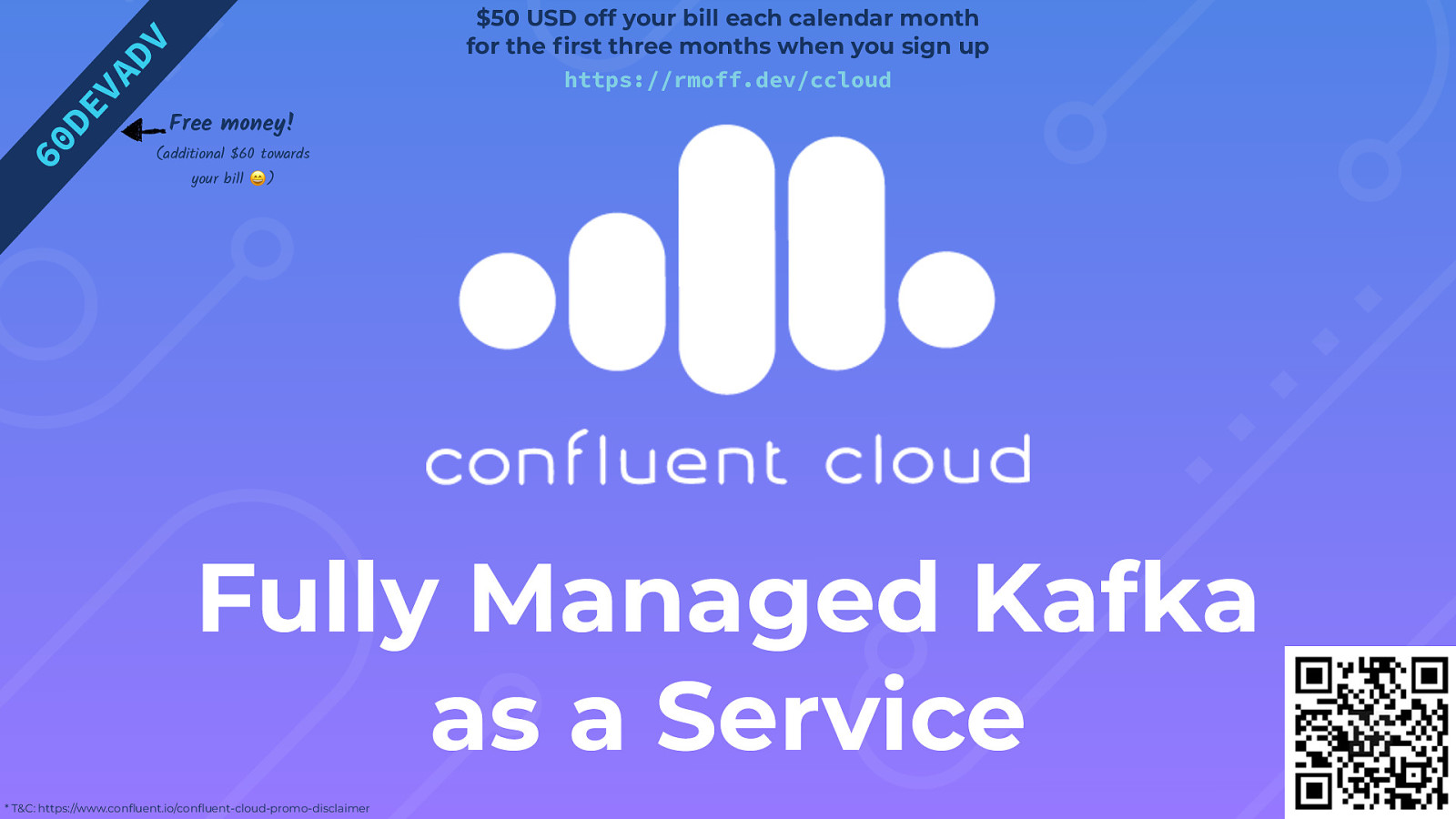
60 DE VA DV $50 USD off your bill each calendar month for the first three months when you sign up https://rmoff.dev/ccloud Free money! (additional $60 towards your bill % ) Fully Managed Kafka as a Service * T&C: https://www.confluent.io/confluent-cloud-promo-disclaimer
Slide 139
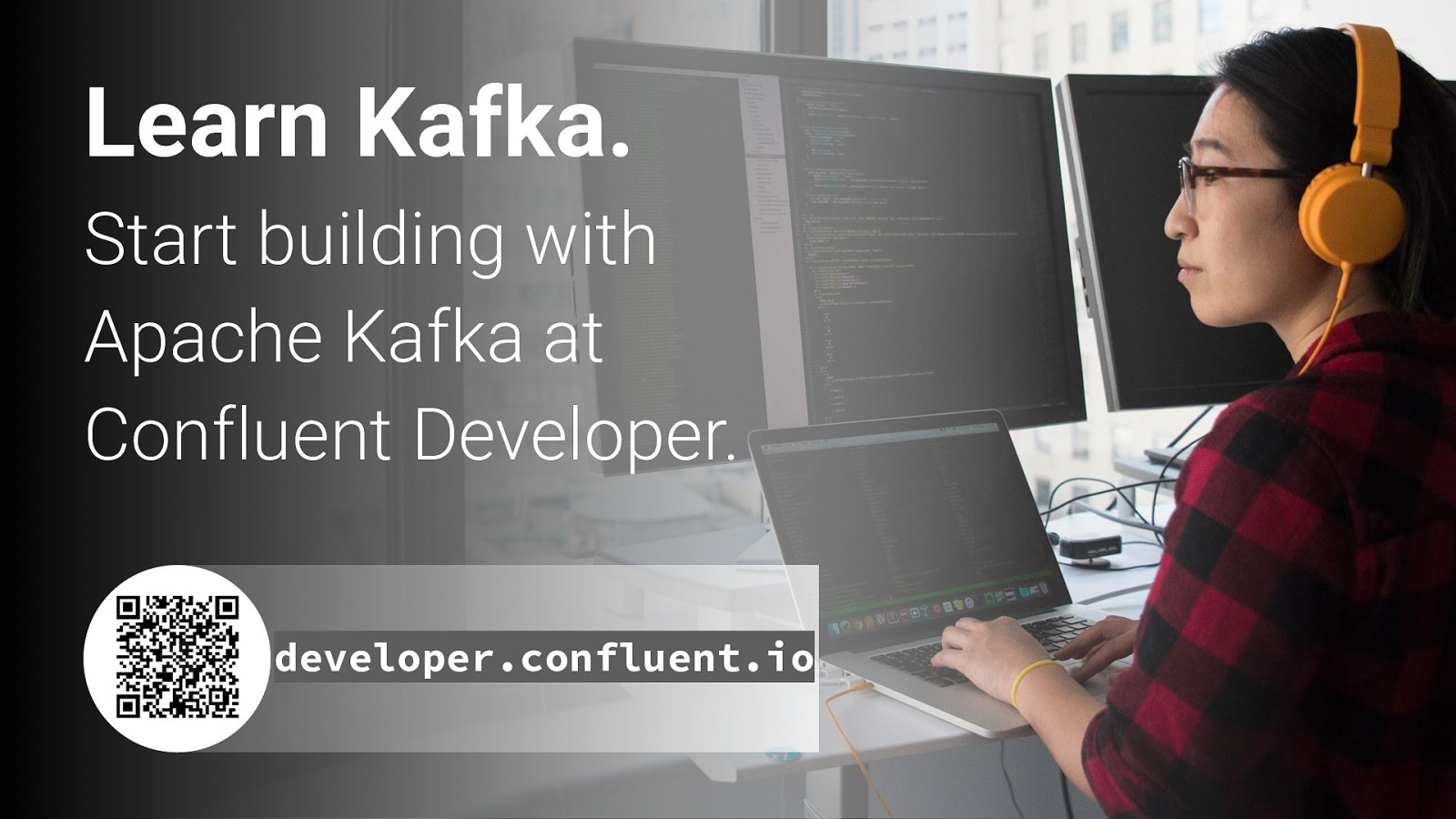
Learn Kafka. Start building with Apache Kafka at Confluent Developer. developer.confluent.io
Slide 140
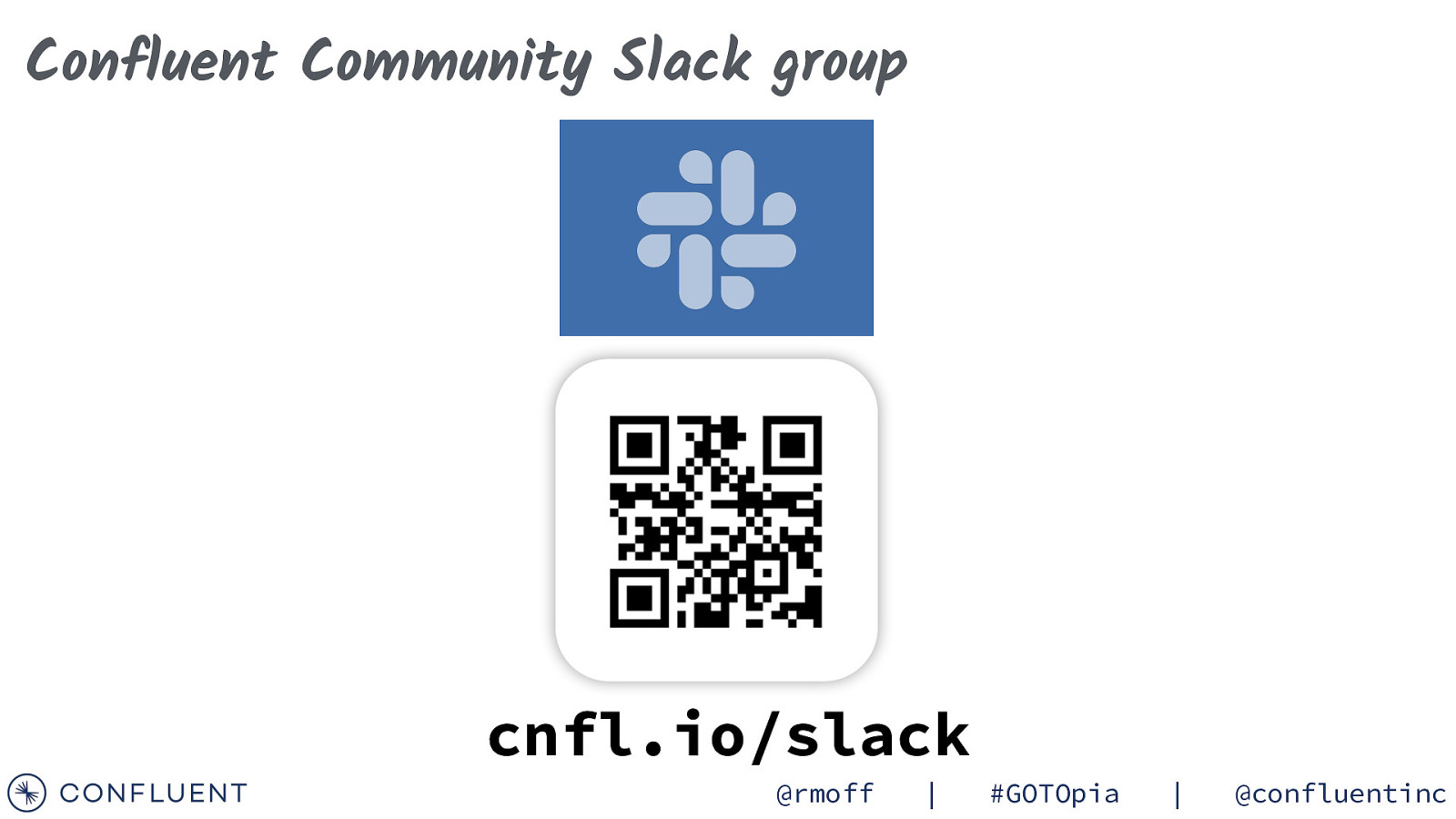
Confluent Community Slack group cnfl.io/slack @rmoff | #GOTOpia | @confluentinc
Slide 141
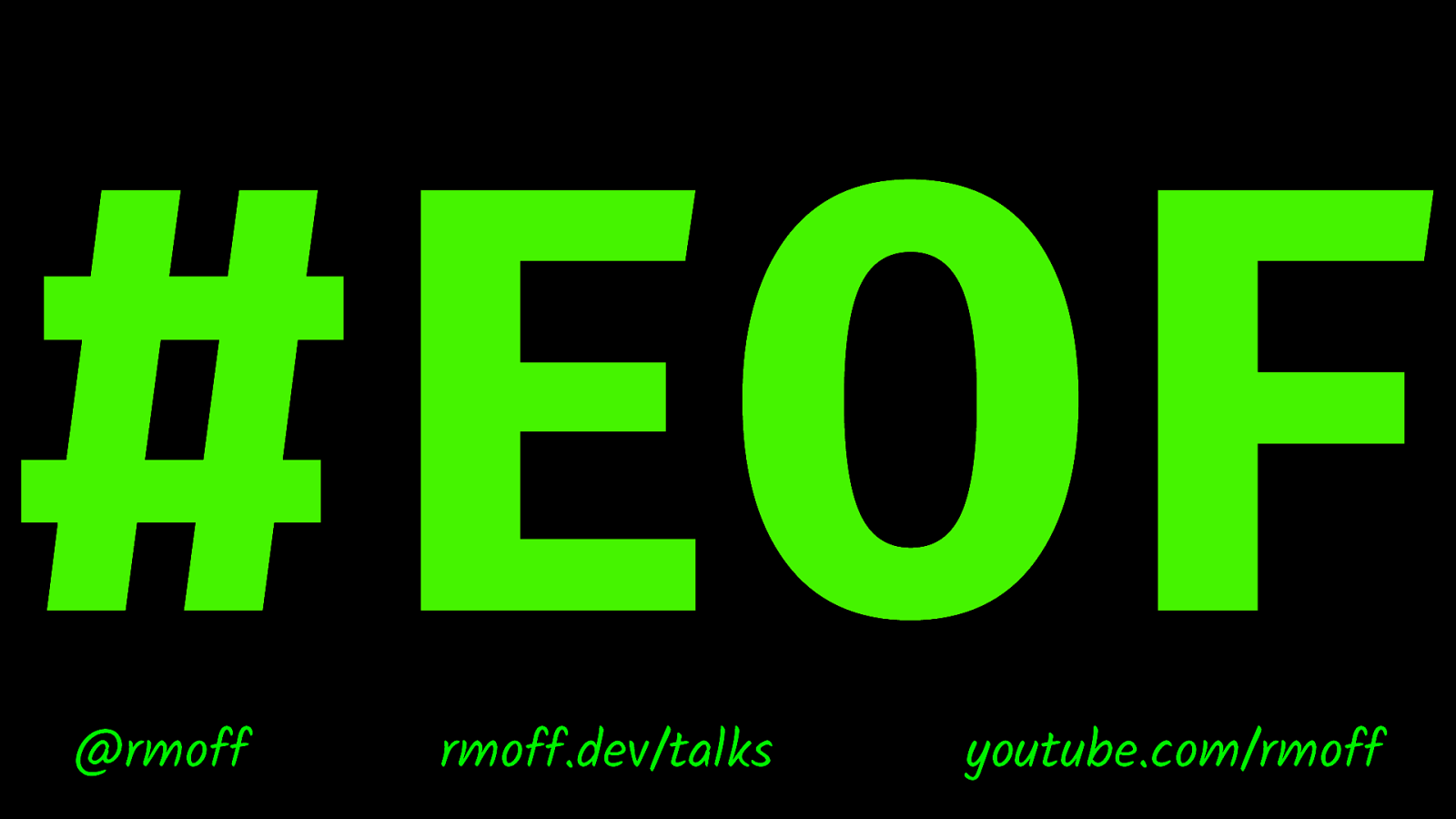
#EOF @rmoff rmoff.dev/talks youtube.com/rmoff